Notícias do Mercado
-
23:57
NZD/USD struggles to defend recovery past 0.6200 amid mixed options market signals
NZD/USD treads water around 0.6215-20 amid early Thursday, following its rebound from a three-week low. In doing so, the Kiwi pair struggles for clear directions, while justifying the mixed options market signals, after snapping a two-day losing streak on Wednesday.
That said, a one-month risk reversal (RR) of the NZD/USD price, a gauge of the spread between the call and put options, printed a mild daily gain to +0.070 by the end of Wednesday’s North American session. With that, the daily RR marked the first positive print in three.
However, the weekly RR still snaps the four-week uptrend with a -0.035 figure at the latest.
It should be noted, though, that the monthly options market signals are well in support of the NZD/USD bulls as the RR prints positive figures for the third consecutive month so far, up to 0.015 by the press time.
Also read: NZD/USD rebounds on risk-on sentiment amidst mixed US inflation data
-
23:50
AUD/JPY Price Analysis: Limited upside expected as Australia employment data looms
- AUD/JPY prints five day winning streak, prints mild gain of late.
- Upbeat MACD signals, sustained bounce off three-week-old support favor buyers.
- Multiple hurdles towards the north, downbeat expectations from Aussie employment report prod bulls.
- Bears need validation from 88.45 and Australia jobs data to retake control.
AUD/JPY portrays mild gains around 89.20 as bulls keep the reins for the fifth consecutive day ahead of Australia’s monthly employment report, up for publishing on early Thursday.
In doing so, the cross-currency pair extends the previous week’s rebound from an upward-sloping support line from March 24, as well as the 21-DMA. Adding strength to the upside bias are the bullish MACD signals.
However, a likely increase in the Aussie Unemployment Rate, as well as downbeat Employment Change, for March joins multiple technical hurdles towards the north to challenge the AUD/JPY buyers.
Among them, a six-week-old descending resistance line near 89.50 and the 90.00 round figure are the initial challenges for the pair buyers.
Following that, the previous support line from late December 2020, around 90.25, will precede a seven-month-old descending trend line, close to 91.10 at the latest, to act as the last defense of the AUD/JPY bears.
Meanwhile, pullback moves remain elusive unless the quote stays beyond the 88.45 support confluence comprising the 21-DMA and a three-week-long rising trend line.
In a case where AUD/JPY bears manage to conquer the 88.45 support, multiple rest-points near 87.40-35 and 87.00 may prod the downside moves before highlighting the latest bottom of around 86.05 for the sellers.
AUD/JPY: Daily chart
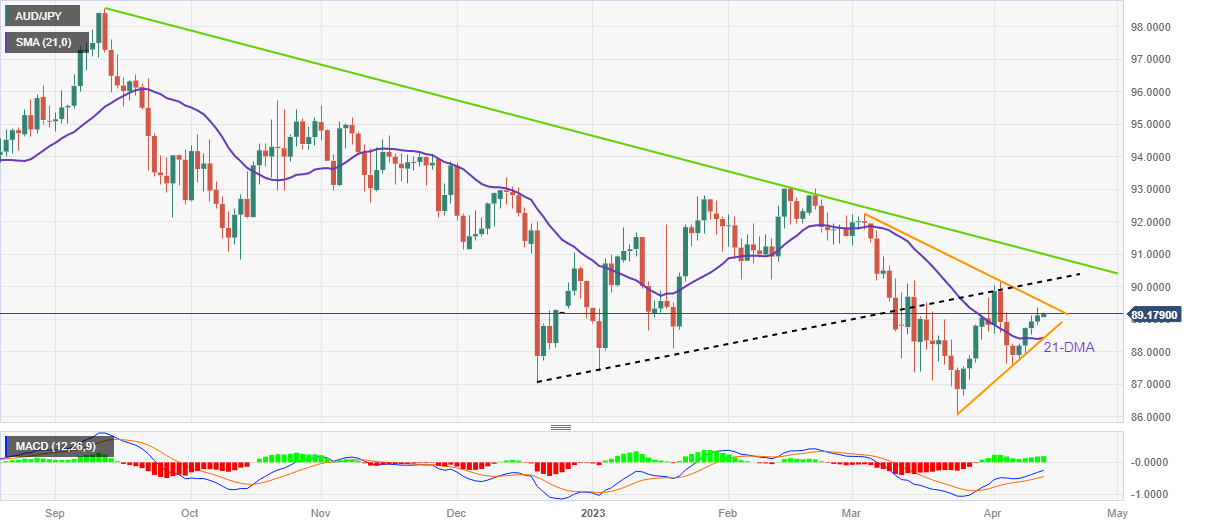
Trend: Limited upside expected
-
23:35
USD/CAD looks vulnerable around 1.3440 as Fed to pause rates sooner, oil above $83.00
- USD/CAD is struggling to keep its auction around 1.3440 as USD Index is eyeing more losses.
- Fed Daly believes that the central bank is at a point where a rate hike in each meeting is not necessary.
- The Canadian Dollar has registered a three-day losing streak despite the BoC Governor keeping interest rates steady at 4.5%.
The USD/CAD pair is struggling to sustain its auction around 1.3440 in the early Tokyo session. Downside bets for the Loonie asset are escalating as softened US Inflation and dovish Federal Reserve (Fed) policymakers are weighing heavily on the US Dollar. Also, higher oil prices amid weakness in the US Dollar are supporting the Canadian Dollar.
The USD Index is declining toward its two-month low of 100.82 as the United States Consumer Price Index (CPI) has softened beyond expectations to 5.0% due to weaker gasoline prices. However, core inflation rebounded to 5.6% but remains akin to consensus due to persistent rent prices.
The release of the Fed minutes for the March monetary policy meeting conveys that a 50 basis point (bp) rate hike move was in consideration but didn’t get life due to banking turmoil. Also, Fed policymakers are expecting a mild recession at the end of the year. Fears of mild recession joined anxiety over US quarterly earnings and weighed on S&P500. Meanwhile, the 500-US stocks basket futures have generated more losses in early Asia, portraying an asset-specific action.
San Francisco Fed Bank President Mary Daly believes that the Fed is at a point where a rate hike in each meeting is not necessary. However, she refrained from forecasting the end of a tightening cycle.
The Canadian Dollar has registered a three-day losing streak despite Bank of Canada (BoC) Governor Tiff Macklem keeping interest rates steady at 4.5%. BoC’s Governing Council considered the likelihood that rates may need to remain restrictive for longer to return inflation to the 2% target, however, the tight labor market could force the central bank to reconsider its neutral policy stance.
On the oil front, oil prices have shifted their business above the critical resistance of $83.00 amid weakness in the US Dollar and softening inflation expectations. The oil price ignored a mild build-up of inventories by 0.597 million barrels against the expectations of a drawdown for the week ending April 07, as reported by US Energy Information Administration (EIA). It is worth noting that Canada is the leading exporter of oil to the US and higher oil prices would strengthen the Canadian Dollar.
-
23:27
Silver Price Analysis: XAG/USD cracks to new YTD high as bulls' eye $26.00
- Once XAG/USD reaches around $25.60, it could aim toward $26.00.
- XAG/USD could fall to $25.00 if a retracement below $25.13 occurs.
Silver price rose to fresh 12-month highs at around $25.66 after cracking the previous YTD high of $25.13, as inflation data from the United States (US) decelerated. Also, the latest FOMC meeting minutes provided clues that the Fed considered pausing its tightening cycle. Therefore, the USD Dollar weakened and bolstered the white metal. At the time of writing, the XAG/USD is trading at $25.47 as the Asian session begins.
XAG/USD Price Action
Following a brief period of consolidation, the XAG/USD broke the top of the range capped at $25.13 and rallied above $25.60. While the XAG/USD aims to test $26.00, it may consolidate between $25.45-$25.60 before reaching April 2022 high at $25.87. Subsequently, it could target the $26.00 figure. Contrarily, if XAG/USD retraces below $25.13, it would exacerbate a fall toward $25.00. Downside risks remain at an April 6 low of $24.63, followed by a dip toward the 20-day Exponential Moving Average (EMA) at $24.06.
Oscillators-wise, the Relative Strength Index (RSI) is in overbought territory, suggesting that Silver could consolidate or reverse its course before posing a threat to the $26.00 mark. Conversely, the Rate of Change (RoC) suggests buyers are losing momentum; therefore, a pullback is expected.
XAG/USD Daily Chart

XAG/USD Technical Levels
-
23:25
Japan FinMin Suzuki: G7 policy guidance on supply chains is not necessarily aimed specifically at China
“Group of Seven (G7) policy guidance on supply chains is not necessarily aimed specifically at china,” said Japan’s Finance Minister (FinMin) Shunichi Suzuki said on early Thursday.
Additional comments
-
23:16
GBP/USD bulls attack 1.2500 as US inflation, FOMC Minutes signal Fed policy pivot, UK data dump eyed
- GBP/USD grinds near the highest levels in 10 months, marked in the last week.
- US inflation, Core inflation numbers favor Fed’s 0.25% rate hike in May.
- FOMC Minutes offered no new information and keeps US Dollar, yields depressed.
- More clues of US inflation, UK monthly GDP and Industrial Production eyed for clear directions.
GBP/USD remains sidelined around 1.2480-85 during the early hours of Thursday’s Asian session, following a two-day winning streak to refresh the weekly top. In doing so, the Cable pair portrays the trader’s cautious mood ahead of the UK’s data dump for March while cheering the downbeat signals from the US of late.
An absence of any major positive surprise from the US inflation and the latest Federal Open Market Committee (FOMC) Monetary Policy Meeting exerted downside pressure on the US Treasury bond yields and the US Dollar, which in turn favored the GBP/USD bears. In doing so, the Cable pair also cheered upbeat comments from Bank of England (BoE) Governor Andrew Bailey while paying little heed to Brexit chatters as US President Joe Biden travels to Northern Ireland.
On Wednesday, the US inflation measure, per the Consumer Price Index (CPI), dropped to the lowest level since May 2021, to 5.0% YoY in March from 6.0% prior and versus 5.2% market forecasts. However, the annual Core CPI, namely the CPI ex Food & Energy, improved to 5.6% YoY during the said month while matching forecasts and surpassing 5.5% prior.
On the other hand, FOMC Minutes signaled that the expectations for rate hikes were scaled back due to the turmoil in the banking sector, which in turn offered no fresh information and raised doubts on the hawkish Fed moves, apart from May’s 0.25% rate hike. “Several Federal Reserve policymakers last month considered pausing interest rate increases after the failure of two regional banks and a forecast from Fed staff that banking sector stress would tip the economy into recession,” mentioned Reuters.
Following the data, San Francisco Federal Reserve Bank President Mary Daly said that they had good news on inflation but added that she doesn't want to forecast the end of the tightening cycle. On the same line, Richmond Federal Reserve President Thomas Barkin said on Tuesday, in an interview with CNBC, that inflation certainly has peaked but warned that there are still ways to go.
With this, the US Dollar Index (DXY) dropped to a one-week low and the Treasury bond yields marked their first daily loss of the week. Further, the CME’s FedWatch Tool suggests a nearly 65% chance of the Fed’s 0.25% rate hike in May versus 72% marked the previous day.
At home, BoE’s Bailey ruled out fears of a banking crisis while adding, “Shouldn't `aim off' rates decision due to crisis.”
On a different page, US President Biden’s Northern Ireland visit promoted the Brexit deal but refrained from any major signals of the US-UK trade pact. “U.S. President Joe Biden said on Wednesday a deal between Britain and the European Union to simplify post-Brexit trade rules would lead to significant investment in Northern Ireland from "scores" of major U.S. companies,” said Reuters.
Looking forward, GBP/USD traders should pay attention to the UK’s monthly Gross Domestic Product (GDP) and Industrial Production (IP) data for immediate directions amid receding hawkish bets of the BoE’s next move. Following that, the US Producer Price Index (PPI) will be eyed for a clear guide.
Technical analysis
Unless providing a daily close below a three-week-old ascending support line, GBP/USD is well set to challenge May 2022 top surrounding 1.2665.
-
23:02
EUR/USD kisses 1.1000 as US Inflation softens further, focus shifts to US Retail Sales
- EUR/USD has touched the psychological resistance of 1.1000 as US Inflation has softened as expected.
- S&P500 settled Wednesday’s session on a negative note as the minutes from the Fed’s March meeting have flagged recession fears.
- Monthly Retail Sales data would contract by 0.4%, at a similar pace to the prior contraction.
The EUR/USD pair has kissed the psychological resistance of 1.1000 in the early Asian session for the first time in more than two months. The major currency pair is facing barricades in extending its rally above the same, however, the upside is still solid as the United States inflation has softened as expected by the market participants.
The US Dollar Index (DXY) has dropped perpendicularly to near 101.53 on hopes that the Federal Reserve (Fed) would consider an early pause in the policy-tightening spell. The USD Index is expected to slip further below its weekly low of 101.42.
Meanwhile, S&P500 settled Wednesday’s session on a negative note as the minutes from the Federal Reserve’s March meeting have flagged recession fears for later this year. Fed policymakers expect a mild recession led by the banking crisis. Also, anxiety over the quarterly result season forced investors to take caution. The market has turned asset-specific where equities are expected to witness sheer volatility while risk-sensitive currencies are getting traction.
As expected, headline inflation accelerated by merely 0.1% as weaker oil prices offered gasoline at cheaper rates. The annual headline inflation softened beyond expectations to 5% from the prior release of 6%. However, core inflation that strips off oil and food prices accelerated to 5.6% vs. 5.5% released earlier. The catalyst that fueled blood into core inflation is the persistent rent prices.
However, Fed policymakers are confident that US inflation will soften further to the middle of 3% by this year and will go down to desired levels in 2024.
Going forward, Friday’s US Retail Sales data will be keenly watched. Monthly Retail Sales data would contract by 0.4%, at a similar pace to the prior contraction. This might bolster the need to pause rates by Fed chair Jerome Powell.
On the Eurozone front, more rate hikes from the European Central Bank (ECB) are in the pipeline as inflation is extremely stubborn. Shortage of labor has been a major constraint of persistent inflation and now higher oil prices could elevate inflation further.
-
23:00
Bank Of Japan Governor Kazuo Ueda: Consumer inflation is currently around 3% but likely to slow ahead
Bank Of Japan Governor Kazuo Ueda told G7 that the BoJ will continue monetary easing until the price target is stable and sustainably achieved.
He said that Japan's consumer inflation is currently around 3% but likely to slow ahead.
More to come...
-
22:57
AUD/USD Price Analysis: Bears eye a break of key support structures
- AUD/USD´s 0.6720s on the upside are key.
- A break of 0.6670s and then the 0.6650s opens risk to the 0.6620s as the last defense for a significant run lower.
The Australian Dollar was not far from four-month lows touched in March in mid-week trade while investors weigh the monetary policy outlook domestically and abroad and US-China tensions. However, AUD/USD is poised bearish on the chart as the following technical top-down analysis illustrates:
AUD/USD H1 chart prior analysis

It was stated in the prior analysis, that AUD/USD had pulled back into the neckline of the M-formation in a 50% mean reversion of the hourly impulse. This area was anticipated to act as resistance ´´and lead to an eventual break of the trendline support and then 0.6650.´´
AUD/USD updates
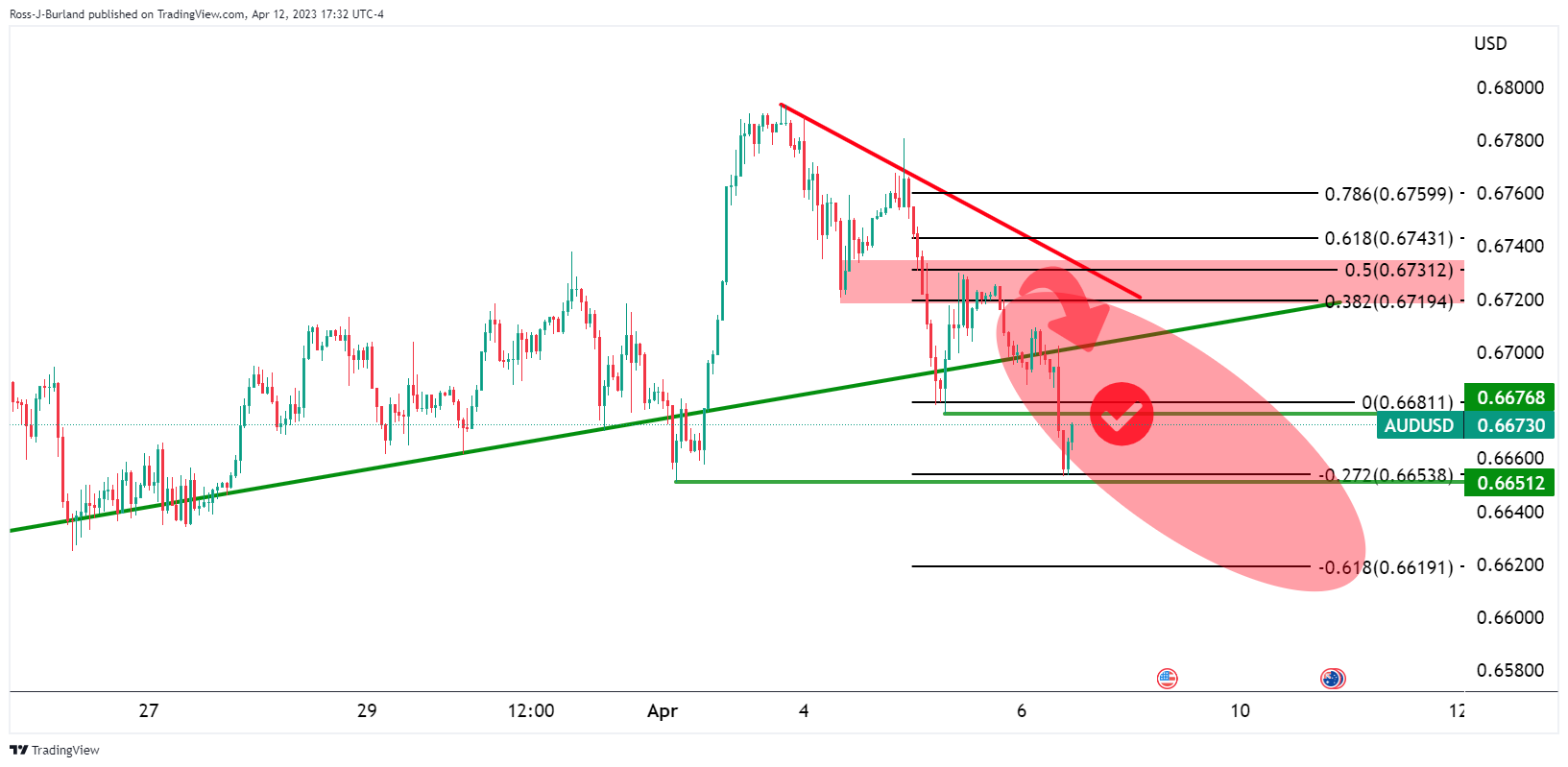
This particular analysis played out as illustrated above. Over the course of the days, the price continued lower:
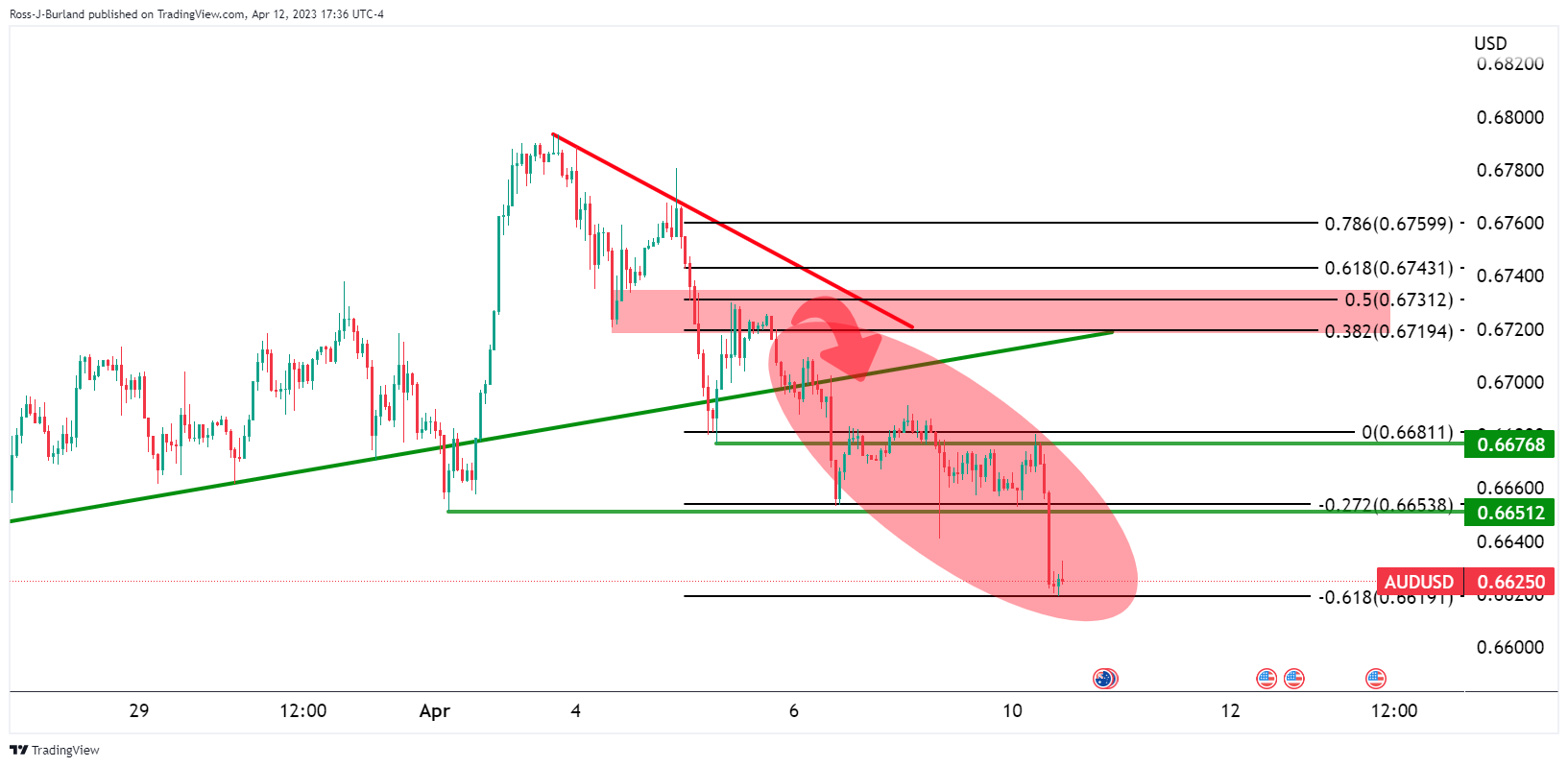
This is significant in relation to the overall bearish thesis as outlined in the prior analysis on the daily chart:
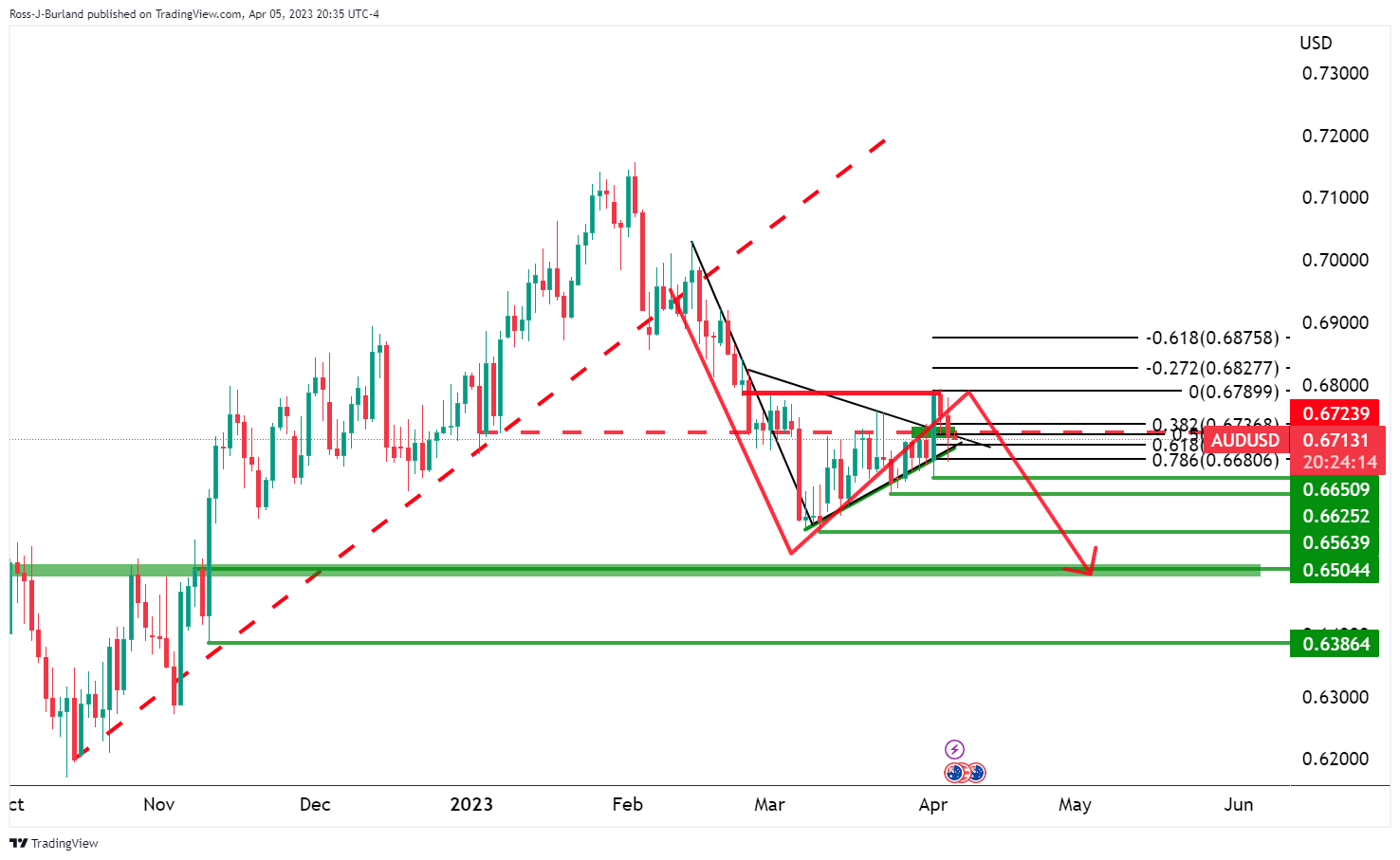
AUD/USD daily chart update

Cleaning up the chart a touch and zooming in, we can see when drawing the Fibonacci measurement tool on the correction´s length, the -272% ratio aligns with the targetted 0.6500s.
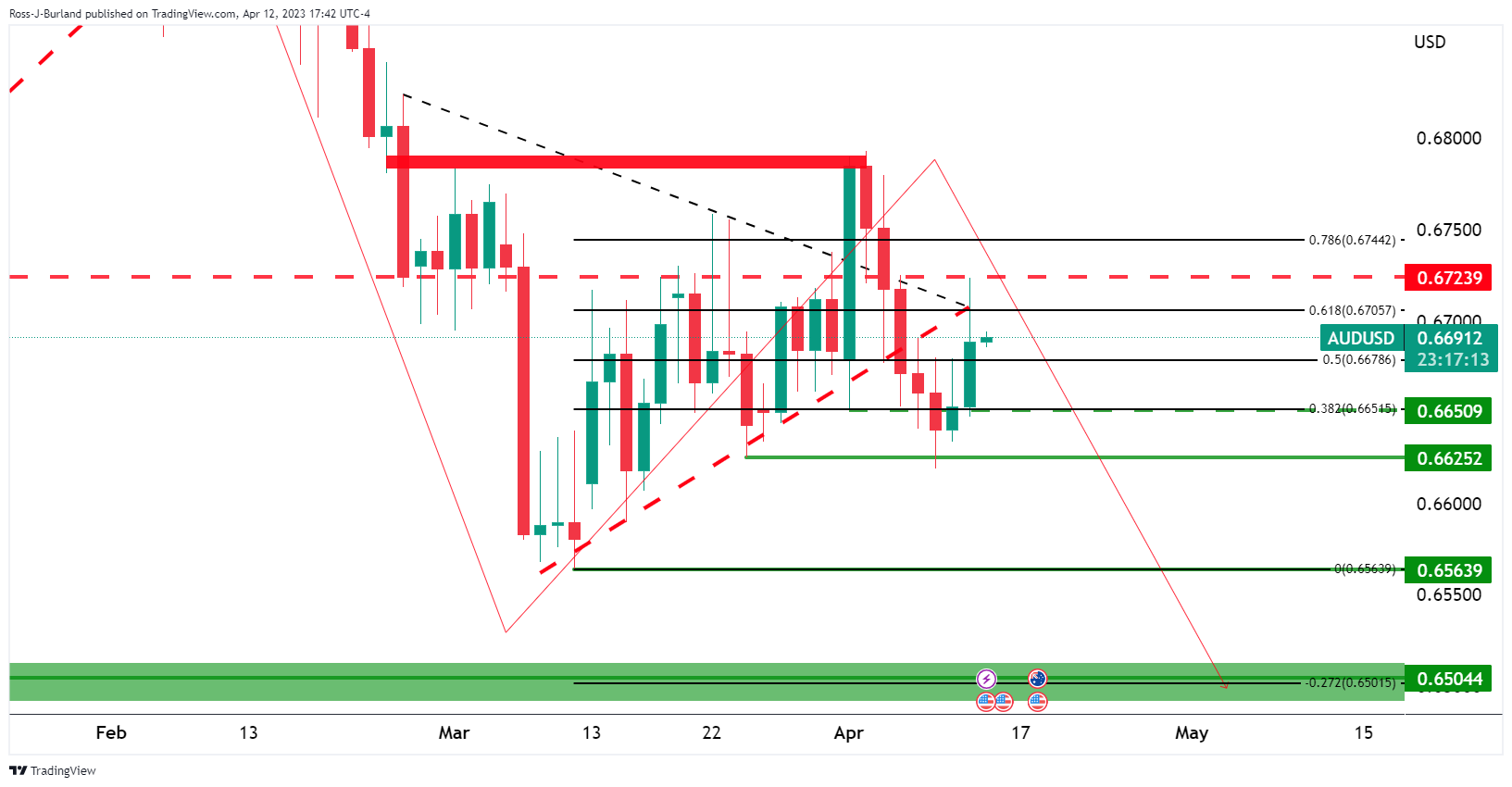
Cleaning up the chart even more so, we can see the break of the support structure, pull back into a 61.8% resistance area, and restest of the counter trendline. A premium has been given to the bears looking to get in on the break of structure who are targeting a significant downside breakout of the geometrical pattern towards 0.6500:

AUD/USD H4 chart
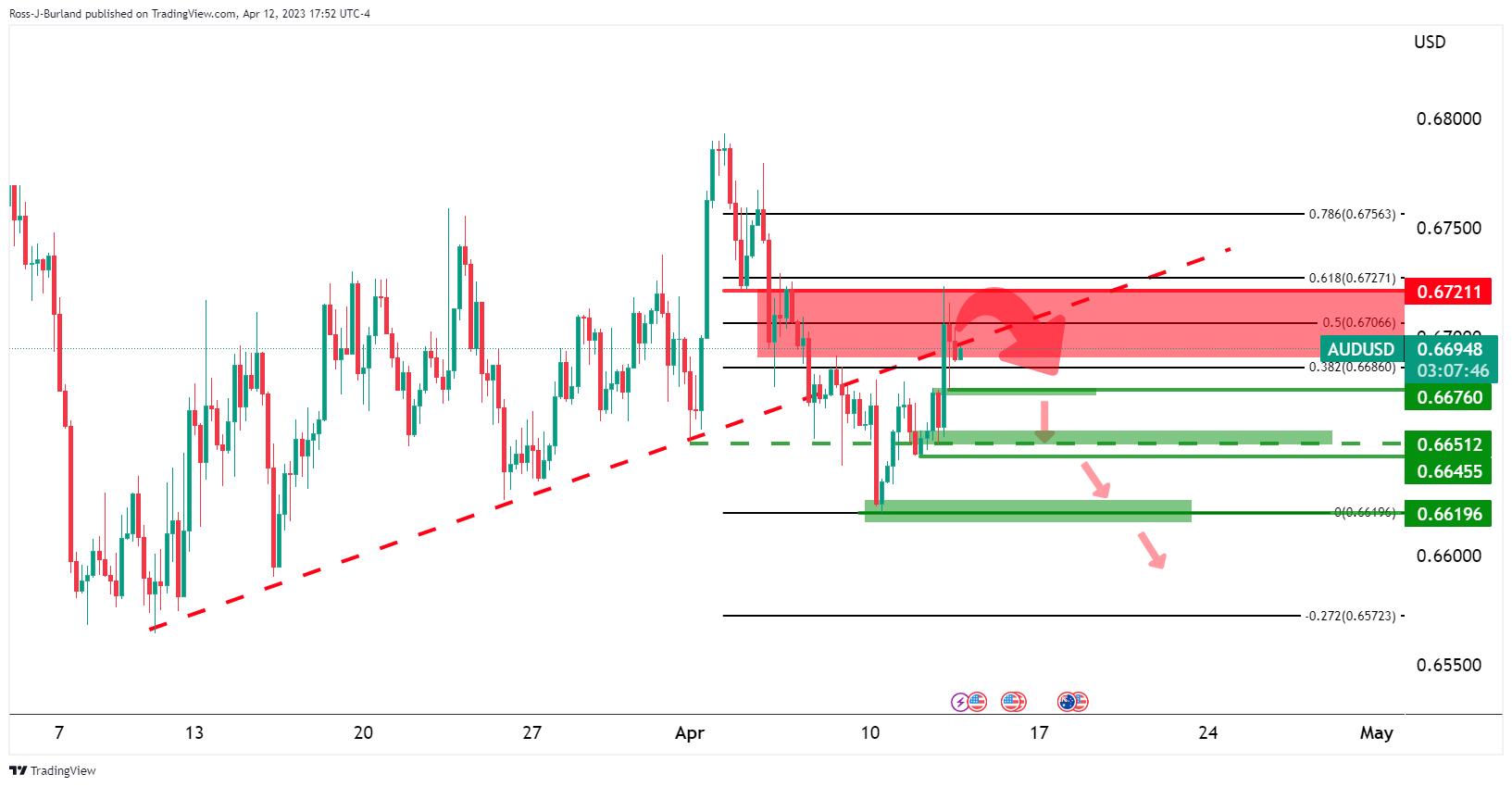
Meanwhile, there are a number of key levels and market structures as illustrated on the 4-hour chart. 0.6720 on the upside is key and should this fend off the bulls, then a break of the 0.6670s and then the 0.6650s opens risk to the 0.6620s as the last defense for a significant run lower towards 0.6550 and 0.6500 thereafter.
-
22:45
USD/CHF Price Analysis: Hits fresh lows on the back of weak US Dollar, with bears lurking around 0.8950
- USD/CHF dropped on mixed news about the United States economy, which weakened the US Dollar.
- USD/CHF bears lurk as support levels threaten to crumble below 0.8950.
- Bulls remain hopeful as resistance levels are within striking distance, at around 0.9000.
The USD/CHF tumbled to 22-fresh monthly lows at 0.8943 after fundamental news from the United States (US) weakened the US Dollar (USD), even though chances for another rate hike by the Fed remained high. As the Asian session begins, the USD/CHF Is trading at 0.8956, printing minuscule gains of 0.03%.
USD/CHF Price Action
Following a break of a support trendline drawn from March 13 lows around 0.9070, the USD/CHF exacerbated its fall and broke to a new YTD low since the first day of April. Although the pair braced for the 0.9050 area, it posted two days of 60-plus pips back-to-back losses, dragging prices to levels last seen since June 2021.
If USD/CHF breaks below 0.8950, that would expose the 2023 YTD low at 0.8943. Once cleared, the USD/CHF could tumble toward the June 9 low at 0.8926, followed by the 0.8900 figure. On the other hand, if the USD/CHF reclaims the 0.9000 mark, upside risks lie at the April 12 high at 0.9035, followed by 0.9050, ahead of testing the 20-day EMA at 0.9106.
USD/CHF Daily Chart

USD/CHF Technical
-
22:07
Gold Price Forecast: XAU/USD bulls take on resistance, eye $2,050
- Gold price bulls stay in the market on a weaker US Dollar.
- Federal Reserve bets are driving the Gold price with US CPI and FOMC minutes digested.
Gold price has been drawing its strength on Wednesday from a slide in the US Dollar and benchmark US yields as signs of cooling inflation bolstered bets that a pause in US rate increases was imminent. Gold price has traveled from a low of $2,001.22 to a high of $2,028.40 following both the latest US Consumer Price Index data and the minutes from the Federal Open Market Committee´s March 21-22 meeting whereby the rate hike was widely viewed as dovish.
Firstly, the Consumer Price Index (CPI) climbed 0.1% in March after advancing 0.4% in February, compared with a forecast of 0.2% gain in a Reuters poll. But in the 12 months through March, the core CPI gained 5.6%, after rising 5.5% on the same basis in February. That core measure strips out volatile food and energy prices and was posting a month-on-month gain of 0.4%.
Nevertheless, despite a hot core reading, Fed funds futures traders are pricing in 69% probability that the Fed will raise rates by an additional 25 basis points at its May 2-3 meeting, down from around 76% before the data. This is sending the US Dollar lower on the day and into technical support and has benefitted the Gold price as higher rates to tame rising price pressures have otherwise weighed on the non-yielding asset's appeal. Traders have positioned for one more hike in May followed by 2-to-1 bets of a pause in June.
´´While the miss on this morning's CPI report is giving the yellow metal a lift higher, the strong labour market trends and sticky core services inflation suggest a 25bp hike at the May FOMC meeting is still in the cards,´´ analysts at TD Securities have argued.
´´However, if the market increasingly feels the May hike could be the last of the cycle, with cut timing also top of mind, it could be the catalyst needed to see gold challenge the highs yet again. With that said, CTAs could add fuel to the fire with the next upside trigger sitting at $2,064,´´ the analysts added.
As for the Federal Reserve Open Market Committee minutes, they showed that the staff at the Committee are forecasting a mild recession later in 2023.
Key quotes from the FOMC minutes:
"Given their assessment of the potential economic effects of the recent banking-sector developments, the staff’s projection at the time of the March meeting included a mild recession starting later this year, with a recovery over the subsequent two years."
"In assessing the economic outlook, participants noted that since they met in February, data on inflation, employment, and economic activity generally came in stronger than expected. They also noted, however, that the developments in the banking sector that had occurred late in the intermeeting period affected their views of the economic and policy outlook and the uncertainty surrounding that outlook."
"Participants agreed that the labor market remained very tight."
"Some participants noted that given persistently high inflation and the strength of the recent economic data, they would have considered a 50 basis point increase in the target range to have been appropriate at this meeting in the absence of the recent developments in the banking sector. However, due to the potential for banking-sector developments to tighten financial conditions and to weigh on economic activity and inflation, they judged it prudent to increase the target range by a smaller increment at this meeting."
"Members concurred that the U.S. banking system is sound and resilient. They also agreed that recent developments were likely to result in tighter credit conditions for households and businesses and to weigh on economic activity, hiring, and inflation, but that the extent of these effects was uncertain. Members also concurred that they remained highly attentive to inflation risks."
Gold price technical analysis
Gold price H4 chart
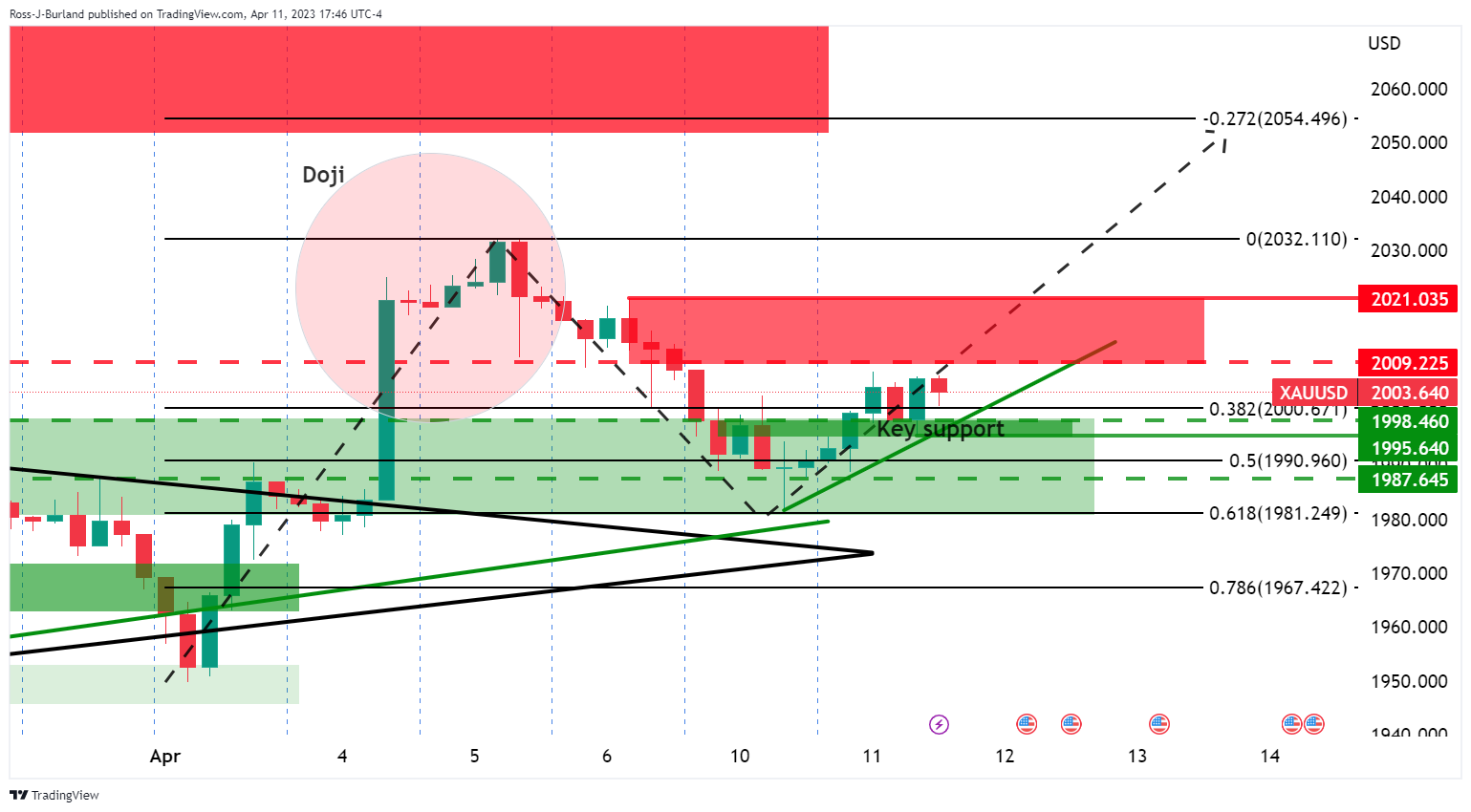
In the prior Gold price analysis, it was stated that ´´the Gold price four-hour chart shows that the bulls are holding the fort at key support with $2,010/20 now eyed as the next major Gold price resistance area guarding $2,050. ´´
Gold price update
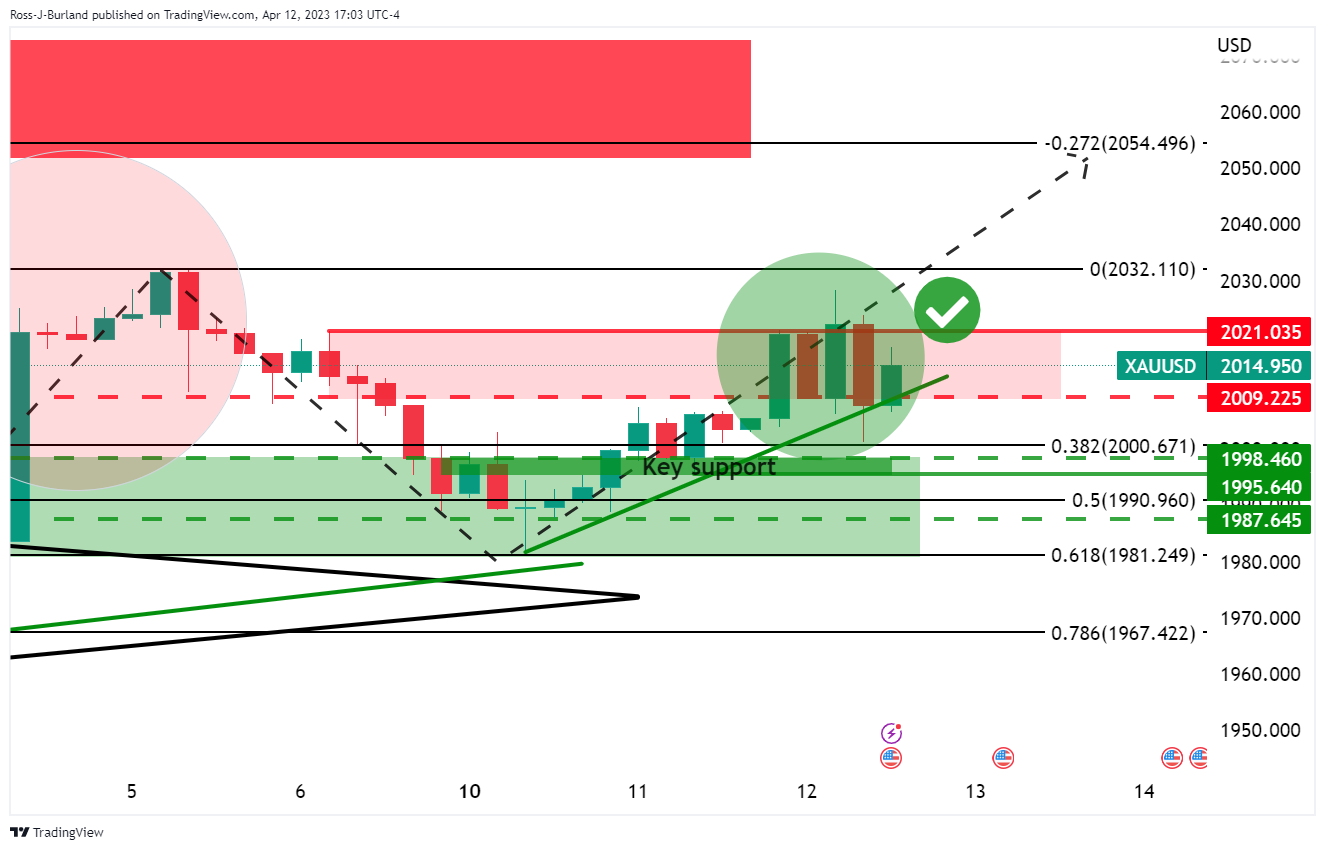
As illustrated, the price is making headway, but it is some way off still and is yet to crack the $2,020s resistance.
-
22:00
South Korea Import Price Growth (YoY) below expectations (-0.5%) in March: Actual (-6.9%)
-
22:00
South Korea Export Price Growth (YoY) registered at -6.4%, below expectations (-2.4%) in March
-
21:44
Forex Today: Dollar under pressure after US CPI, eyes on Australian employment
The March Australian Employment is the key report of the Asian session. China will release trade balance data. More US inflation data is coming on Thursday with the Producer Price Index. The US Dollar Index is under pressure and posted on Wednesday the lowest daily close since early February.
Here is what you need to know on Thursday, April 13:
The US Consumer Price Index (CPI) rose 0.1% in March, below the 0.3% increase expected, and the annual rate slowed to 5%, the smallest since May 2021. However, the Core rate edged higher from 5.5% to 5.6% YoY. Despite the persistence in Core inflation, the bond market continues to bet on rate cuts late in 2023 while still seeing some potential for another rate hike at the May FOMC meeting (the last one). The decline in US yields weighs on the US Dollar.
The US Dollar Index dropped to 101.50 and posted the lowest daily since February. More US inflation data is due on Thursday with the Producer Price Index. The weekly Jobless Claims report is also due.
EUR/USD jumped to the 1.1000 area but could not break above, while EUR/GBP rose above 0.8800. Expectations of more rate hikes from the European Central Bank (ECB) continue to offer support to the common currency.
GBP/USD gained ground for the second day in a row, and is back near the 1.2500 area, with a bullish outlook. UK GDP data and Industrial Production and Trade Balance are due on Thursday.
USD/JPY ended a positive streak and bottomed at 132.70. It rebounded during the American session above 133.00 but the short-term outlook remains bearish.
AUD/USD peaked at 0.6723 and then pulled back below 0.6700. Australia will release employment data on Thursday; market consensus is for an increase of 20,000 in jobs during March.
The Bank of Canada, as expected, kept interest rates unchanged at 4.5%, offering no significant changes in its forward guidance. BoC Governor Macklem said they are not forecasting a major contraction. He will speak again on Thursday at the International Monetary Fund Spring meetings. USD/CAD dropped for the second day in a row, falling below 1.3450, as it continues to move toward April lows.
NZD/USD rose modestly and retook 0.6200 as the Kiwi lags again. AUD/NZD rose above 1.0750, to weekly highs.
Bitcoin peaked above $30,500 after US CPI data but then pulled back, retreating to $29,800. Gold price peaked near $2,030 and then pulled back to $2,000 to end a volatile session around $2,015. Finally, silver broke decisively above $25.00.
Like this article? Help us with some feedback by answering this survey:
Rate this content -
20:36
NZD/USD rebounds on risk-on sentiment amidst mixed US inflation data
- NZD/USD advanced after the US CPI dipped, despite the core CPI remaining unchanged.
- FOMC minutes showed that the banking crisis in the US put into the table a pause in the tightening cycle.
- NZD/USD Price Analysis: The upside could be capped by daily EMAs, but once cleared, it can rally to 0.6300.
The NZD/USD made a U-turn and climbs after the latest FOMC minutes flashed that Fed officials were eyeing a pause on their tightening campaign. Also, US inflation figures mixed keep investors leaning towards a riskier asset, as shown by Wall Street about to finish with minimal gains. At the time of writing, the NZD/USD is trading at 0.6217.
FOMCs gave mixed signals, on a pause and a larger hike
During the recent Federal Reserve monetary policy meeting, officials discussed the possibility of holding rates unchanged following the failure of two regional banks. This decision was motivated by concerns that further tightening could cause financial stress. Despite this, participants agreed that the Fed’s measures had helped ease worries in the banking sector. These measures were similar to those the Bank of England took after the bond turmoil resulting from former Prime Minister Liz Truss’s mini-budget. Against this backdrop, the Fed’s latest meeting supported a 25 basis point rate hike.
Participants commented that inflation is still above the 2% goal and that inflation pressures were “abating at a pace sufficient to return inflation to 2% over time.” Some Fed members noted that they considered a 50-basis point increase if there was not a banking crisis. Furthermore, Fed policymakers observed, “that inflation remained much too high and that the labor market remained too tight.”
Earlier, an inflation report from the US revealed that headline CPI dropped from 6% in February to 5% annually. However, core inflation, which excludes food and energy, remained at 5.6% YoY, unchanged.
NZD/USD Technical Analysis
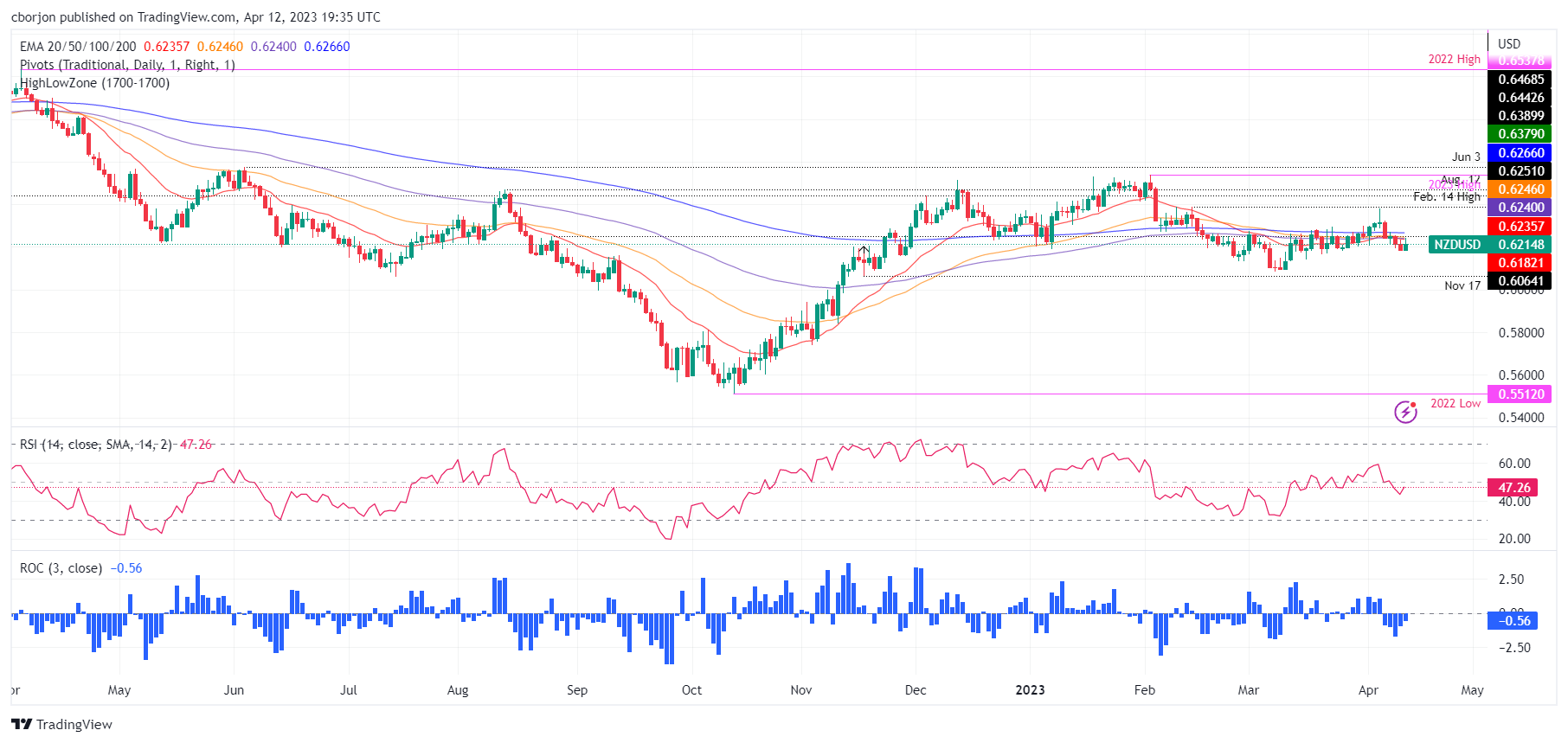
The NZD/USD snapped two days of consecutive losses and is forming a bullish engulfing candlestick pattern. Although the pattern suggests that further upside is expected, the NZD/USD needs to clear a busy resistance area, with the 20, 100, and 50-day EMAs, at 0.6235, 0.6240, and 0.6246, respectively. Once that area is cleared, the NZD/USD could rally toward the February 14 high at 0.6389.
-
20:32
BoE´s Bailey: Banking crisis `testing' institutional structures
Bank of England Governor Andrew Bailey earlier said in a speech on Wednesday to the Institute of International Finance in Washington where he is attending International Monetary Fund meetings that he did not believe ´´we face a systemic banking crisis."
In recent trade, further comments have crossed the wires:
We watch QT very carefully, we do not want it to have detrimental impact on markets.
We are not seeing any concerning signs in markets due to QT.
I do not see makings of a repeat of 2007-08 crisis.Shouldn't `aim off' rates decision due to crisis.
Will take financial conditions into account.
"I do not see the evidence that we've got on our hands what I would call ... the makings of a 2007/8 financial crisis. I really don't see that," Bailey said when asked about recent instability in the banking sector.
"The system is in a much more robust condition," he added.
GBP/USD update
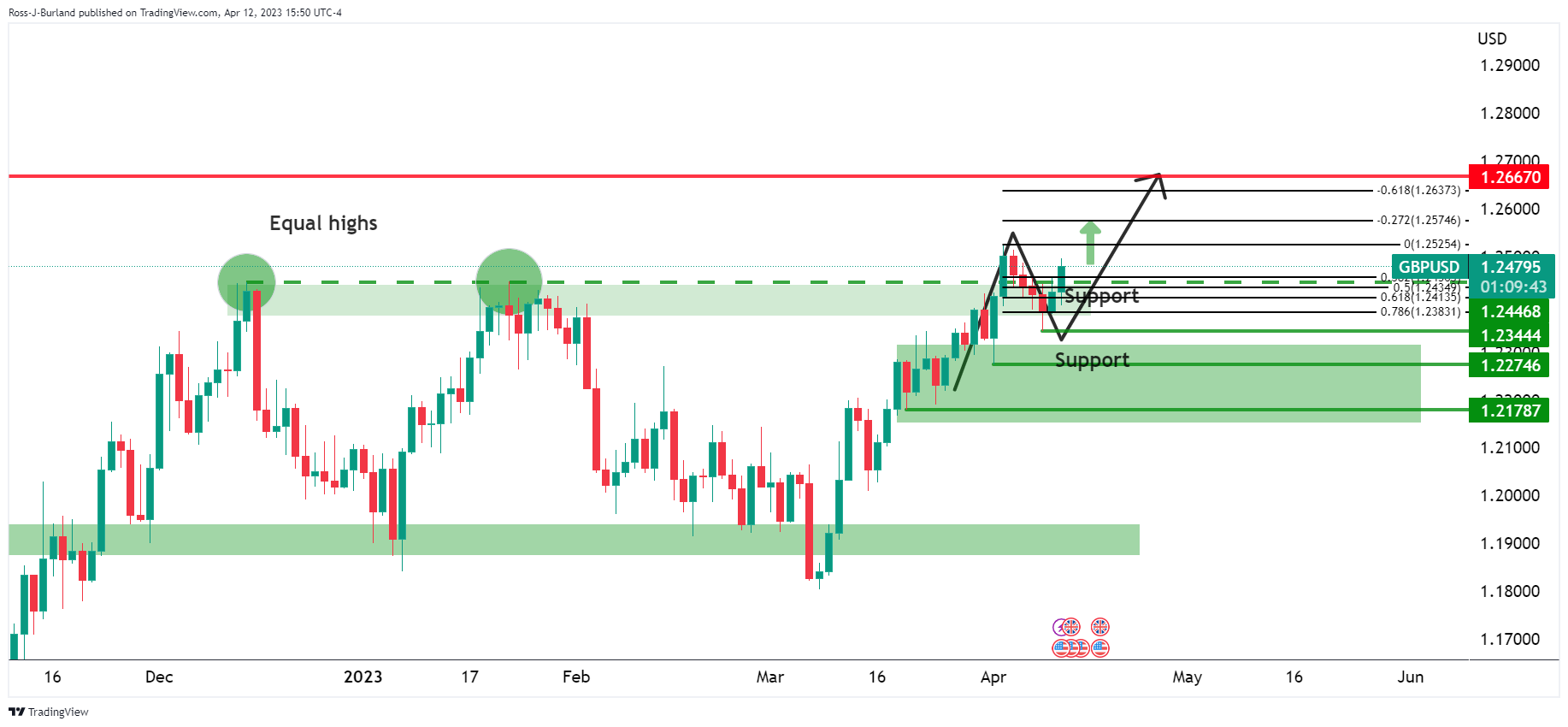
The Great British Pound rose towards $1.25 vs. the US dollar, moving closer to a ten-month high of $1.2525 touched on April 4th.
The Pound Sterling is getting a boost from the softer-than-expected US Consumer Price Index data that solidified that sentiment that the Federal Reserve will likely pause its rate hiking cycle soon.
-
20:26
USD/CAD Price Analysis: Bears are in the market and eye test of 1.3400
- USD/CAD bears lurking below a 38.2% Fibonacci retracement area.
- Bears look to the target area of the 1.3400s.
As per the prior USD/CAD analysis, USD/CAD Price Analysis: Bears are in control and target a break of daily lows, the price dropped accordingly and the bears are in the clear for a run to test 1.3400.
USD/CAD prior analysis
It was argued that ´´the bears will stay the course and break below the recent lows for a bearish extension.´´
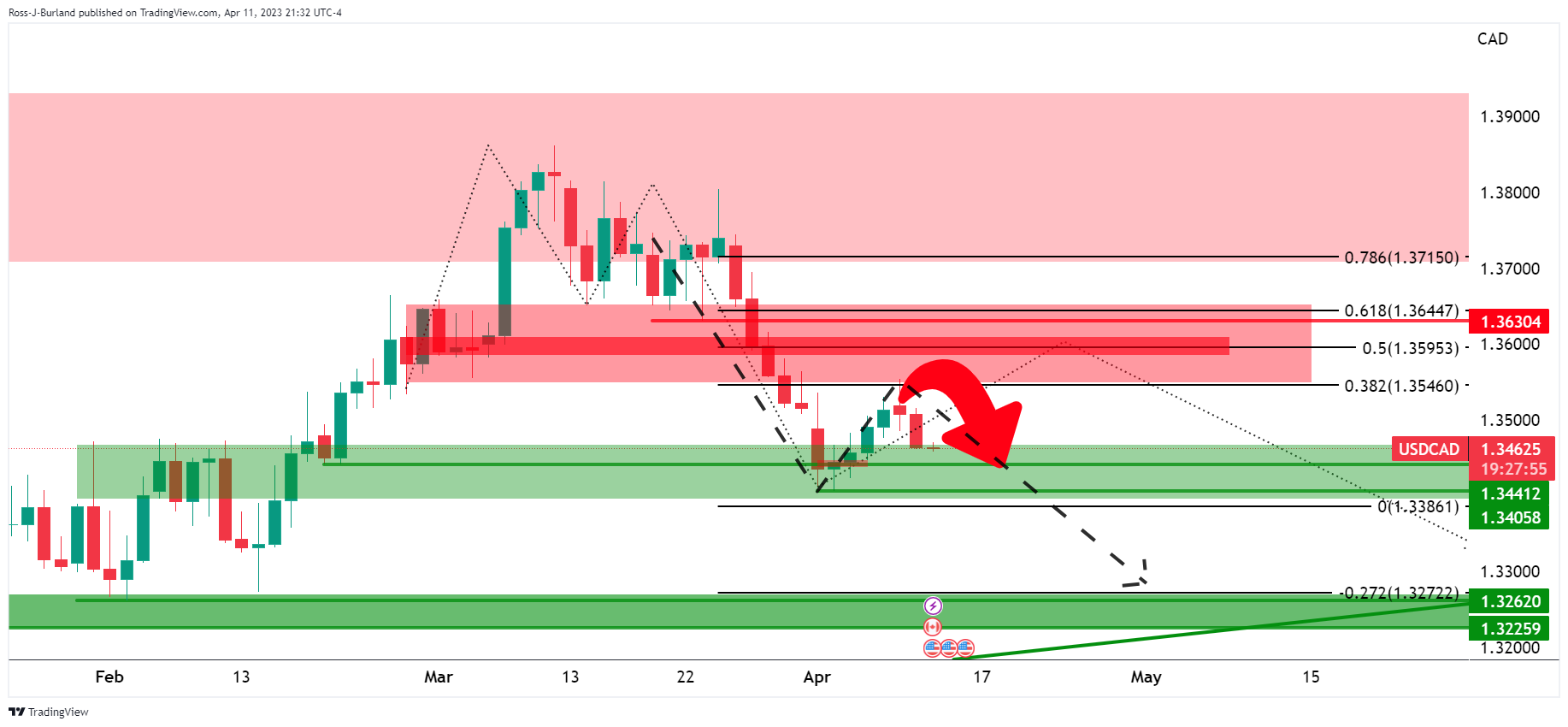
When moving down to the 4-hour chart, it was stated that ´´the price was meeting resistance very close to the daily 38.2% Fibonacci ... breaking 4-hour structure to the downside, as illustrated below:
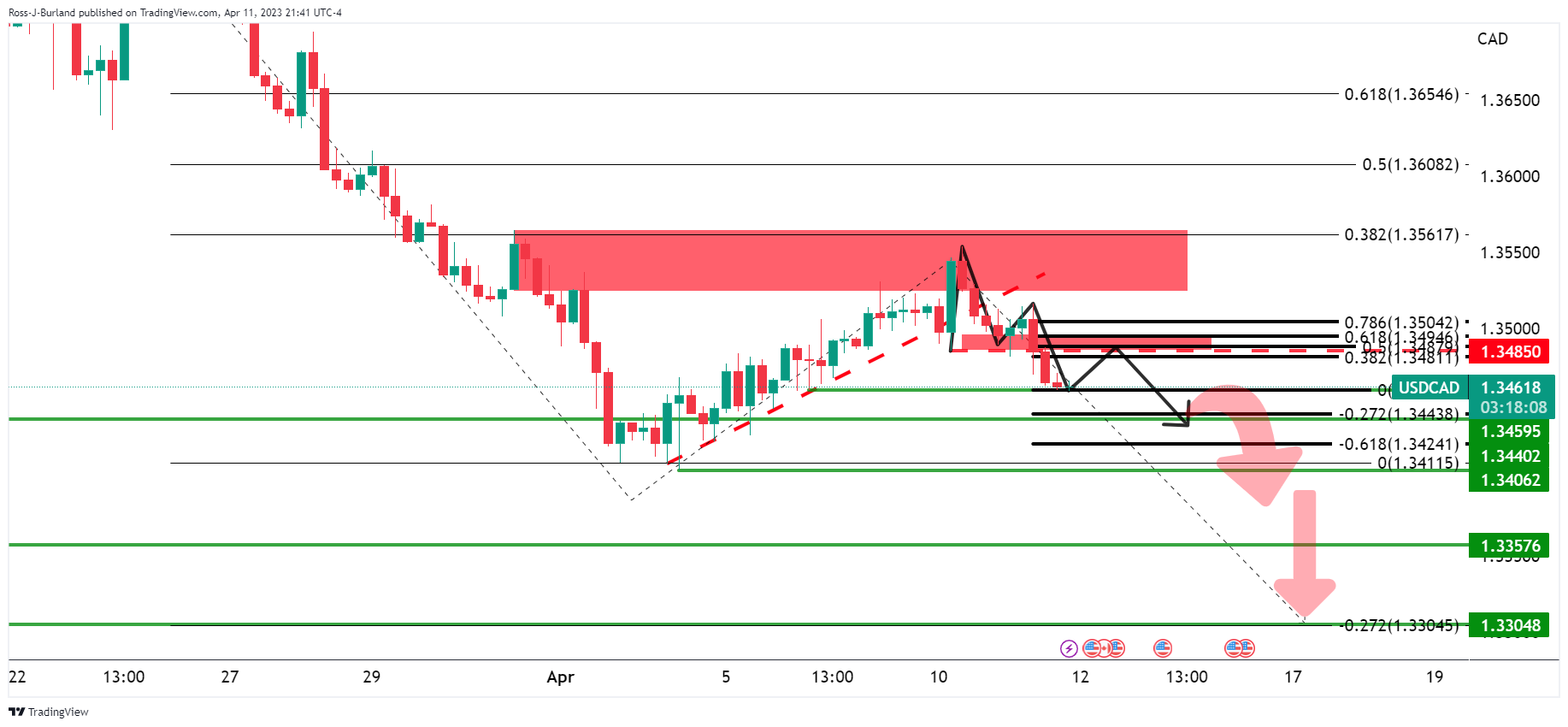
The price is on the back side of the prior 4-hour bullish trend/correction, and the M-formation can be regarded as a topping pattern. The neckline of the pattern might act as resistance on a pullback and lead to a subsequent lower low to target the 1.3440-50s.´´
It was also argued that a break below 1.3440 opened the risk to test 1.3400 prior lows and bearish extensions as per the weekly chart, as illustrated at the beginning of the prior top-down analysis.
USD/CAD update, live charts
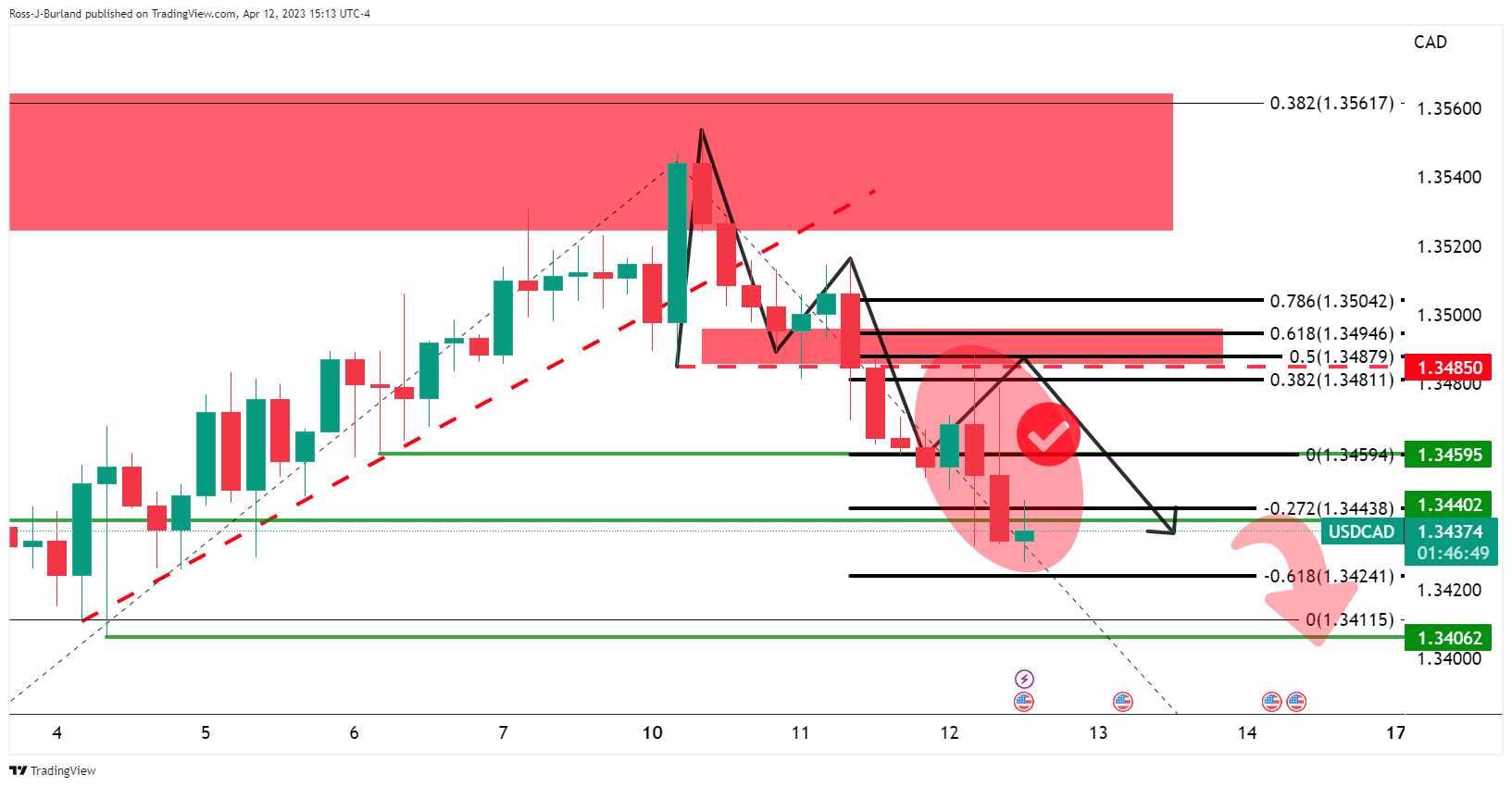
The price has come in a stone's throw´s distance from 1.3400, reaching a low of 1.3428 so far on the day. We are likely to see consolidation at this juncture, however.
USD/CAD H1 chart
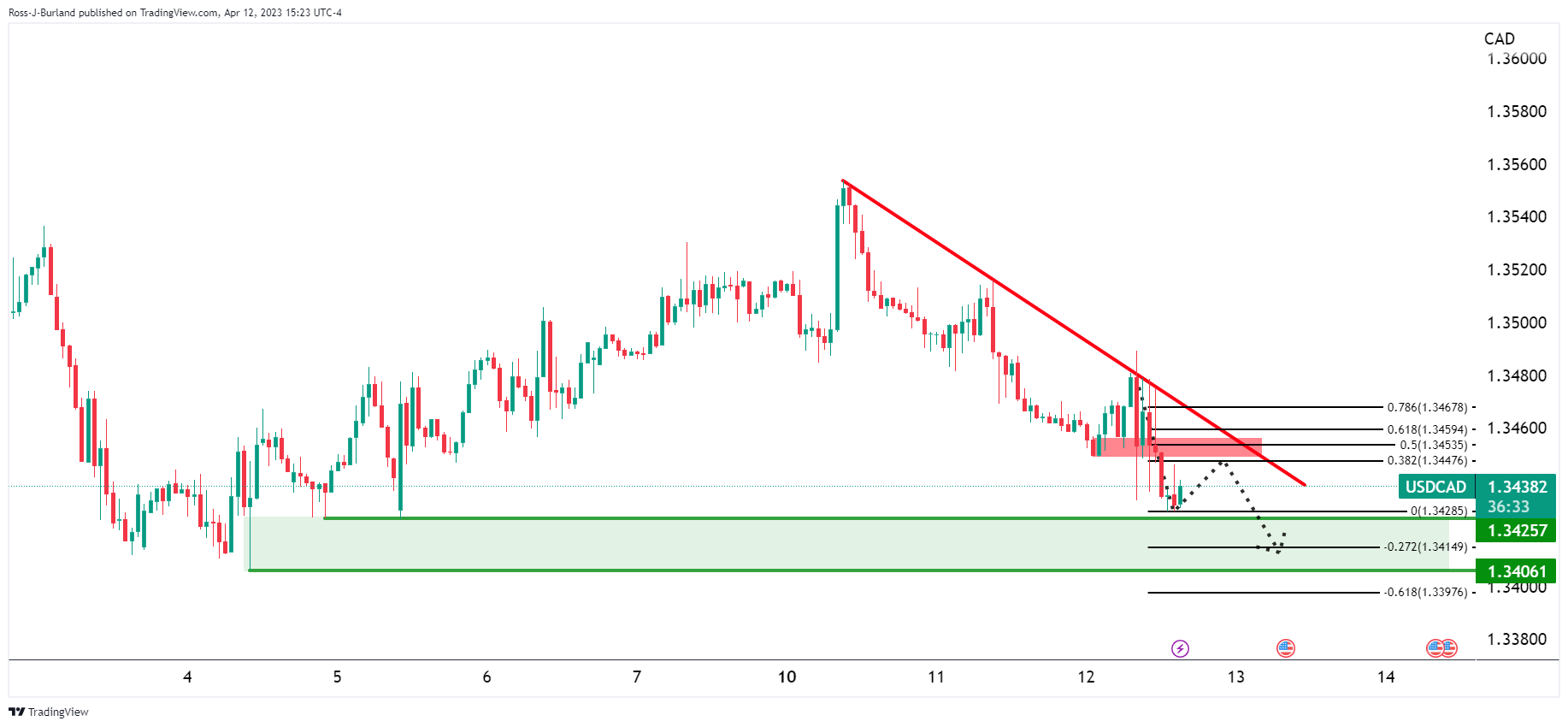
On the hourly chart, we can see that the price is being rejected at old support again. A 38.2% Fibonacci retracement aligns with prior support that would be expected to act as resistance on a restest while the bears commit to the front side of the bearish trend. This in turn could lead to an additional push lower and into the target area of the 1.3400s.
-
19:48
G7 reaffirms financial system is resilient
The G7 Communique has been reported to reaffirm that the financial system is resilient and it has reiterated the determination to maintain economic and financial stability. The .communique also states that central banks remain strongly committed to achieving price stability.
US Dollar update
At 101.50 DXY, the US Dollar was being pressured on Wednesday following the Consumer Price Index (CPI) that increased in March at a slower-than-expected pace and minute from the FOMC´s March 21-22 meeting whereby the rate hike was widely viewed as dovish. DXY has dropped from a high of 102.15 to a low of 101.449 on the day so far.
-
19:38
US: Budged deficit hits $1.1 trillion in first half of FY 2023
The US government recorded a $378 billion budget deficit in March. The Treasury Department informed that total receipts in March totalled $313 billion and outlays jumped to $691 billion.
In the same month last year, the deficit was $193 billion. So far, during the fiscal year 2023, the fiscal deficit is $1.1 trillion, 65% higher from a year earlier. The total deficit in FY 2022 was $1.3 trillion.
-
19:33
GBP/USD sees gains after Fed discussed a possible pause on its tightening cycle
- GBP/USD stays positive, aiming towards testing the 1.2500 figure.
- FOMC’s minutes showed that participants expected to raise 50 bps, but the banking crisis, put a possible pause on the table.
- US Inflation dipped, but core CPI remained at the prior’s month levels.
The GBP/USD advances after the release of the US Federal Reserve Open Market Committee (FOMC) minutes for the last meeting showed that officials discussed a possible pause in their tightening campaign. Therefore, the GBP/USD is trading at 1.2489 after hitting a daily low of 1.2398.
FOMC’s minutes flashed a pause and a 50 bps rate hike
In the latest Fed monetary policy reunion, officials considered a pause after the failure of two regional banks amidst fears that further tightening could cause financial stress. Nevertheless, those participants and others agreed that actions taken by the Fed calmed worries in the banking sector. The measures taken by the Fed were similar to those of the Bank of England (BoE) after the bond turmoil due to the ex-PM Liz Truss’s mini-budget, given the backdrop, that supported a 25 bps rate hike by the Fed at their latest meeting.
Participants commented that inflation is still above the 2% goal and that inflation pressures were “abating at a pace sufficient to return inflation to 2% over time.” Some Fed members noted that they considered a 50-basis point increase if there was not a banking crisis. Furthermore, Fed policymakers observed, “that inflation remained much too high and that the labor market remained too tight.”
Earlier, an inflation report from the US revealed that headline CPI dropped from 6% in February to 5% annually. However, core inflation, which excludes food and energy, remained at 5.6% YoY, unchanged.
GBP/USD Technical Analysis
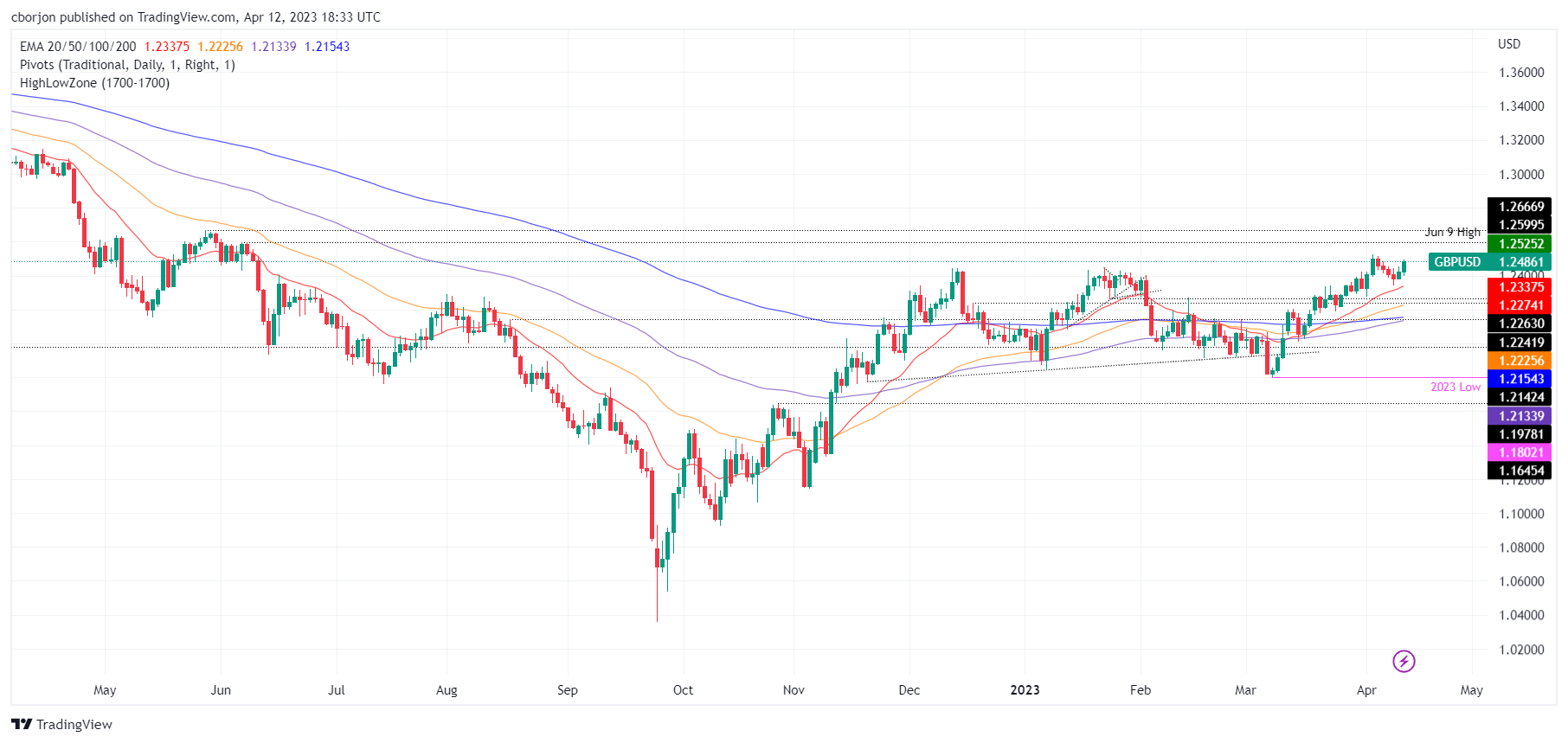
After snapping on Tuesday, four days of straight losses, the GBP/USD is poised to test the 1.2500 figure in the near term. Even though the 100-day EMA remains below the 200-day EMA, it’s about to cross over, cementing the case for the GBP bullish bias. Though a decisive break of 1.2500, the GBP/USD pair could rally and test the June 9 high at 1.2599, ahead of clearing 1.2600.
-
19:23
US Dollar testing key support after FOMC minutes
- FOMC minutes, US CPI events are weighing on the US Dollar.
- US Dollar bears are in the market and eye a break of temporary support.
- Bulls look for commitments for a correction from support.
At 101.469 DXY, the US Dollar is being pressured on Wednesday following the Consumer Price Index (CPI) that increased in March at a slower-than-expected pace and minute from the FOMC´s March 21-22 meeting whereby the rate hike was widely viewed as dovish. DXY has dropped from a high of 102.15 to a low of 101.449 on the day so far.
The FOMC minutes showed that the staff at the Committee are forecasting a mild recession later in 2023 but also noted that wage growth was still well-above rates consistent with the 2% inflation target.
Key quotes from the minutes:
"Given their assessment of the potential economic effects of the recent banking-sector developments, the staff’s projection at the time of the March meeting included a mild recession starting later this year, with a recovery over the subsequent two years."
"In assessing the economic outlook, participants noted that since they met in February, data on inflation, employment, and economic activity generally came in stronger than expected. They also noted, however, that the developments in the banking sector that had occurred late in the intermeeting period affected their views of the economic and policy outlook and the uncertainty surrounding that outlook."
"Participants agreed that the labor market remained very tight."
"Some participants noted that given persistently high inflation and the strength of the recent economic data, they would have considered a 50 basis point increase in the target range to have been appropriate at this meeting in the absence of the recent developments in the banking sector. However, due to the potential for banking-sector developments to tighten financial conditions and to weigh on economic activity and inflation, they judged it prudent to increase the target range by a smaller increment at this meeting."
"Members concurred that the U.S. banking system is sound and resilient. They also agreed that recent developments were likely to result in tighter credit conditions for households and businesses and to weigh on economic activity, hiring, and inflation, but that the extent of these effects was uncertain. Members also concurred that they remained highly attentive to inflation risks."
US CPI core stays hot
As for the inflation data, the report showed the prices urban consumers pay for a basket of goods and services increased by 0.1% from the previous month and 5.0% year-on-year, landing below consensus expectations of 0.2% and 5.2%, respectively.
But the core measure came in hot. This measure strips out volatile food and energy prices and was posting a month-on-month gain of 0.4%, and 5.6% on an annual basis, 10 basis points hotter than the February print.
Nevertheless, Fed funds futures traders are pricing in 69% probability that the Fed will raise rates by an additional 25 basis points at its May 2-3 meeting, down from around 76% before the data. This is sending the US Dollar lower on the day and into technical support as follows:
US Dollar technical analysis
Daily chart
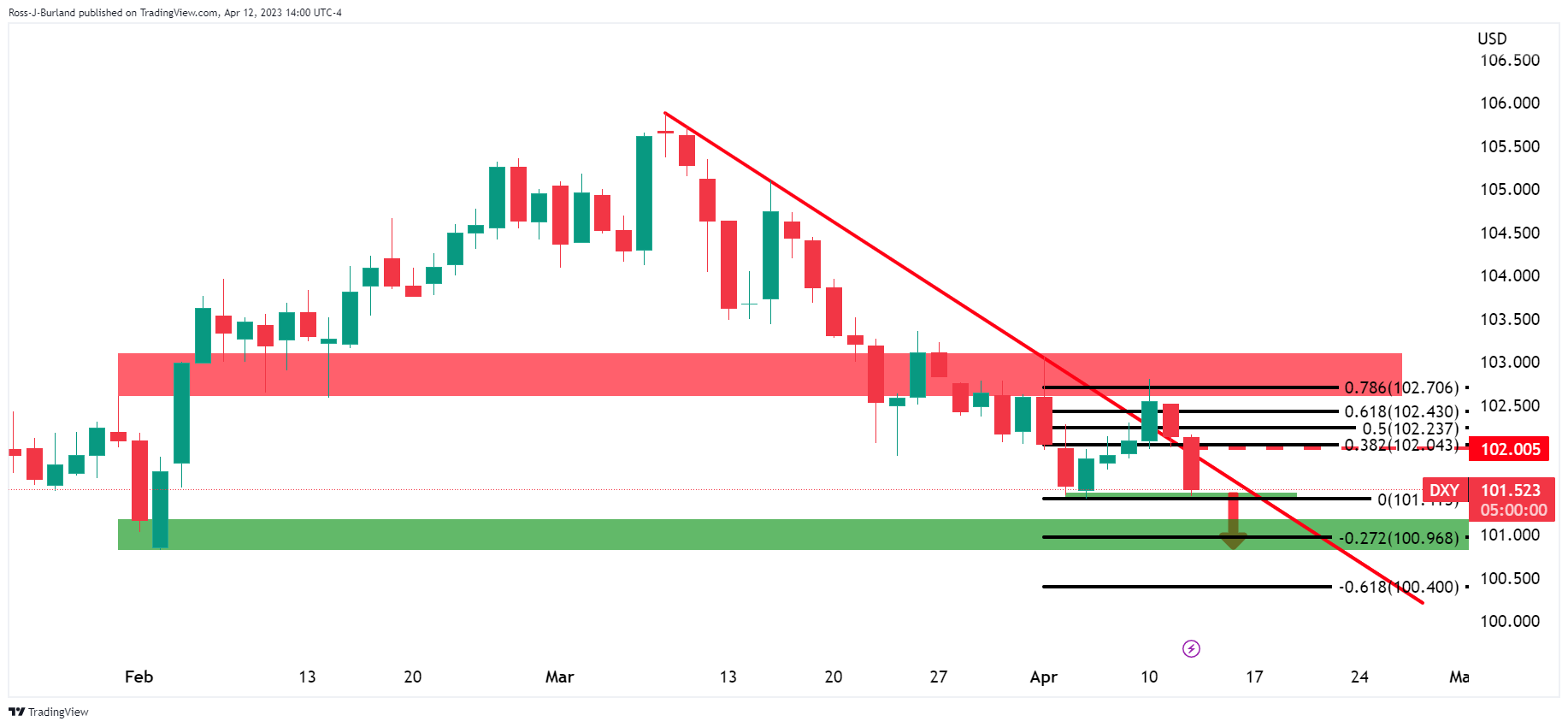
The bias is to the downside while the index is on the front side of the bearish trend and considering the strong daily bearish impulse from the 78.6% Fibonacci retracement level.
H1 chart

However, there are prospects of a correction on the lower time frames from the support area as illustrated above.
-
19:06
FOMC minutes: Staff’s projections included a mild recession starting later this year
The Federal Open Market Committee (FOMC) released the minutes of the March 21-22 meeting, spurring little action across the FX board. According to the document, staff’s projections included a “mild recession starting later this year, with a recovery over the subsequent two years”.
In March, the Federal Reserve (Fed) raised the key interest rates by 25 basis points to 4.75% - 5.0%, as expected amid banking turmoil. Since the meeting, banking concerns eased and inflation data released on Wednesday showed the Consumer Price Index slowed to 5% in March, the lowest since May 2021; however, the Core rate edged higher to 5.6%. The minutes showed that some Fed officials would have considered a 50 basis point rate hike in the absence of the developments in the banking sector.
Key quotes from the minutes:
"Given their assessment of the potential economic effects of the recent banking-sector developments, the staff’s projection at the time of the March meeting included a mild recession starting later this year, with a recovery over the subsequent two years."
"In assessing the economic outlook, participants noted that since they met in February, data on inflation, employment, and economic activity generally came in stronger than expected. They also noted, however, that the developments in the banking sector that had occurred late in the intermeeting period affected their views of the economic and policy outlook and the uncertainty surrounding that outlook."
"Participants agreed that the labor market remained very tight."
"All participants agreed that it was appropriate to raise the target range for the federal funds rate 25 basis points to 4¾ to 5 percent. All participants also agreed that it was appropriate to continue the process of reducing the Federal Reserve’s securities holdings."
"Several participants noted that, in their policy deliberations, they considered whether it would be appropriate to hold the target range steady at this meeting. They noted that doing so would allow more time to assess the financial and economic effects of recent banking-sector developments and of the cumulative tightening of monetary policy. However, these participants also observed that the actions taken by the Federal Reserve in coordination with other government agencies helped calm conditions in the banking sector and lessen the near-term risks to economic activity and inflation."
"Some participants noted that given persistently high inflation and the strength of the recent economic data, they would have considered a 50 basis point increase in the target range to have been appropriate at this meeting in the absence of the recent developments in the banking sector. However, due to the potential for banking-sector developments to tighten financial conditions and to weigh on economic activity and inflation, they judged it prudent to increase the target range by a smaller increment at this meeting."
"Members concurred that the U.S. banking system is sound and resilient. They also agreed that recent developments were likely to result in tighter credit conditions for households and businesses and to weigh on economic activity, hiring, and inflation, but that the extent of these effects was uncertain. Members also concurred that they remained highly attentive to inflation risks."
Market reaction:
The US Dollar remains at session lows, with the Dollar Index headed toward the lowest close since early February, down 0.65%. EUR/USD rose to test the 1.1000 area. US yields held steady, with the US 10-year around 3.43% and the 2-year slightly below 4%.
-
19:00
United States Monthly Budget Statement below forecasts ($-302B) in March: Actual ($-378B)
-
18:55
USD/JPY Price Analysis: Dips as it faces resistance at the 200-DMA, post-US CPI
- The USD/JPY retraced after hitting a daily high of 134.00, though solid resistance pressured USD Bulls.
- USD/JPY Price Analysis: Downside expected as it remains below 133.77; otherwise, once reclaiming 134.00, 135.00 would be up for grabs.
The USD/JPY remains downward pressured, following a release of inflation figures in the United States (US) dipped, though core inflation stood unchanged for two straight months. At the time of typing, the USD/JPY is trading at 133.33, snapping four days of gains after hitting a high of 134.04.
USD/JPY Price Action
From a technical perspective, the USD/JPY is trapped within the 200 and 50-day EMAs at 133.70 and 133.09. the USD/JPY peaking on Tuesday at around 133.80 was difficult to surpass, as shown by Wednesday’s price action. Nonetheless, the USD/JPY needs a daily close below the 200-day EMA to cement the case for a neutral-to-downward biased, exerting selling pressure on the USD/JPY pair.
If USD/JPY achieves that scenario, the next support would be the 133.000 figure. A breach of the latter will expose the 20-day EMA at 132.70, followed by the 132.00 mark. On the other hand, a USD/JPY resumption above the 200-day EMA will exacerbate a recovery above the confluence of the 100-day EMA and the 134.00 figure. Once cleared, the USD/JPY could threaten January’s 6 high at 134.77, before reaching the 135.00 figure.
USD/JPY Daily Chart
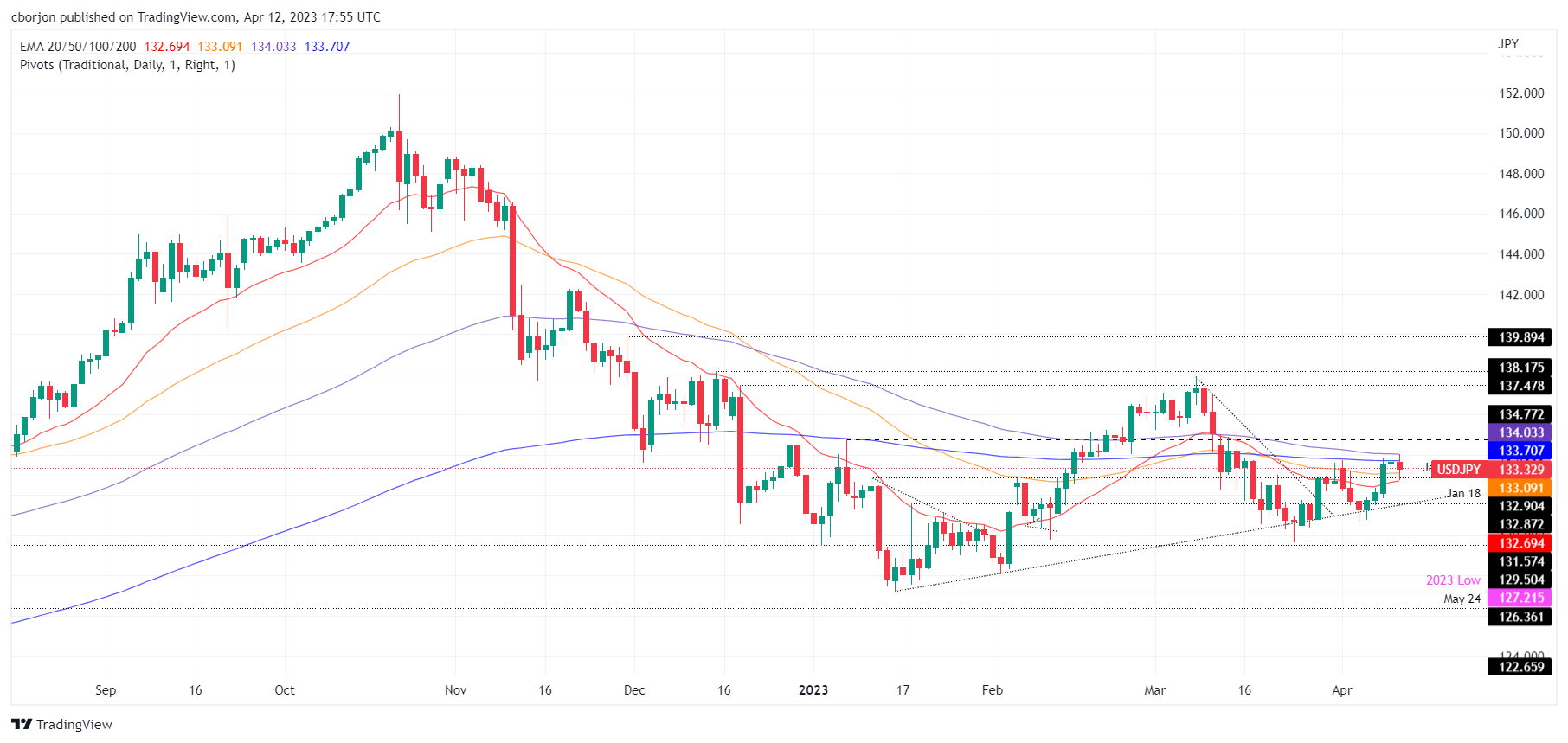
USD/JPY Technical Levels
-
18:51
EUR/USD traders getting set for FOMC minutes finale
- EUR/USD bulls eye the 1.1020s into the FOMC after US CPI.
- Bears eye a pull back into test 1.0970.
EUR/USD reached 1.0999, the highest since February 2, and was last at 1.0995, up 0.79% on the day with the US Dollar index, DXY last at 101.51, down 0.62% on the day.
The short covering in EUR continues into the middle of the week as the US Dollar dropped sharply on Wednesday after data showed US Consumer Price Index rose less than expected in March. Traders are of the mind that the Federal Reserve is going to stop raising rates after a possible increase in May and potentially pivot before the end of the year.
CPI rose just 0.1% last month, below economists’ expectations for a 0.2% gain, and down from a 0.4% increase in February. In the 12 months through March, the CPI increased 5.0%, the smallest year-on-year gain since May 2021. The CPI rose 6.0% on a year-on-year basis in February. Excluding the volatile food and energy components, the CPI increased 0.4% last month after rising 0.5% in February. However, stubbornly high rental prices continued to drive core CPI.
The data comes ahead of the Federal Open Market Committee minutes at the top of the hour and US Retail Sales data on Friday. The minutes will be from the FOMC´s March 21-22 meeting whereby the rate hike was widely viewed as dovish.
´´The distribution of the March dot plot for 2023, however, suggested a more hawkish sentiment across the FOMC. With banking stress now appearing to be somewhat contained, the minutes for this meeting might emphasize this hawkish sentiment given continued elevated inflationary pressures,´´ analysts at TD Securities explained.
Meanwhile, ahead of the minutes, Fed funds futures traders are pricing in 69% probability that the Fed will raise rates by an additional 25 basis points at its May 2-3 meeting, down from around 76% before the data.
EUR/USD technical analysis
H4 charts
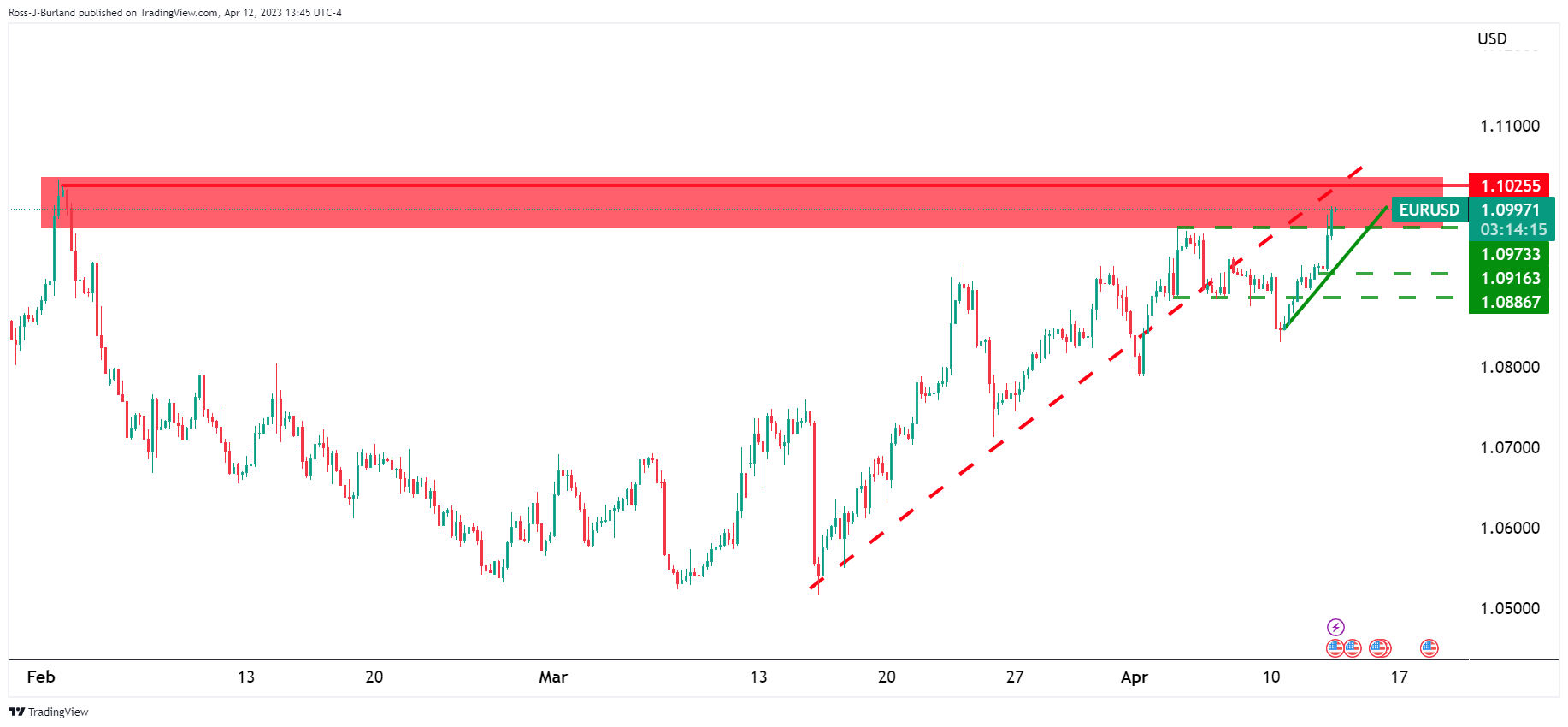
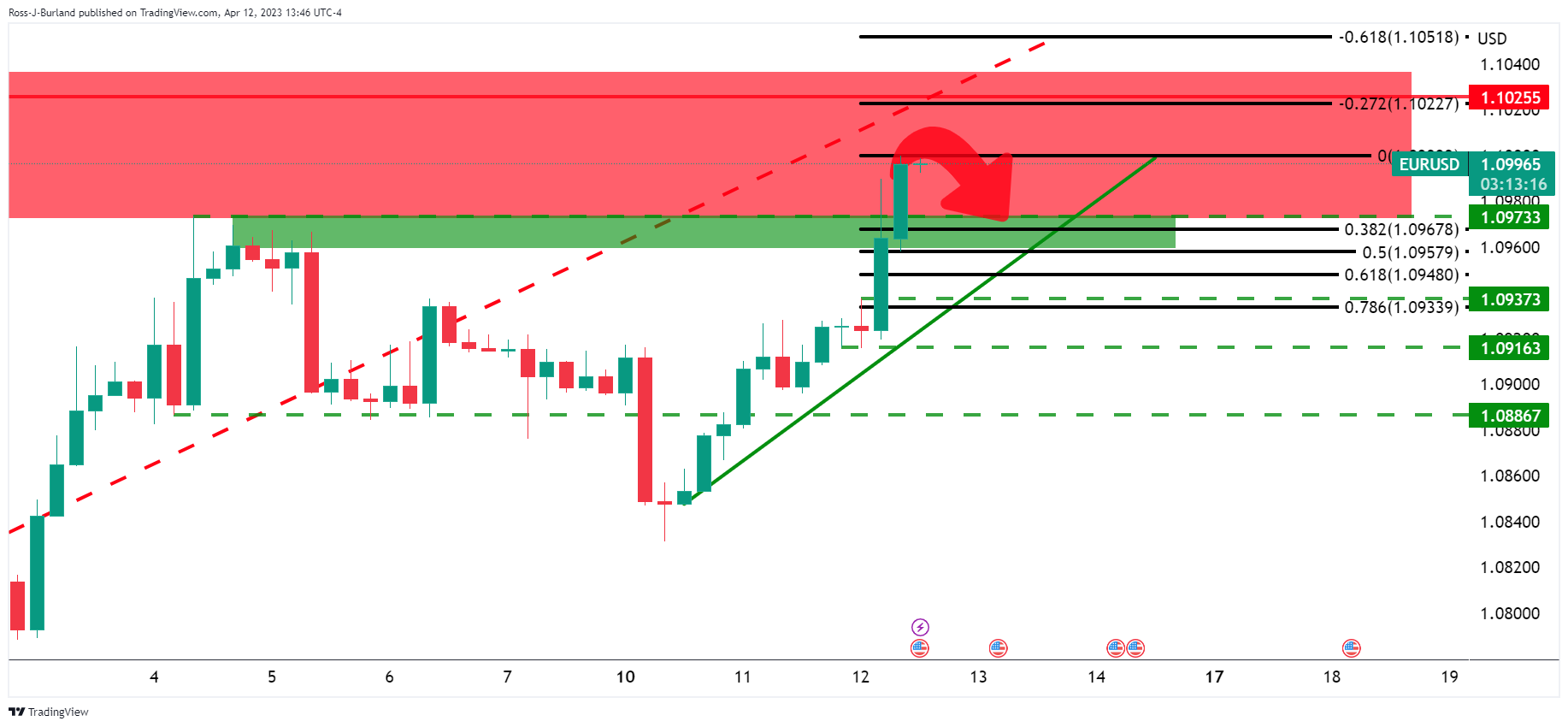
H1 chart
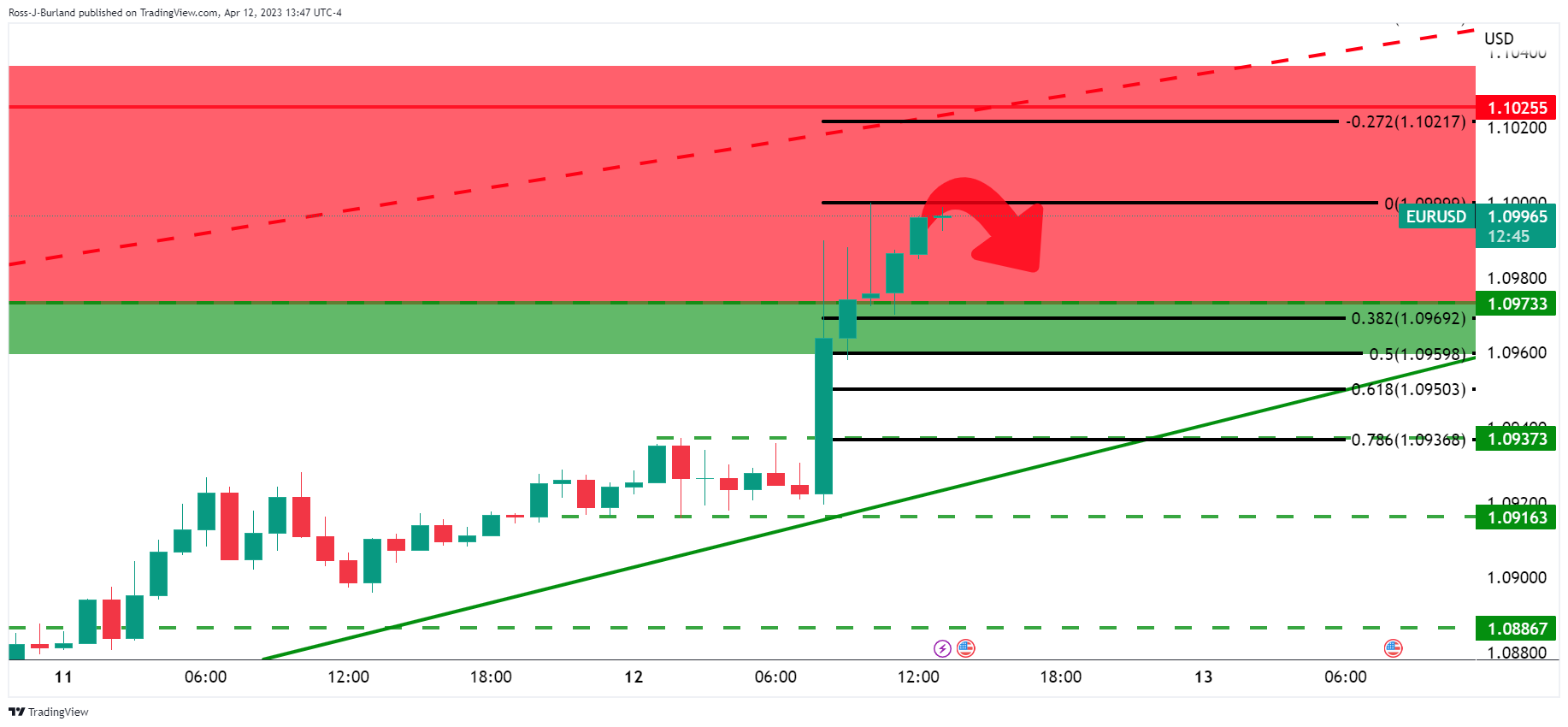
With 1.1020s on the radar for the bulls, should the bears commit, however, then there will be prospects of a correction back into support near 1.0970. The FOMC minutes could be the catalyst either way.
-
18:05
United States 10-Year Note Auction dipped from previous 3.985% to 3.455%
-
17:44
USD/MXN falls as Mexican Peso gains momentum on mixed US CPI
- USD/MXN reached a daily low shy of cracking 18.00 as a reaction to US CPI data.
- Sentiment shifted mixed as US core CPI was unchanged, cementing the case for a Fed rate hike in May.
- Federal Reserve officials remain committed to tackling inflation, even though it causes a recession.
The Mexican Peso (MXN) continued to strengthen against the US Dollar (USD), following contradictory US inflation data, which cemented the case for another rate hike by the US Federal Reserve (Fed) at the upcoming May meeting. The USD/MXN is trading at around 18.08, below its opening price by a half percent.
Inflation in the United States dropped, except for core CPI
US equities are fluctuating following an important March inflation report. The Consumer Price Index (CPI) rose 5% YoY, below estimates of 5.3% and lower than February’s 6%, showing that Fed’s tightening is indeed working. Nonetheless, excluding volatile items like food and energy, the so-called core CPI rose 5.6% YoY, unchanged compared to the consensus and the prior’s month data.
Given that core CPI remains stickier than expected, the Federal Reserve (Fed) is expected to raise rates by 25 bps at the May meeting. The CME FedWatch Tool shows odds for a 25 bps hike at 66.5%, below Tuesday’s 72.9%.
The USD/MXN edged lower as an initial reaction to the headline, with the USD/MXN pair reaching a new weekly low of 18.0187, before rebounding and stabilizing around current exchange rates. The greenback weakened, as shown by the US Dollar Index (DXY), down 0.59%, at 101.535, weighed by falling US bond yields.
At a certain point, the US 2-year bond yield dropped 14 bps, but so far has erased some of those losses and is back above 4%, down 2 bps.
Meanwhile, Federal Reserve officials posted mixed comments, led by Minnesota’s Fed Neil Kashkari, who commented on Wednesday that tighter monetary conditions and difficult credit conditions could have caused the Silicon Valley Bank (SVB) crisis. But he emphasized, “We need to get inflation down. ... If we were to fail to do that, then your job prospects would be really hard.”
Later the Richmond Fed President Thomas Barkin said that the US inflation report was as expected but added that although inflation has peaked, “there is still some way to go.” Furthermore, he said that before the May meeting, the PCE and the ECI would be crucial to assess his stance at the upcoming meeting.
At around 18:00 GMT, the Federal Reserve Open Market Committee (FOMC) will reveal its latest monetary policy meeting minutes. The minutes are expected to show discussions of the latest meeting after the defaults of Silicon Valley Bank and Signature Bank.
USD/MXN Technical Analysis
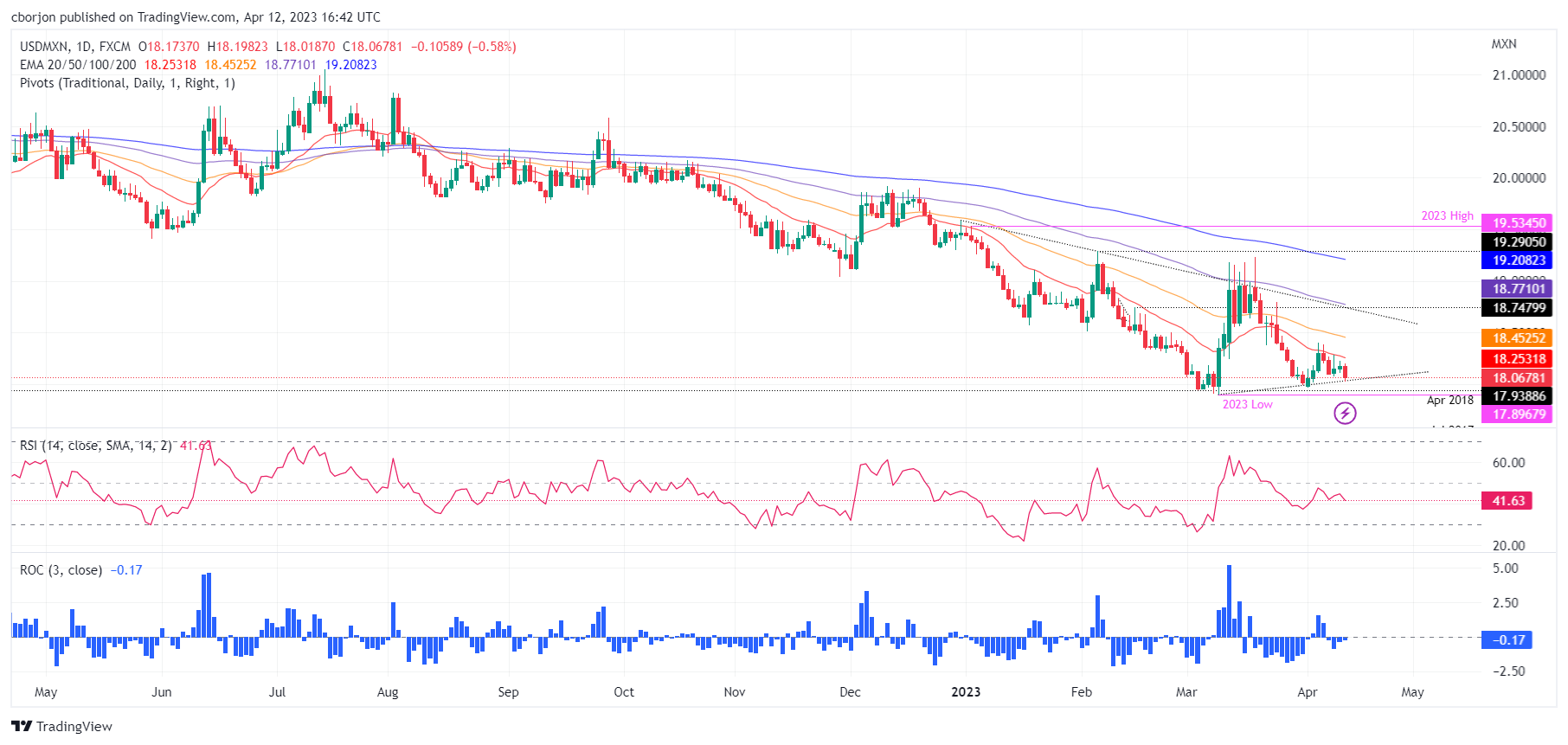
The USD/MXN is downward biased, though facing solid support. For a bearish continuation, the USD/MXN pair needs to crack 18.00, to pave the way for a re-test of the YTD low at 17.8968. Otherwise, the emerging market currency could weaken, exposing the 20-day EMA at 18.2533, which USD/MXN buyers would test. Break above, and the USD/MXN could rally to the 50-day EMA at 18.4526.
-
17:33
Fed's Daly: There's a lot more in the pipeline of monetary policy tightening
San Francisco Federal Reserve Bank President Mary Daly said that they had good news on inflation but added that she doesn't want to forecast the end of the tightening cycle, as reported by Reuters.
Key takeaways
"Bank stresses have stabilized."
"We have tools for monetary policy, financial stability and they don't compete with each other."
"I expect inflation to end 2023 a little above 3%."
"Inflation expectations are anchored, allowing us to take a couple of years to bring down inflation."
"Policy tightening is at a point now where we don't expect to continue to raise rates every meeting."
"There is a sense we will get rates up to a level and stay."
"Will look in CPI inflation to see if core services ex-housing are coming down."
"We are getting signs of cooling in labor market, but not there yet."
"There's a lot of uncertainty about how long it takes for rate hikes to impact the economy."
"There's a lot more in the pipeline of monetary policy tightening."
"When credit conditions tighten, it puts brakes on the economy so Fed doesn't have to tighten more."
"Bank lending will contract."
Market reaction
These comments failed to help the US Dollar find demand and the US Dollar Index was last seen losing 0.6% on the day at 101.52.
-
17:13
Russia Consumer Price Index (MoM) above expectations (0.2%) in March: Actual (0.4%)
-
17:10
Fed's Daly: Strength of economy, elevated inflation suggest more work to do on rate hikes
San Francisco Federal Reserve Bank President Mary Daly said on Wednesday that the strength of the US economy and elevated inflation suggests that they have more work to do on rate hikes, as reported by Reuters.
Key takeaways
"Prudent Fed policy requires calibrating decisions based on all the data."
"Good reasons that economy may keep slowing even without further rate hikes."
"We are committed to ensuring all deposits are safe."
"Fed is prepared to use all tools for any size bank to keep system safe and sound."
"Economy remains strong, labor market extremely tight."
"Fed must monitor tightening credit conditions in determining path of rates."
"Committed to 2% inflation goal."
"Global headwinds, lagging impact of Fed rate hikes are also factors in setting policy."
Market reaction
The US Dollar showed no immediate reaction to these comments and the US Dollar Index was last seen losing 0.6% on the day at 101.55.
-
16:46
Fed: One more rate hike coming – Wells Fargo
Analysts at Wells Fargo see one more interest rate hike coming from the Federal Reserve, following Wednesday’s US Consumer Price Index report. According to them, inflation remains too hot for Fed’s liking.
Key quotes:
“The core CPI has been above 5% on a year-over-year basis for 16 consecutive months, and over the first three months of 2023, core consumer prices have risen at an equally hot 5.1% annualized rate. This is not to say there has been no progress towards taming inflation. Energy prices have outright fallen over the past year, food inflation is slowing and prices for certain goods that surged during the pandemic, such as used vehicles, have declined. But, directional progress should not be confused with mission accomplished.”
“We expect another 25 bps rate hike from the FOMC at the conclusion of its next meeting on May 3.”
“We think the May 3 rate hike will be the last of the tightening cycle. Our view is that the FOMC will hold the target range for the federal funds rate at 5.00%-5.25% for the foreseeable future in order to assess the effectiveness of their accumulated policy tightening.”
-
16:24
BoC's Macklem: We are not forecasting a major contraction
Bank of Canada (BoC) Governor Tiff Macklem comments on the policy outlook following the BoC's decision to leave its policy rate unchanged at 4.5% in April.
Key takeaways
"We need a period of weak growth."
"Outlook for growth has not changed very much."
"We are not forecasting a major contraction."
"You can't rule out that there's going to be a couple quarters of small negatives."
"Our baseline forecast is for a positive but weak growth and declining inflation."
"The implied expectation in the market that we're going to be cutting our policy rate later in the year. That doesn't look today like the most likely scenario to us."
-
16:18
Gold Price Forecast: XAU/USD crawls higher amid mixed US inflation data
- Gold price extended its gains on mixed US economic data.
- US CPI cooled down, but Core CPI was unchanged, indicating sticky inflation.
- XAU/USD Price Analysis: Likely to remain bullish, but a drop below $2,000 would pave the way to $1,950.
Gold price resumes to the upside after hitting a low of $2001, following a mixed US inflation report. Furthermore, recent Fed officials’ mixed comments about overtightening monetary policy keep the American Dollar (USD) pressured. At the time of typing, the XAU/USD is trading at $2,005.34, above its opening price by a minuscule 0.11%.
US CPI cools down, though core CPI remains stickier
The US Bureau of Labor Statistics (BLS) revealed that March’s Consumer Price Index (CPI) rose less than the 5.2% expected, tumbling from 6% to 5% YoY, in figures revealed ahead of the Wall Street open. Nevertheless, not everything is positive news, as the Core CPI, which excludes volatile items, was unchanged at 5.6% YoY.
The yellow metal reacted upwards, reaching a new daily high at $2,028.32. It has retreated some of those gains as it meanders shy of the $2,010 area. Contrarily, the US Dollar (USD) extended its downtrend to two straight days of losses, as shown by the US Dollar Index (DXY), which measures the performance of six currencies against the USD. The DXY exchanges hands at 101.546, down 0.58%, threatening to dip below the 101.000 mark.
Another reason for Gold’s jump was that US Treasury bond yields dropped sharply, with the 2-year bond yield collapsing 14 bps, before erasing some of those losses. Nevertheless, traders' bets that the US Federal Reserve (Fed) would continue to tighten monetary conditions stood tall at 67.2% for a 25 bps rate hike, compared to Tuesday's 72.9%.
Of late, the Richmond Fed President Thomas Barkin said that the report was aligned with expectations but added that although inflation has peaked, “there is still some way to go.” Furthermore, he said that before the May meeting, the PCE and the ECI would be crucial to assess his stance at the upcoming meeting.
Gold Technical Analysis
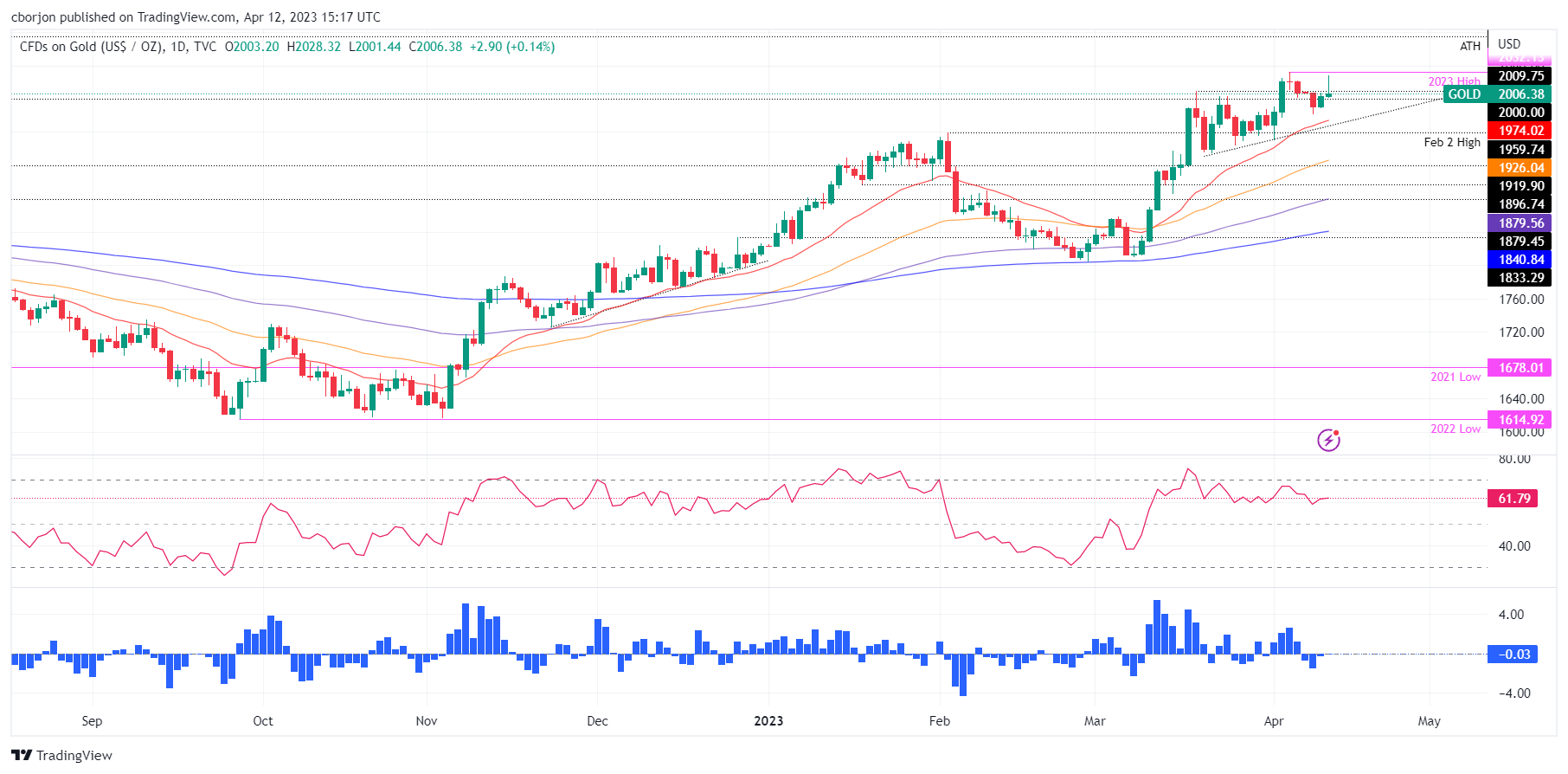
Even though XAU/USD prints minuscule gains on Wednesday, price action forms an inverted hammer preceded by an uptrend, usually a bearish candle. Oscillators remain bullish, but the Relative Strength Index (RSI) stopped its uptrend and is sideways, while the Rate of Change (RoC) is almost neutral. For an XAU/USD bullish resumption, buyers need to crack the high at $2,028.32, so they could pose a threat to the YTD high at $2,032.13. Contrarily, the XAU/USD would extend its losses, past the $2,000 figure, with the 20-day EMA being the first demand zone at $1,974.00, followed by February’s 2 high at $1,959.74.
-
16:11
BoC: Announcement reaffirms that risks in 2023 skew towards more tightening – TDS
The Bank of Canada, as expected, left the key interest rate unchanged at 4.50%. USD/CAD moved modestly to the downside. Analysts at TD Securities look for the BoC to remain at 4.50% for all of 2023.
BoC is playing wait-and-see
“Forward guidance was not materially changed, but the communique leaned on the hawkish side with the Bank acknowledging that returning to 2% inflation could prove difficult.”
“We still look for the Bank to remain at 4.50% for all of 2023, as we do expect growth to slow markedly in Q2. That said, if the expected softening in the labour market does not emerge, the BoC may have little choice but to tighten again. With markets likely to give the BoC a pass in June, we see more risk for rate hikes in the July and September meetings.”
“There’s isn’t much for CAD to latch on regarding the BoC announcement. The tone of the statement underscores more of a hawkish hold scenario, which has likely helped USDCAD nudge lower. USDCAD HFFV sits below 1.34, suggesting that the pair is trading rich to macro drivers. We continue to like 1.33/1.37 range and look to fade the extremes of that range.”
-
16:07
BoC's Macklem: Governing Council discussed whether it had raised rates enough
Bank of Canada (BoC) Governor Tiff Macklem comments on the policy outlook following the BoC's decision to leave its policy rate unchanged at 4.5% in April.
Key takeaways
"Governing Council discussed whether it had raised rates enough."
"The work of monetary policy - the full impact of previous rate hikes - is not done."
"Governing Council considered likelihood that rates may need to remain restrictive for longer to return inflation to 2% target."
"Bank is encouraged that inflation is declining."
"The Canadian economy remains in excess demand."
"With inflation still well above target, the bank continues to be more concerned about upside risks to forecast."
-
15:56
Gold Price Forecast: XAU/USD’s rally has further to run in the quarters ahead – UBS
Gold has been a strong performer so far this year. Economists at UBS expect the yellow metal to extend its race higher in the coming quarters.
Gold shines with growth concerns in focus
“In the near term, prices are likely to remain sensitive to shifts in investor risk sentiment and interest rate expectations. But we think Gold's rally has further to run in the quarters ahead.”
“First, further safe-haven flows are likely as uncertainty about the economic growth outlook continues. Second, we think the US Dollar looks set to weaken further. Gold tends to rise in periods when the US currency is depreciating, and downside risks to the greenback have risen alongside money market pricing of Federal Reserve rate cuts.”
-
15:47
Fed’s Barkin: We are past peak inflation
Richmond Federal Reserve President Thomas Barkin said on Tuesday, in an interview with CNBC, that inflation certainly has peaked but warned that there are still ways to go.
The Consumer Price Index rose 0.1% in March, with the annual rate slowing to 5%, the smallest since May 2021. Barkin said those numbers were “pretty much” as expected. Barkin mentioned he sees signs that demand is cooling.
Market reaction
The US Dollar is falling sharply on Wednesday, after extending losses following the US CPI report. The DXY is down by 0.60%, trading at 101.50, near the April low.
-
15:42
USD/JPY to plummet toward 120 by year-end on a US recession – ING
USD/JPY still trades above 130. Nevertheless, economists at ING forecast the pair at 120 by the end of the year.
USD/JPY will again prove the best vehicle to hedge a US recession
“FX markets currently price a 30% chance that the USD/JPY pair trades at 120 at, or even before, the end of the year.”
“120 is our year-end forecast and is premised on the United States going into recession and the Federal Reserve cutting rates by 100 basis points later this year.”
-
15:31
United States EIA Crude Oil Stocks Change came in at 0.597M, above forecasts (-0.583M) in April 7
-
15:31
MAS Preview: Forecasts from five major banks, continuing with policy normalisation
The Monetary Authority of Singapore (MAS) is expected to release its Monetary Policy Statement (MPS) on Friday, April 14 and as we get closer to the release time, here are the expectations forecast by the economists and researchers of five major banks.
MAS is expected to tighten monetary policy settings.
ANZ
“We expect the MAS to increase the slope of the policy band by 100 bps to 3% per annum, while keeping the midpoint and width unchanged. This is a less aggressive move than last year when there were three consecutive upward re-centrings that total 550 bps. Within our Taylor Rule, there is no difference between a 100 bps increase in the slope versus a 100 bps upward re-centring of the midpoint. However, a slope increase is less aggressive than an upward re-centring, which we view as more appropriate at this juncture given that core inflation is expected to moderate, and also in light of the additional uncertainty in the global economic outlook.”
BBH
“While it doesn’t have an explicit inflation target, easing headline readings and the slowing economy should allow the MAS to keep policy steady this week. It will be a close call and there are risks of a hawkish surprise given the continued rise in core inflation. Singapore’s GDP growth will come in below trend in 2023, and downside risks have intensified. At the same time, MAS Core Inflation is expected to remain elevated over the next few quarters, with risks still tilted to the upside. MAS has assessed that, on balance, a further tightening of monetary policy is needed to help ensure that price pressures are dampened over the next few quarters.”
Standard Chartered
“We maintain our call for the MAS to keep policy unchanged in April. A hawkish risk is if and when the MAS adjusts policy for potentially higher long-term inflation. Finance Minister Lawrence Wong indicated in the recent budget that global inflation may settle at a higher trend than before. The SGD NEER slope, at +1.5% per annum, may need to be adjusted higher (to 2% per annum), in our view, should inflation stay high medium-term. That said, the MAS appears to be more focused on near-term inflation, and given the uncertain environment, we think it may opt to wait to calibrate policy settings for the long term. At the same time, we do not expect the MAS to take its focus away from inflation, given that inflation risks remain tilted to the upside.”
TDS
“We expect the MAS to steepen the slope of the S$NEER band by 50 bps and no changes to the midpoint and width of the band. Core inflation remains too high and sticky for MAS to consider a pause. SGD should benefit from a further tightening of monetary policy settings and we suggest selling USD/SGD on rallies up to around 1.34. Expect USD/SGD to fall to 1.30 by Q4.”
Citi
“3 reasons why the MAS may entertain a final but ‘gentler’ slope steepening than a more aggressive upward re-centering of the band this week – (1) The expected 2H23 pickup in the Singapore growth outlook supports a further tightening of financial conditions. However, the extent to which the expected 2H23 pickup is challenged by tighter global financial conditions may see a more prudent approach from the MAS to steepen the 12- month NEER slope rather than an upward re-centering; (2) Job market tightness is likely easing more slowly than expected (if at all), with labor costs expected to add to core inflation over the medium term. Analysis of 4Q22 job market data therefore, suggests thresholds for slope steepening have been met rather than for upward re-centering; (3) Singapore’s core CPI to stay above “target” after peaking in 1Q23 – milder core inflation surprises in 1Q23 and gentler trajectory of core CPI is also historically more consistent with steeper slope. We expect Singapore’s core CPI to be 50-70 bps higher than MAS forecast in 2023, implying a gentler slowdown than MAS had forecast.”
-
15:16
USD/CAD slides below 1.3450 as BoC keeps rates unchanged as expected
- Bank of Canada keeps rates unchanged as expected.
- Loonie rose modestly after the announcement.
- USD/CAD moving toward daily lows, under 1.3450.
The USD/CAD weakened after the decision of the Bank of Canada (BoC) and is moving toward daily lows, trading under 1.3440.
The BoC announced on Wednesday that it left the key interest rate unchanged at 4.5% following the April policy meeting, as expected. BoC Governor Tiff Macklem will be delivering his comments on the policy outlook and respond to questions at a press conference starting at 1500 GMT.
The loonie rose modestly across the board after the decision, but it is still lagging among G10 currencies. The worst performer is the US Dollar which tumbled after the US Consumer Price Index (CPI) and amid an improvement in market sentiment.
The USD/CAD is moving with a bearish bias and is about to test the daily low at 1.3430. Below attention would turn to the 1.3400 zone (April low). While under 1.3500, the short-term outlook is biased to the downside.
Technical levels
-
15:08
Gold Price Forecast: XAU/USD should benefit from negative real yields in Q2 – Erste Group
Gold price rose by +8% in USD in the first quarter. Economists at Erste Group Research expect the yellow metal to advance nicely in the second quarter on the back of negative real yields.
Real yields will remain in negative territory in Q2
“Real yields will remain negative in Q2 2023. This favours a rising Gold price.”
“After the very strong increase in Q1, the Gold price should rise only moderately in the second quarter. We expect the price to rise to around $2,080 in Q2.”
-
15:00
Breaking: Bank of Canada leaves policy rate unchanged at 4.5% in April as expected
The Bank of Canada (BoC) announced on Wednesday that it left the benchmark interest rate unchanged at 4.5% following the April policy meeting. This decision came in line with the market expectation. BoC Governor Tiff Macklem will be delivering his comments on the policy outlook and respond to questions at a press conference starting at 1500 GMT.
In its policy statement, the BOC said that the Governing Council will continue to assess whether monetary policy is sufficiently restrictive and added that they remain prepared to raise rates if needed.
Market reaction
With the initial reaction, USD/CAD edged lower and was last seen losing 0.1% on the day at 1.3450.
Key takeaways from the policy statement
"Getting inflation down to 2% could be hard because inflation expectations are coming down slowly, service price inflation and wage growth remain elevated."
"In Canada, demand is still exceeding supply and labor market remains tight; wage growth still elevated relative to productivity growth."
"Inflation in many countries is easing in face of lower energy prices, normalising supply chains and tighter monetary policy."
"BoC expects inflation to fall quickly to around 3% in mid-2023 and then decline more gradually to 2% target by end-2024."
"Will continue the policy of quantitative tightening."
"As more households renew mortgages at higher rates and restrictive monetary policy starts to work it way through economy, 2023 consumption is expected to moderate."
-
15:00
Canada BoC Interest Rate Decision meets forecasts (4.5%)
-
14:55
EUR/USD Price Analysis: The 1.1000 level is just around the corner
- EUR/USD picks up pace and approaches the 1.1000 zone.
- Next relevant target emerges at the YTD peak near 1.1030.
EUR/USD extends the bullish performance and prints new monthly highs around 1.0990 on Wednesday.
The likelihood of extra advances appears favoured for the time being. Against that, the immediate target now appears at the key 1.1000 mark back followed by the 2023 top at 1.1032 (February 2).
Looking at the longer run, the constructive view remains unchanged while above the 200-day SMA, today at 1.0360.
EUR/USD daily chart
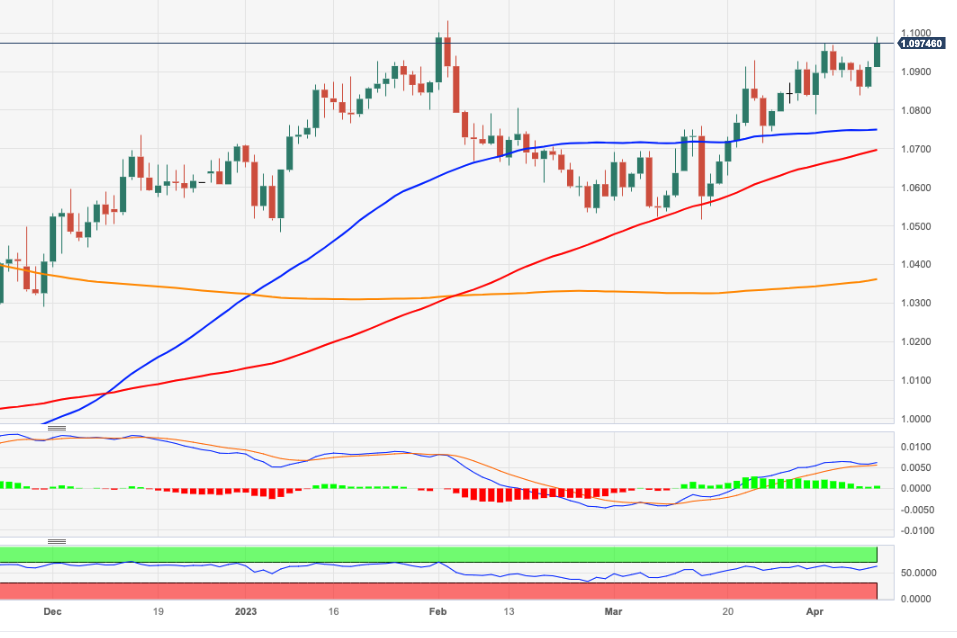
-
14:54
EUR/CHF: SNB wants a 0.98-1.00 range near term – ING
EUR/CHF has traded in a reasonably narrow range of 0.9850-1.000 over recent weeks. Economists at ING note that the Swiss National Bank (SNB) prefers a 0.98-1.00 range near term.
SNB to remain in control
“Probably limiting the topside at 1.00 has been the SNB. Here, the SNB increasingly tells us it has been selling FX reserves to keep CHF stable – largely in line with monetary rather financial stability priorities. The SNB sold CHF27bn of FX in the fourth quarter of 2022.”
“Last year we had felt that the SNB would want a lower EUR/CHF to help fight inflation. It is still threatening another hike – we look for a final move in the policy rate to 1.75% in June. But the financial stress and weaker economic outlook probably mean the SNB prefers a 0.98-1.00 range near term.”
-
14:47
Silver Price Analysis: XAG/USD retreats from one-year peak amid overbought RSI
- Silver gains strong positive traction on Wednesday and touches a fresh one-year top.
- The RSI on the daily chart is flashing overbought conditions and capping the upside.
- The technical setup still supports prospects for a further near-term appreciating move.
Silver catches aggressive bids near the $25.00 psychological mark during the early North American session and spikes to a fresh one-year high in the last hour. The white metal, however, surrenders a major part of its intraday gains and is currently placed around the $25.20-$25.15 area, still up over 0.50% for the day.
The Relative Strength Index (RSI) on the daily chart is holding above the 70.00 mark and points to extremely overbought conditions. This, in turn, is holding back bullish traders from placing fresh bets around the XAG/USD and keeping a lid on any further gains, at least for the time being. The positive technical setup, however, supports prospects for an extension of the recent appreciating move witnessed over the past month or so.
Sustained strength and acceptance above the $25.00 mark add credence to the near-term positive outlook. Some follow-through buying beyond the daily swing high, around the $25.65 region, will be seen as a fresh trigger for bullish traders and set the stage for a move towards reclaiming the $26.00 mark. The XAG/USD could climb further towards the $26.40-$26.50 intermediate resistance en route to the 2022 top, just ahead of the $27.00 mark.
On the flip side, any meaningful pullback might continue to attract fresh buyers near the $25.00 psychological mark. This should help limit the downside for the XAG/USD near the $24.30-$24.40 resistance breakpoint, now turned support. That said, a convincing break below could make the commodity vulnerable to weaken below the $24.00 mark and test the $23.60-$23.55 support before dropping to the $23.15 zone en route to the $23.00 mark.
Silver 4-hour chart
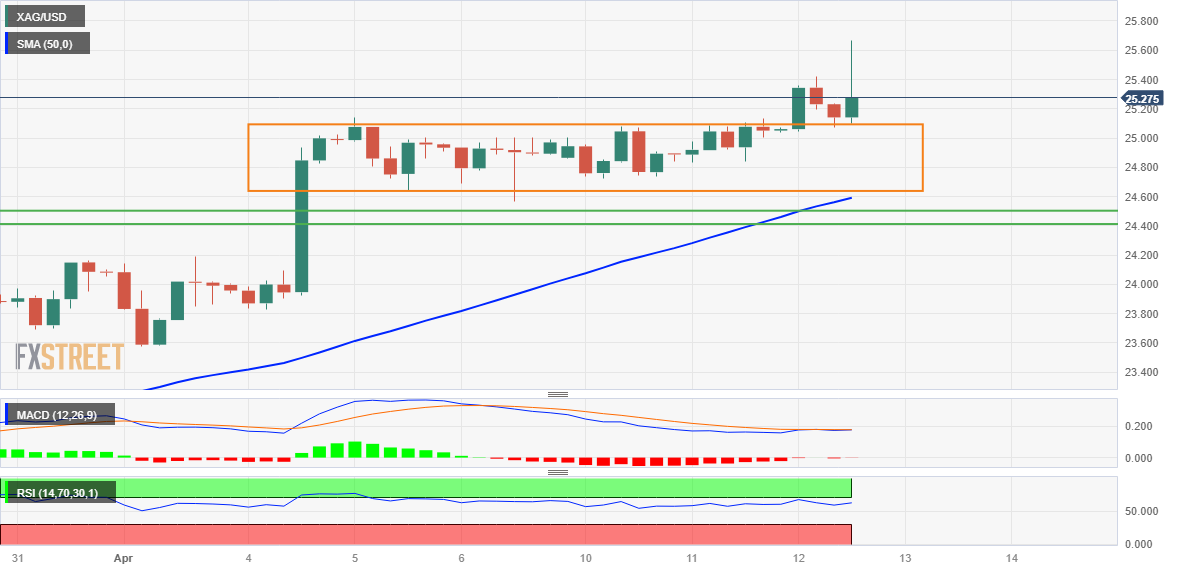
Key levels to watch
-
14:33
USD/BRL: Positive underlying tone in Real trade over the coming days – Commerzbank
USD/BRL trades around 5.00 again. This indicates that the outlook for the Brazilian Real is improving, economists at Commerzbank report.
Promising framework for BRL
“The market received the new fiscal plan positively. What was decisive for the market, for now, was that the government-linked spending curbs to the development of revenue and the targets of the primary balance, i.e. actually measurable variables, which should reduce the risk of escalating national spending.”
“Short-term, we see a high likelihood that BRL will establish itself at high levels, in particular as President Lula da Silva will today set off on his long-awaited visit to China. The hopes for deeper economic ties and further Chinese investments in Brazil point towards a positive underlying tone in BRL trade over the coming days.”
-
14:22
AUD/USD soars above 0.6700 after US CPI
- US Dollar under pressure after US March CPI data.
- Later on Wednesday, the Fed will release the FOMC minutes.
- AUD/USD breaks key resistance levels, outlook positive.
The AUD/USD jumped to 0.6723, reaching a one-week high after the release of the US inflation numbers. The US Dollar tumbled across the board and stocks rose.
Inflation slows, Wall Street cheers
The US Consumer Price Index rose 0.1% in March, below the 0.4% increase of February and smaller than the 0.3% of market consensus. The CPI rose 5% in the year through March, the slowest in almost two years. The Core CPI rose by 0.4% in line with expectations, and the annual rate climbed 5.6%, above the 5.5% of the previous months. Later on Wednesday, the Federal Reserve (Fed) will release the minutes from its latest monetary policy meeting.
After the numbers, Treasury bond rallied and the US Dollar sank. The US 10-year dropped to 3.34% and the 2-year to 3.90%. Wall Street futures are up, with main indexes gaining 0.60% on average.
In Australia, the key report of the week will be on Thursday with the March Employment figures. In the US, market participants will get fresh inflation data with the Producer Price Index.
AUD/USD back above 0.6700
The AUD/USD retake the 0.6700 area and climbed to 0.6723. It is holding firm, with the price above key moving averages in the four-hour chart.
More gains could face resistance at 0.6725/30, and above the next target stands at 0.6755. A slide back below 0.6675 would weaken the outlook for the Aussie.
-638169024990412756.png)
-
14:13
US inflation continues to fall, things are moving in the right direction for the Fed – Commerzbank
US inflation declines to 5%. From the perspective of the Fed, the data thus point in the right direction, economists at Commerzbank report.
The March report shows declining inflationary pressure
“US inflation continued to fall significantly in March, from 6.0% to 5.0%. Not only did volatile energy prices fall noticeably, but there was also some slowing in the important shelter category.”
“The March inflation report should calm the Fed's nerves somewhat. Most price categories show an easing of price pressures, and this is even the case for rents. Moreover, a further decline in rent inflation can be expected in the coming months.”
“The Fed is now likely to focus its attention more on supporting the emerging positive trend. A more aggressive approach is probably no longer necessary in view of the progress made. The Fed nears its interest rate peak; we expect only two more rate hikes of 25 bps each.”
-
14:11
When is the BoC monetary policy decision and how could it affect USD/CAD?
BoC Monetary Policy Decision – Overview
The Bank of Canada (BoC) is scheduled to announce its monetary policy decision this Wednesday at 14:00 GMT. The Canadian central bank is widely expected to leave the overnight interest rate unchanged at 4.5% for the second straight meeting. Most analysts say the central bank will need more time to assess how the economy responds to the eight rate hikes it has delivered over the past year. Hence, the focus will be on the accompanying monetary policy statement, which will also include the updated economic projections,
and the post-meeting press conference at 15:00 GMT.Dhwani Mehta, Senior Analyst and Asian Session Manager at FXStreet, explains: The BoC’s view to stay on hold this month is backed by cooling inflation. The country’s annual Consumer Price Index (CPI) rate fell to 5.2% in February, marking the second month in a row inflation came in lower than forecast, as supply chains recover and commodity prices moderate. It’s worth noting that the monthly data shows inflation is actually closing on the Bank’s inflation target of 2%.
How Could It Affect USD/CAD?
The USD/CAD pair gains some positive traction on Wednesday and moves back closer to the 1.3500 psychological mark amid some repositioning trade ahead of the key central bank event risk. Given that the markets are already expecting the BoC to keep rates unchanged, the announcement is unlikely to provide any meaningful impetus to the major and is likely to be overshadowed by the US CPI-inspired volatility. That said, the near-term policy outlook should influence the Canadian Dollar and allow traders to grab some meaningful opportunities.
From a technical perspective, any subsequent recovery beyond the 1.3500 mark is likely to confront some resistance near the 1.3525-1.3530 region. A convincing breakthrough the latter will trigger a short-covering move and assist the USD/CAD pair to reclaim the 1.3600 round-figure mark. Spot prices could climb further to the next relevant hurdle near the 1.3660-1.3665 horizontal support breakpoint, now turned resistance.
On the flip side, bearish traders need to wait for a sustained break below an upward sloping trend-line extending from the August 2022 swing low. This is closely followed by the very important 200-day Simple Moving (SMA), currently around the 1.3400-1.3390 region. Some follow-through selling will confirm a fresh breakdown and make the USD/CAD pair vulnerable to accelerate the fall towards the 1.3315 intermediate support en route to the 1.3300 mark and the 1.3270-1.3265 horizontal zone.
Key Notes
• Bank of Canada Preview: Sitting on the sidelines amid looming recession risks
• BoC Preview: Forecasts from eight major banks, staying on the sidelines
• USD/CAD Analysis: Holds above ascending trend-line, 200 DMA ahead of key data/event risks
About the BoC Interest Rate Decision
BoC Interest Rate Decision is announced by the Bank of Canada. If the BoC is hawkish about the inflationary outlook of the economy and raises the interest rates it is positive, or bullish, for the CAD. Likewise, if the BoC has a dovish view on the Canadian economy and keeps the ongoing interest rate, or cuts the interest rate it is seen as negative, or bearish.
-
14:05
US Dollar should weaken later in the year – Erste Group
Fed will lower interest rates earlier than the ECB, arguing for continued weakening of the USD later in the year , in the opinion of economists at Erste Group Research.
EUR/USD to move sideways for the time being
“For the US, it is unclear how the recent bank failures will affect lending and thus economic activity and inflation. For the ECB's monetary policy, the decisive factor will be when a slowdown in core inflation will be seen, which is also uncertain.”
“We expect EUR/USD to move sideways for the time being, as there is no clear advantage for either currency. However, this should be followed by a slow weakening of the Dollar. This is because we assume that due to the very high interest rate level and the progress in fighting inflation in the US, the Fed will lower interest rates earlier than the ECB. This will make the USD relatively less attractive, which argues for a continued weakening of the US currency later in the year.”
-
14:03
USD/JPY drops to sub-133.00 levels on softer US CPI, lacks follow-through
- USD/JPY retreats sharply from a four-week high touched earlier this Wednesday.
- The softer US CPI-inspired broad-based USD weakness is seen exerting pressure.
- The risk-on mood, the BoJ’s dovish outlook undermines the JPY and lend support.
The USD/JPY pair comes under heavy selling pressure during the early North American session and retreats further from a four-week high touched this Wednesday. The pair drops to a fresh daily low in reaction to softer US consumer inflation figures and is currently trading around the 133.00 mark, down nearly 0.50% for the day.
The US Dollar (USD) weakens across the board and dives closer to a two-month low touched last week following the release of the crucial US CPI report, which, in turn, is seen exerting downward pressure on the USD/JPY pair. In fact, the US Bureau of Labor Statistics reported that the headline CPI rose by 0.1% in March as compared to the 0.4% recorded in the previous month and the 0.3% anticipated.
Furthermore, the yearly rate decelerated from 6% in February to 5.0% during the reported month and largely overshadowed the mostly inline core CPI, which excludes food and energy prices. Nevertheless, the data reinforce market expectations that the Federal Reserve (Fed) is nearing the end of its rate-hiking cycle, which triggers a steep decline in the US Treasury bond yields and weighs on the buck.
That said, a combination of factors might undermine the Japanese Yen (JPY) and limit losses for the USD/JPY pair, at least for the time being. The prospects for an imminent Fed rate-hike pause boost investors' confidence, which is evident from a sharp spike in the US equity futures. Apart from this, the Bank of Japan's (BoJ) dovish near-term outlook should act as a headwind for the JPY.
Traders might also refrain from placing aggressive bets and prefer to move to the sidelines ahead of the FOMC meeting minutes, due for release later during the US session. The Fed minutes will provide insight into how policymakers evaluated the need for higher rates despite the turmoil in the banking sector. This should help investors to determine the near-term trajectory for the Greenback.
The aforementioned mixed fundamental backdrop makes it prudent to wait for strong follow-through selling before confirming that the USD/JPY pair’s one-week-old uptrend has run its course.
Technical levels to watch
-
14:02
Indonesia: FX reserves rose markedly in March – UOB
Economist at UOB Group Enrico Tanuwidjaja and Junior Economist Agus Santoso review the latest FX reserves prints in Indonesia.
Key Takeaways
“Indonesia’s foreign exchange reserves increased USD4.9bn to USD145.2bn in Mar 2023.”
“The latest reserve level was equivalent to finance 6.4 months of imports or 6.2 months’ worth of imports and servicing the government’s external debt, well above the international adequacy standard of 3 months of imports.”
“Implementation of foreign currency monetary operation through export receivables’ placement in the onshore market (TD DHE) has succeeded in attracting a foreign exchange of USD364mn as per first week of Apr.”
-
14:00
Gold Price Forecast: XAU/USD to challenge the highs yet again if market feels May hike could be the last – TDS
Gold has held strong above the $2,000 mark despite losing some momentum following the last week's US employment data. The yellow metal could retest its highs if markets believe that the Fed’s hike expected in May is the last, economists at TD Securities report.
Miss on the CPI report is giving XAU/USD a lift higher
“While the miss on the CPI report is giving the yellow metal a lift higher, the strong labour market trends and sticky core services inflation suggest a 25 bps hike at the May FOMC meeting is still in the cards.”
“However, if the market increasingly feels the May hike could be the last of the cycle, with cut timing also top of mind, it could be the catalyst needed to see Gold challenge the highs yet again.”
-
13:56
EUR/USD accelerates gains and retargets 1.1000 post-US CPI
- EUR/USD hits new monthly peaks near 1.0990 on Wednesday.
- US inflation figures surprised to the downside in March.
- The FOMC Minutes will take centre stage later in the NA session.
EUR/USD gathers extra steam and approaches the psychological 1.1000 barrier on Wednesday.
EUR/USD remains bid ahead of FOMC Minutes
EUR/USD extends the weekly recovery and records new monthly highs near 1.0990 after the greenback lost the composure following lower-than-expected US inflation figures for the month of March.
Indeed, US inflation gauged by the CPI rose 5.0% in the year to March, while probed to be sticky when it comes to the Core CPI, which matched previous estimates and edged a tad higher to 5.6% over the last twelve months.

Following the release of the US CPI, the probability of a 25 bps rate hike by the Fed in May decreased to around 63% (nearly 72%) along with the U-turn in US yields across the curve.
Later in the NA session, the Fed will release its Minutes of the March gathering.
What to look for around EUR
EUR/USD advances to the vicinity of the 1.1000 hurdle in response to the renewed weakness in the buck following the below-consensus US CPI print.
In the meantime, price action around the single currency should continue to closely follow dollar dynamics, as well as the incipient Fed-ECB divergence when it comes to the banks’ intentions regarding the potential next moves in interest rates.
Moving forward, hawkish ECB-speak continue to favour further rate hikes, although this view appears in contrast to some loss of momentum in economic fundamentals in the region.
Key events in the euro area this week: Germany Final Inflation Rate, EMU Industrial Production (Thursday).
Eminent issues on the back boiler: Continuation, or not, of the ECB hiking cycle. Impact of the Russia-Ukraine war on the growth prospects and inflation outlook in the region. Risks of inflation becoming entrenched.
EUR/USD levels to watch
So far, the pair is gaining 0.60% at 1.0975 and a break above 1.0989 (monthly high April 4) would target 1.1032 (2023 high February 2) en route to 1.1100 (round level). On the flip side, the next support comes at 1.0788 (monthly low April 3) followed by 1.0747 (55-day SMA) and finally 1.0712 (low March 24).
-
13:45
GBP/USD refreshes weekly high, around 1.2470 amid softer US CPI-inspired USD sell-off
- GBP/USD turns positive for the second straight day amid broad-based USD selling.
- The softer US CPI lifts bets for an eventual dovish Fed shift and weighs on the buck.
- The risk-on impulse also dents the USD’s safe-haven status and remains supportive.
The GBP/USD pair reverses an intraday dip to sub-1.2400 levels on Wednesday and turns positive for the second straight day in reaction to softer-than-expected US consumer inflation figures. The momentum pushes spot prices to a fresh weekly top, around the 1.2465-1.2470 region during the early North American session.
The US Bureau of Labor Statistics reported that the headline CPI rose by 0.1% in March as compared to the 0.4% recorded in the previous month and the 0.3% anticipated. Furthermore, the yearly rate decelerated from 6% in February to 5.0% during the reported month and largely overshadows the mostly inline core CPI, which excludes food and energy prices. Nevertheless, the data reinforces expectations that the Federal Reserve (Fed) is nearing the end of its rate-hiking cycle. This, in turn, drags the US Dollar (USD) back closer to a two-month low touched last week and lends support to the GBP/USD pair.
Apart from this, the risk-on impulse - as depicted by a strong rally in the US equity futures - is seen as another factor denting the Greenback's relative safe-haven status. That said, bets for another 25 bps lift-off at the next FOMC policy meeting in May puts a floor under the US Treasury bond yields, at least for the time being. This could lend some support to the buck, which, along with the recent mixed signals from the Bank of England (BoE) policymakers over future rate hikes, might cap gains for the GBP/USD pair. Hence, it will be prudent to wait for some follow-through buying before placing fresh bullish bets.
Investors also seem reluctant and might prefer to wait on the sidelines ahead of the release of the FOMC meeting minutes, due later during the US session. The Fed minutes will provide insight into how policymakers evaluated the need for higher rates despite the turmoil in the banking sector. This should help investors to determine the near-term trajectory for the USD and provide a fresh directional impetus to the GBP/USD pair.
Technical levels to watch
-
13:43
Further choppy conditions in the USD’s outlook – Rabobank
On a one-month view, the USD is the weakest performing G10 currency. But in the view of economists at Rabobank, there are plenty of potential pitfalls in the months ahead for risk appetite which could be USD supportive.
Scope for pullbacks in the greenback
“While expectations of less Fed easing are conducive with a softer USD, this assumption is built around the view that credit conditions have tightened. Even if tighter credit conditions do not trigger another mini crisis, they do raise recession risks for the US.”
“A recession in the world's largest economy would not provide a backdrop in which investors are rushing into risky assets en-masse. The USD tends only to weaken significantly in periods when risk appetite is elevated, and EM assets are performing well.”
“Given the risks around the US economic outlook in H2, we do not envisage a significantly weaker profile for the USD in the months ahead and see scope for pullbacks in the greenback reflecting the likelihood that risk appetite will remain twitchy.”
-
13:41
Gold Price Forecast: XAU/USD jumps toward $2,030 as US CPI slows to 5%
- US CPI rose 0.1% in March, below 0.3% of market consensus.
- US Dollar tumbles across the board after inflation data.
- XAU/USD rises more than $20 in a few seconds, to fresh daily highs.
Gold price rocketed after the release of US inflation data, which showed numbers below expectations. XAU/USD rose from $2,007/oz to $2,028, reaching the highest level in six days.
The US Labor Department said on Wednesday that the Consumer Price Index (CPI) increased 0.1% MoM in March, below the 0.3% of market consensus. The annual rate slowed down from 6% to 5%, below the 5.2% of market consensus. The Core rate climbed 0.4% in March, in line with expectations.
The US Dollar tumbled after the inflation figures, with the DXY reaching weekly lows near 101.50. At the same time, US yields sank. The US 10-year bond yield fell from 3.44% to 3.37%. Wall Street futures rose sharply.
The combination of risk appetite and lower yields are boosting Gold price. XAU/USD is looking at the recent top around the $2,030 as it moves with a strong bullish momentum.
Technical levels
-
13:31
United States Consumer Price Index Core s.a rose from previous 304.07 to 305.24 in March
-
13:31
United States Consumer Price Index (YoY) below expectations (5.2%) in March: Actual (5%)
-
13:31
United States Consumer Price Index n.s.a (MoM) below forecasts (302.254) in March: Actual (301.836)
-
13:31
United States Consumer Price Index ex Food & Energy (MoM) meets forecasts (0.4%) in March
-
13:30
United States Consumer Price Index ex Food & Energy (YoY) meets forecasts (5.6%) in March
-
13:30
United States Consumer Price Index (MoM) below expectations (0.3%) in March: Actual (0.1%)
-
13:17
India Cumulative Industrial Output above forecasts (5.2%) in February: Actual (5.5%)
-
13:17
India Industrial Output registered at 5.6% above expectations (5.1%) in February
-
13:17
India Manufacturing Output above forecasts (0.2%) in February: Actual (5.3%)
-
13:12
Gold Price Forecast: XAU/USD recovery since the beginning of the week to be unsustainable – Commerzbank
In recent weeks, Gold's price broke above the $2,000 level and approached its record of $2,075 set in August 2020. However, economists at Commerzbank see limited upside potential.
How sustainable is the robust Gold price?
“We expect the Fed to raise its key rate by another 50 bps, meaning that they expect rates to peak at 5.5% – this is higher than the rate priced in for the middle of this year in the Fed Funds Futures and higher than the Fed officials predicted in their latest projections.”
“Unlike the market, which expects the US key rate to be approximately 4.40% at the end of this year, we believe that US rate cuts are unlikely this year. If we turn out to be right, this would mean a further rise in interest rate expectations and thus another downward correction for XAU/USD. We do not, therefore, believe the recovery that has been seen since the beginning of the week to be sustainable.”
“We expect the Gold price to drop to roughly $1,900 by mid-year.”
-
13:04
USD/CAD is shaping up for a retest of the 1.3405/10 area – Scotiabank
USD/CAD is trading little changed ahead of the BoC policy decision. In the meantime, charts turn mildly bearish for the pair, economists at Scotiabank report.
BoC expected to leave its policy rate unchanged
“No change in policy is expected. Even though the bar to higher rates remains high in Canada, the economy is still running quite hot (hotter than policymakers expected), meaning it is too soon to sound the “all clear” on the inflation fight. The policy statement is likely to reaffirm that the Bank is prepared to raise the policy rate further, if needed.”
“US/Canada 2Y cash bond spreads reached +75 bps in early Mar but have narrowed to around 25 bps currently. A further narrowing in spreads will be modestly CAD-supportive, at least.”
“A ‘doji’ candle Monday and net losses for the USD on the day yesterday confer a negative look on the daily chart and allow for a pickup in USD-negative trend momentum.”
“The charts suggest spot is shaping up for a retest of the 1.3405/10 area. Below here targets 1.33.”
“Resistance is 1.3525/50.”
See – BoC Preview: Forecasts from eight major banks, staying on the sidelines
-
13:01
Brazil Retail Sales (MoM) above forecasts (3.2%) in January: Actual (3.8%)
-
12:48
GBP/USD: Broader uptrend remains intact and longer-term momentum studies are bullish – Scotiabank
Investors may be taking a cautious approach on the GBP ahead of BoE Governor Bailey’s comments today. But the broader uptrend in Cable remains intact, economists at Scotiabank report.
Price action still looks basically consolidative
“Bailey’s (recent) public comments have cautioned investors against making any assumptions about the policy rate outlook, however, and he may take the same, neutral approach today if the issue comes up.”
“Sterling has lost a bit of momentum but price action still looks basically consolidative after the GBP’s early April peak around 1.2525.”
“The broader uptrend in spot remains intact and longer-term momentum studies are bullish. The intraday patterns are more neutral, with the GBP capped by resistance at 1.2455 (bullish above here).”
“Support is 1.2390/00.”
-
12:39
EUR/USD: Trend higher still has legs – Scotiabank
EUR/USD nudges higher. Shaun Osborne, Chief FX Strategist at Scotiabank, expects the pair to enjoy further gains.
EUR/USD will remain supported on modest dips
“EUR/USD is trading a little higher overall on the session but short-term price action suggests that gains are a bit of a grind and are attracting some selling pressure on modest gains.”
“The broader trend higher in the EUR has lost a little momentum but the bullish alignment of trend oscillators across the short, medium and long-term DMI studies suggest (to me) that the trend higher in spot still has legs and the EUR will remain supported on modest dips (to the mid/ upper 1.08s).”
“Resistance is 1.0970/75 but 1.10+ remains the (minimum) objective for this move up.”
-
12:32
US CPI: Market to be swayed more by a downside miss in the data than an upside surprise – Scotiabank
USD edges slightly lower ahead of March Consumer Price Index (CPI) data and FOMC minutes. A downside surprise poses more risks than a strong print, economists at Scotiabank report.
Broader downtrend in the USD Index remains very much in play
“The DXY has steadied over the past week or so but the broader downtrend in the index remains very much in play and shows little sign of relenting.”
“Markets are anticipating a further – perhaps significant – decline in headline inflation for the Mar year but core price growth is likely to remain stubborn (unchanged at 5.6% YoY from Feb). Risks around the data are probably somewhat asymmetrical for the USD in that market sentiment is likely to be swayed more by a downside miss in the data than an upside surprise, given that swaps are pricing in around 75% risk of a 25 bps Fed hike at the May FOMC.”
“The minutes for the Mar 22 policy decision might give some signs of how concerned policymakers are about credit tightening in the wake of the regional bank tensions that played out last month around their decision to tighten.”
See – US CPI: Banks Preview, inflation softening, good news on the horizon?
-
12:30
USD Index Price Analysis: The loss of 102.00 could expose a deeper drop
- DXY adds to Tuesday’s bearish move and confronts 102.00.
- Next on the downside emerges the April low near 101.40.
DXY remains under pressure and puts the 102.00 region to the test on Wednesday, adding to the negative price action seen in the previous session.
A daily close below the 102.00 mark could open the door to a deeper retracement to, initially, the April low at 101.43 (April 5), while the breach of this level could expose a move to the 2023 low around 100.80 (February 2).
Looking at the broader picture, while below the 200-day SMA, today at 106.42, the outlook for the index is expected to remain negative.
DXY daily chart
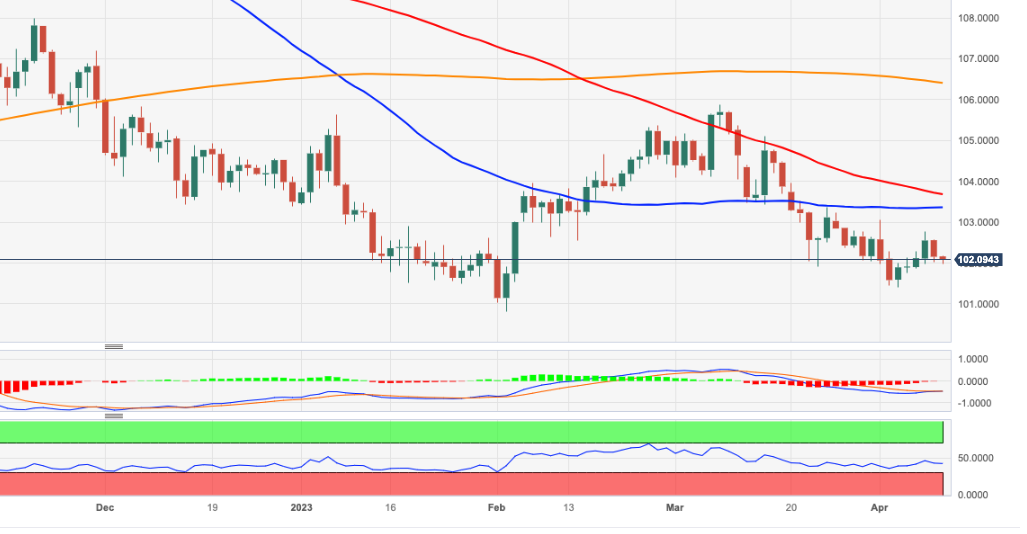
-
12:25
USD/CAD has peaked and will drift lower back towards 1.25 in the coming months – SocGen
Kit Juckes, Chief Global FX Strategist at Société Générale, analyzes the CAD outlook ahead of the Bank of Canada (BoC) interest rate decision.
USD/CAD and US rates – both have probably peaked
“No-one expects a change in rates. However, futures traders have built up the biggest short CAD position since January 2019, just after the last Fed rate hike of the cycle that started in late 2016. USD/CAD peaked above 1.36 after that hike, before falling in 2019.”
“USD/CAD tracks relative US-Canadian rates, but by far the biggest driver that spread is the trend in US rates.”
“We think USD/CAD has peaked and will drift lower back towards 1.25 in the coming months – even if sticky core CPI and a bland BoC policy statement don’t point to fireworks today.”
See – BoC Preview: Forecasts from eight major banks, staying on the sidelines
-
12:08
Stronger US CPI print poses upside risks for the USD, but recovery potential is limited – MUFG
The major foreign exchange rates have remained relatively stable ahead of the release later today of the latest US CPI report for March. A strong print could provide a boost to the greenback, but the upside potential is limited, economists at MUFG Bank report.
All eyes on US CPI report for fresh direction
“The US CPI report is expected to reveal that underlying inflation pressures remained uncomfortably strong at the start of this year.”
“While a stronger print poses upside risks for the US Dollar, ongoing fears over the negative fallout for the US economy from tighter credit conditions will continue to put a dampener on upside potential in the near-term.”
See – US CPI: Banks Preview, inflation softening, good news on the horizon?
-
12:04
Malaysia: Labour market near full employment- UOB
UOB Group’s Senior Economist Julia Goh and Economist Loke Siew Ting assess the latest jobs report in Malaysia.
Key Takeaways
“Malaysia’s unemployment rate declined further to 3.5% in Feb after holding unchanged at 3.6% since Oct 2022. This brings the labor market closer to full employment as Bank Negara Malaysia (BNM) has guided that the economy is technically at full employment if the national unemployment rate reaches 3.3% (average of 3.5% for the year). That said, Malaysia’s labour market is still some way from tightness given the record labour force participation rate, higher number of workers outside the labour force than pre-pandemic, and constrained wage growth.”
“Total employment breached another fresh record of 16.19mn in Feb after improving for 19th consecutive month by 30.0k or 0.2% m/m (Jan: +28.9k or +0.2% m/m to 16.16mn). All economic sectors reported a persistent increase in hiring, led by the services sector. Accordingly, the employment-to-population ratio hit an all-time high of 67.4% (Jan: 67.3%), indicating strong ability of Malaysia’s economy to create employment.”
“The recent performance of Malaysia’s labour market remains in line with our expectations amid continued government initiatives. A persistent upturn in tourism-related industries, which are anticipated to be further boosted by the resumption of China’s tourist arrivals, will continue to be the tailwinds for the nation’s labour market recovery ahead, together with compelling foreign direct investment inflows. They will also outweigh the lingering global macro headwinds and financial uncertainty at this juncture. We keep our year-end jobless rate projection of 3.2% for this year (vs BNM est: 3.3%, end-2022: 3.6%).”
-
12:00
United States MBA Mortgage Applications climbed from previous -4.1% to 5.3% in April 7
-
11:51
EUR/USD: Soft US CPI data needed to justify a move through 1.10 – SocGen
EUR/USD is dragged up by buoyant market sentiment. But the pair needs a soft US Consumer Price Index (CPI) report to break past the 1.10 level, Kit Juckes, Chief Global FX Strategist at Société Générale, reports.
EUR/USD needs more help from relative rates
“The MOVE index of bond volatility has fallen sharply from its March spike. With FX volatility at its lowest level of 2023 and the Vix falling, the SG Sentiment Indicator back into risk-seeking territory, helping EUR/USD as we head to today’s US CPI data.”
“However, sentiment can only do so much, and EUR/USD is rising more than relative rates warrant, so we will need soft CPI data to justify a move through 1.10. Our forecast of headline CPI falling to 5.1% YoY. while the core measure edges up to 5.6% wouldn’t be enough.”
See – US CPI: Banks Preview, inflation softening, good news on the horizon?
-
11:46
Gold Price Forecast: XAU/USD trades above $2,000 ahead of US CPI/FOMC minutes
- Gold price climbs to a fresh weekly high on Wednesday, though lacks follow-through.
- A softer US Dollar lends some support to the XAU/USD amid looming recession risks.
- The upside remains capped as traders await the US CPI report and the FOMC minutes.
Gold price scales higher for the second successive day and touches a fresh weekly high, around the $2,021 area on Wednesday, albeit lacks follow-through. The XAU/USD retreats to the $2,010 region during the first half of the European session as traders keenly await the release of the consumer inflation figures from the United States (US) and the Federal Reserve's (Fed) latest policy meeting minutes.
Focus remains on US consumer inflation and FOMC minutes
The crucial US Consumer Price Index (CPI) report will play a key role in influencing market expectations about the next policy move by the Fed. Furthermore, the Fed minutes will provide insight into how policymakers evaluated the need for higher rates despite the turmoil in the banking sector. This, in turn, should help investors to determine the near-term trajectory for the US Dollar (USD) and provide a fresh directional impetus to the non-yielding Gold price.
Recession fears act as a tailwind for Gold price
In the meantime, worries about a deeper global economic downturn, along with heightened US-China tensions over Taiwan, lend some support to the safe-haven XAU/USD. In fact, the International Monetary Fund (IMF) on Tuesday trimmed its 2023 global growth outlook, citing the impact of higher interest rates and fueling recession fears. Furthermore, Minneapolis Fed President Neel Kashkari warned that tightening credit conditions could lead to a recession.
Bets for another 25 bps Fed rate hikes cap the XAU/USD
The upside for the Gold price, however, remains capped amid the prospects for further policy tightening by the Fed. The markets are currently pricing in a greater chance of another 25 basis points (bps) rate hike at the next Federal Open Market Committee (FOMC) meeting in May. The bets were reaffirmed by hawkish comments by Philadelphia Fed Bank President Patrick Harker, saying that the US central bank is fully committed to bringing inflation back down to the 2% target.
Dips could be seen as a buying opportunity
This, for the time being, puts a floor under the US Treasury bond yields, which holds back traders from placing aggressive bearish bets around the USD and contributes to capping gains for the non-yielding Gold price. Nevertheless, the aforementioned fundamental backdrop suggests that the path of least resistance for the XAU/USD is to the upside. Hence, any meaningful corrective pullback is more likely to get bought into and is more likely to remain limited.
Gold price technical outlook
From a technical perspective, the daily swing high, around the $2,020-$2,021 area, now seems to act as an immediate hurdle ahead of the $2,032 region, or over a one-year high touched last week. A sustained strength beyond will be seen as a fresh trigger for bullish traders and allow Gold price to accelerate the momentum towards the $2,048-$2,050 intermediate resistance en route to the all-time high, around the $2,070-$2,075 region.
On the flip side, any meaningful pullback is more likely to find decent support near the $2,000-$1,990 area. A convincing break below should pave the way for a slide towards the $1,955-$1,950 region before the Gold price eventually drops to the next relevant support near the $1,935-$1,934 area. The corrective decline could get extended further towards the $1,918-$1,917 horizontal zone en route to the $1,900 round-figure mark.
Key levels to watch
-
11:42
Fading USD rallies in case of a stronger CPI report – TDS
US Consumer Price Index (CPI) and the Bank of Canada decision will take center stage today. Economists at TD Securities their implications for the US Dollar and the USD/JPY and USD/CAD pairs.
USD/CAD to stay within a 1.3380-1.3550 range
“We are hard-pressed to see the prevailing bias of fading USD extremes (rallies in the case of a stronger CPI report).”
“Much of FX has been directionless and we think this could persist until we obtain certainty over how Fed easing could take shape (which is still a ways away we think) and/or NFP materially weakens.”
“USD/JPY's bid into 134 is notable but is coalescing into a triangle pattern formed from the 2022 highs and 2023 uptrend support. A break of either would be meaningful but we reckon these technicals should hold for now.”
“Meanwhile, the BoC is expected to leave policy unchanged, and we would expect to see 1.3380/00/1.3550 as key technical markers that should hold.”
See:
- US CPI: Banks Preview, inflation softening, good news on the horizon?
-
BoC Preview: Forecasts from eight major banks, staying on the sidelines
-
11:30
USD/CAD to dip toward 200-DMA around 1.34 on underwhelming US CPI print – SocGen
Today, the US Bureau of Labor Statistics will publish March Consumer Price Index (CPI) data while the Bank of Canada (BoC) will announce its interest rate decision. Economists at Société Générale analyze how could the USD/CAD pair react to these high-tier events
BoC forecast to keep rate unchanged at 4.50%
“There should be no surprise today in Canada, where the central bank is forecast to keep rates on hold at 4.50% for the second meeting. Above-forecast GDP growth of 0.5% MoM in January, followed by another solid February output gain of 0.4% and decent March employment gains, reinforce the case for a hawkish pause.”
“A hot US CPI print would pose upside risk, but an underwhelming outcome could trigger short covering and guide the Loonie towards the 200-DMA at 1.3395.”
See:
- US CPI: Banks Preview, inflation softening, good news on the horizon?
-
BoC Preview: Forecasts from eight major banks, staying on the sidelines
-
11:21
Gold Price Forecast: XAU/USD reaction to US CPI to be anything but trivial – Commerzbank
Today’s Consumer Price Index (CPI) figures from the US Bureau of Labor Statistics are due out at 12:30 GMT. Economists at Commerzbank analyze how could Gold react to US inflation data.
Weaker than expected CPI to benefit XAU/USD
“Today’s reaction of the Gold price to the figures is likely to be anything but trivial.”
“It is true that a higher than anticipated inflation rate would fuel short-term rate hike speculation. However, this would not necessarily be bad news for Gold if such rate hikes were regarded as a policy error that could lead to a more pronounced weakening of the economy and thus a more pronounced interest rate turnaround at a later date. Higher inflation figures would only have a negative impact on XAU/USD if the market were to upwardly correct its interest rate expectations for the long term, too.”
“Weaker than expected price data would probably prove less ambivalent for the Gold price, on the other hand, as they would doubtless boost rate cut expectations and thus benefit the yellow metal.”
See – US CPI: Banks Preview, inflation softening, good news on the horizon?
-
11:14
GBP may struggle to keep the title of best performing G10 currency much longer – Rabobank
On a one-month view, the Pound is still the best performing G10 currency. However, GBP is now priced for a better UK economic outlook, leaving vulnerable to disappointing data, economists at Rabobank report.
GBP may now be more vulnerable to disappointments
“GBP’s stella performance in recent weeks is drawn from a series of better than expected UK economic data. That said, while this has justifiably led to a re-appraisal of GBP, it is possible that this move has now run its course. After all, while the economic outlook for the UK in 2023 is better than it was, it is far from strong and the recent adjustment in positioning means that GBP may now be more vulnerable to disappointments.”
“We maintain the view that GBP is likely to slowly grind lower vs. the EUR although we recently pushed out our EUR/GBP 0.90 forecast to nine months reflecting the less bad UK economic backdrop.”
-
11:02
EUR/HUF: Forint rally could end soon, but still popular within CEE region – ING
The Hungarian Forint has made by far the biggest gains against the Euro (5.8% excl. carry) in the EMEA space. Room for rally is shrinking but still the currency of choice for economists at ING.
EUR/USD will not deliver another significant boost anytime soon
“At the global level, EUR/USD will not deliver another significant boost anytime soon and the market has almost fully normalised after the March turmoil.”
“At the local level, we won't get much more positive from the energy story either. Moreover, the market positioning is becoming heavily long again in our view.”
“We believe the forint may touch 370 EUR/HUF in the foreseeable future, but 375 EUR/HUF will remain the point of gravity. Nevertheless, by far the highest carry in the region and the normalisation story after a negative year will, in our view, keep the Forint popular within the CEE region and thus continue to be our currency of choice.”
-
10:59
US Dollar stabilizes ahead of key US inflation data
- US Dollar has found its footing following Tuesday’s pullback.
- EUR/USD near-term technical outlook shows bullish bias stays intact.
- March inflation data from US could significantly impact US Dollar’s performance.
The US Dollar (USD) stays resilient on Wednesday after having weakened against its major rivals on Tuesday. Investors refrain from making large bets while awaiting March Consumer Price Index (CPI) data from the US.
Following a bullish start to the week, the US Dollar Index (DXY) turned south on Tuesday and declined toward 102.00. The mixed performance of Wall Street and the lack of action in the US Treasury bond yields, however, helped the USD limit its losses in the second half of the day. The CME Group FedWatch Tool shows that markets are pricing in a 67% probability of one more 25 basis points Federal Reserve (Fed) rate hike in May. March CPI could trigger a big action in the USD by influencing the Fed’s rate outlook.
Daily digest market movers: US Dollar awaits March inflation report
- Inflation in the US, as measured by the Consumer Price Index (CPI), is forecast to decline to 5.2% in March from 6% in February. The Core CPI, which excludes volatile food and energy prices, is expected to rise by 0.4% on a monthly basis, compared to the 0.5% increase recorded in February.
- Previewing the CPI data, “a smaller-than-expected increase will be welcomed and trigger optimism, yet it is worth remembering the Fed’s favorite inflation measure is still the Core PCE Price Index and the effects of CPI on financial boards will likely be short-lived,” says FXStreet Analyst Valeria Bednarik. “On the other hand, higher inflation data could boost concerns and end up favoring the US Dollar due to its safe-haven condition.”
- Economists at ING note that markets are increasingly doubtful that the Fed will be able to hike rates much further but add that the upcoming CPI report could change that stance.
- Earlier in the week, NY Fed’s latest consumer survey revealed that the one-year inflation expectation climbed to 4.7% in March from 4.2% in February.
- Federal Reserve Bank of Atlanta’s GDPNow model’s estimate for the first-quarter real Gross Domestic Product Growth (GDP) in the US rose to 2.2% from 1.5% on April 10.
- NY Fed President John Williams argued on Monday that the pace of Fed rate increases was not behind the issues surrounding the two collapsed banks back in March. On Tuesday, "we've gotten policy to a restrictive stance, now we need to watch the data on retail sales, CPI and others," Williams stated.
- The Fed will release the minutes of its March policy meeting later in the session.
- The US Bureau of Labor Statistics reported on Friday that Nonfarm Payrolls in the US rose by 236,000 in March, slightly below the market expectation of 240,000. February’s print of 311,000 got revised higher to 326,000 from 311,000.
- Wage inflation in the US, as measured by Average Hourly Earnings, declined to 4.2% on a yearly basis from 4.6% in February. The Unemployment Rate ticked down to 3.5% with the Labor Force Participation Rate improving to 62.6% from 62.5%.
Technical analysis: US Dollar is yet to outperform Euro
EUR/USD closed in positive territory above 1.0900 on Tuesday, snapping a two-day losing streak. Although the pair stays relatively quiet early Wednesday, the near-term technical outlook remains bullish with the Relative Strength Index (RSI) indicator on the daily chart holding comfortably above 50. Moreover, the gap between the 20-day Simple Moving Average (SMA) and the 50-day SMA continue to widen following the bullish cross that occurred on April 3.
EUR/USD is likely to face interim resistance at 1.0950 (static level) before targeting 1.1000 (end-point of the latest uptrend, psychological level) and 1.1035 (multi-month high set in early February).
On the downside, 1.0840 (20-day SMA) aligns as first support before 1.0800 (psychological level), 1.0740 (50-day SMA) and 1.0700 (100-day SMA).
How is US Dollar correlated with US stock markets?
Stock markets in the US are likely to turn bearish if the Federal Reserve goes into a tightening cycle to battle rising inflation. Higher interest rates will ramp up the cost of borrowing and weigh on business investment. In that scenario, investors are likely to refrain from taking on high-risk, high-return positions. As a result of risk aversion and tight monetary policy, the US Dollar Index (DXY) should rise while the broad S&P 500 Index declines, revealing an inverse correlation.
During times of monetary loosening via lower interest rates and quantitative easing to ramp up economic activity, investors are likely to bet on assets that are expected to deliver higher returns, such as shares of technology companies. The Nasdaq Composite is a technology-heavy index and it is expected to outperform other major equity indexes in such a period. On the other hand, the US Dollar Index should turn bearish due to the rising money supply and the weakening safe-haven demand.
-
10:41
Germany 30-y Bond Auction increased to 2.33% from previous 2.24%
-
10:39
US: Nonfarm Payrolls open the door to further tightening – UOB
Senior Economist at UOB Alvin Liew comments on the latest release of the US jobs report (Friday).
Key Takeaways
“The US exceeded expectations with 236,000 jobs added in Mar but that was still the lowest print since Dec 2020 while the jobless rate receded to 3.5% (after a brief uptick to 3.6% in Feb), as the unemployed numbers fell by 97,000 to 5.8 million and participation rate inched up to 62.5%. Wage growth continued but the pace was in line with forecast, and slower at 0.3% m/m, 4.2% y/y.”
“Wage growth staying further below 5% may give the Federal Reserve (Fed) some comfort the risk of wage-price spiral is not imminent, but the persistent tightness in some industry segments is likely to keep the Fed on track for one more hike in May.”
“We continue to assign a high probability the Fed will hike rates by another 25bps to 5.00-5.25% in 2/3 May 2023 FOMC.”
-
10:39
Loonie to benefit if the BoC were to sound more hawkish than the market expects – Commerzbank
The Bank of Canada (BoC) is widely expected to keep rates unchanged at 4.5%. Focus on the statement, Elisabeth Andreae, FX Analyst at Commerzbank, reports.
BoC rate pause likely to continue today
“It seems undisputed that the BoC will once again keep its key rate unchanged at 4.5% thus continuing its rate pause. The unanimous Bloomberg consensus as well as the OIS rate expectations point that way.
That means attention is therefore likely to focus on the statement and the new monetary policy report with the updated projections.”
“We see a good chance of a hawkish statement in which the BoC refers to the risks for inflation, underlines its willingness to act and keeps the door open for further tightening.”
“If the BoC were to sound more hawkish than the market expects this is also likely to be reflected in the OIS rate expectations, which would probably benefit the Loonie. Based on these the market is pricing in rate cuts from the autumn. If these were delayed, meaning a shift in expectations for higher key rates for a prolonged period of time that should support the Loonie.”
See – BoC Preview: Forecasts from eight major banks, staying on the sidelines
-
10:35
AUD/USD holds steady above mid-0.6600s, traders keenly await US CPI/FOMC minutes
- AUD/USD gains some positive traction for the second successive day, albeit lacks follow-through.
- A positive risk tone undermines the safe-haven Greenback and benefits the risk-sensitive Aussie.
- The upside remains capped as traders keenly await the US CPI report and FOMC meeting minutes.
The AUD/USD pair edges higher for the second successive day on Wednesday and holds steady above mid-0.6600s through the first half of the European session. Spot prices, however, lack follow-through buying or bullish conviction as traders keenly await the release of the latest US consumer inflation figures.
The crucial US CPI report, along with the FOMC minutes, will be looked upon for clues about the Federal Reserve's (Fed) future rate hike path, which, in turn, will influence the US Dollar (USD) and provide a fresh impetus to the AUD/USD pair. In the meantime, a generally positive risk tone is seen undermining the safe-haven Greenback and lending some support to the risk-sensitive Australian Dollar amid signs of improving ties with China. It is worth recalling that Australia and China - the major commodity trade partners - reached an agreement to resolve their dispute over barley imports.
That said, the prospects for further policy tightening by the Fed put a floor under the US Treasury bond yields and limit losses for the USD. Apart from this, worries about a deeper global economic downturn benefits the Greenback's safe-haven status and contributes to capping the AUD/USD pair. In fact, the International Monetary Fund (IMF) on Tuesday trimmed its 2023 global growth outlook, citing the impact of higher interest rates. Traders also seem reluctant to place aggressive bets and prefer to wait on the sidelines ahead of the key releases from the US, due later during the North American session.
From a technical perspective, the recent rejection slide from the very important 200-day Simple Moving Average (SMA) and a subsequent decisive break below the 0.6700 mark was seen as a fresh trigger for bearish traders. This further makes it prudent to wait for strong follow-through buying before confirming that the downward trajectory witnessed over the past week or so has run its course and positioning for any meaningful near-term appreciating move for the AUD/USD pair.
Technical levels to watch
-
10:07
US CPI: A high number risks supporting the Dollar into May – ING
Today's US March Consumer Price Index (CPI) release will shed light on whether inflation has turned the corner or the Fed needs to tighten further.
US March CPI to set the tone
“Core US CPI has been one of the biggest FX movers over the last 12 months and today's March release is expected to show another sticky 0.4% MoM reading. Sticky inflation is probably the biggest risk to the consensus views in the FX market right now that EUR/USD and USD/JPY end the year at 1.12 and 125, respectively.”
“Today sees the release of the 22 March FOMC minutes. Undoubtedly there will be a lot of noise in the minutes and it is unclear what they will mean for current market pricing of a final 25 bps hike in May (75% priced) and a subsequent 60 bps easing cycle by year-end.”
“Expect DXY to be driven by any surprises on the March CPI today and the sharper reaction (risk negative, Dollar rally) would probably come on an upside surprise.”
See – US CPI: Banks Preview, inflation softening, good news on the horizon?
-
09:57
GBP/USD trades with modest losses around 1.2400, focus remains on US CPI/FOMC minutes
- GBP/USD meets with a fresh supply on Wednesday, albeit lacks follow-through.
- A combination of factors acts as a tailwind for the USD and exerts some pressure.
- Traders now look to the US CPI, BoE Governor Bailey’s speech and FOMC minutes.
The GBP/USD pair attracts some selling following an intraday uptick to the 1.2445 area and reverses a part of the previous day's strong move up. Spot prices drop to a fresh daily low during the early part of the European session, with bears now awaiting a sustained break below the 1.2400 round-figure mark before placing fresh bets.
The prospects for further policy tightening by the Federal Reserve (Fed) put a floor under the US Treasury bond yields and act as a tailwind for the US Dollar (USD), which, in turn, is seen weighing on the GBP{/USD pair. In fact, markets have been pricing in a greater chance of another 25 bps rate hike at the next FOMC meeting in May. The bets were reaffirmed by the overnight hawkish comments by Philadelphia Fed Bank President Patrick Harker, saying that the US central bank is fully committed to bringing inflation back down to the 2% target.
The British Pound, on the other hand, is pressured by the recent mixed signals from the Bank of England (BoE) policymakers over the next move. Apart from this, looming recession risks seem to benefit the Greenback's relative safe-haven status and exert some downward pressure on the GBP/USD pair. That said, growing acceptance that the Fed is nearing the end of its rate-hiking cycles is holding back the USD bulls from placing aggressive bets ahead of the release of the latest US consumer inflation figures and the FOMC meeting minutes later this Wednesday.
Investors will look for clues about the Fed's future rate-hike path, which will play a key role in influencing the near-term USD price dynamics and provide a fresh directional impetus to the GBP/USD pair. Apart from this, the BoE Governor Andrew Bailey's scheduled speech should contribute to producing short-term trading opportunities ahead of the UK GDP report on Thursday. Nevertheless, the aforementioned fundamental backdrop favours bearish traders and suggests that the path of least resistance for spot prices is to the downside.
Technical levels to watch
-
09:52
Gold Price Forecast: US CPI inflation and Retail Sales will provide guidance for further XAU/USD upside – ANZ
Gold price recovered after briefly dipping to $1,990 on Monday. Economists at ANZ Bank await the all-important United States Consumer Price Index and Retail Sales data to see if the yellow metal can enjoy further gains.
Weaker USD holds prices
“Weaker US Dollar and returning investment flows have been holding prices.”
“US CPI inflation and Retail Sales will be important for further upside move. US CPI data will provide a clearer indication of whether the Federal Reserve will lift rates further. At present a 25 bps increase is expected.”
See – US CPI: Banks Preview, inflation softening, good news on the horizon?
-
09:45
White House Sloat: Do not expect that Biden will discuss free trade agreement with the UK
Amanda Sloat, White House Foreign Affairs Committee member, said on Wednesday, “Do not expect that Biden will discuss free trade agreement with the UK.
Additional quotes
“We're continuously looking for ways to deepen economic engagement with the UK.”
“Biden's visit will underscore readiness of US to engage in further economic investment in Northern Ireland.”
Asked about leaked security documents, she said that “the US has been having engagements with broad number of allies and partners.”
-
09:39
USD/CNH: No changes to the consolidation theme – UOB
USD/CNH is still likely to maintain the 6.8500-6.9200 range for the time being, comment Economist Lee Sue Ann and Market Strategist Quek Ser Leang at UOB Group.
Key Quotes
24-hour view: “Our view yesterday was that USD ‘could test 6.9050 before the risk of a more sustained pullback increases’. Our expectation did not materialize as it traded quietly and in a tight range of 6.8861/6.8982 before closing largely unchanged at 6.8939 (+0.06%). Despite the quiet price actions, the underlying tone appears to be firm and we continue to see chance of USD testing 6.9050. The next resistance at 6.9200 is unlikely to come into view. On the downside, a break below 6.8800 (minor support at 6.8860) would indicate the current mild upward pressure has eased.”
Next 1-3 weeks: “USD traded sideways and in a quiet manner for the past few days. The consolidative price actions suggest further sideways trading, likely between 6.8500 and 6.9200.”
-
09:27
EUR/USD extends the weekly rebound past 1.0900 ahead of US data
- EUR/USD adds to Tuesday’s uptick north of 1.0900.
- The dollar remains offered amidst the lack of traction in yields.
- US CPI, FOMC Minutes next of note across the pond.
The buying interest around the European currency remains well and sound and lifts EUR/USD further north of 1.0900 the figure on Wednesday.
EUR/USD looks firm in pre-CPI trade
EUR/USD advances for the second session in a row and looks to consolidate the recent breakout of the key 1.0900 barrier amidst the persistent selling pressure surrounding the greenback.
Indeed, investors keep selling the dollar and favour further strength in the pair as speculation of another soft print in US inflation (due later) might reinforce the perception that the Fed could pause its hiking cycle in May.
From the ECB, there are no changes so far to the idea of a most likely 25 bps rate in May, a view that continues to be propped up by hawkish comments from ECB’s rate setters.
Nothing scheduled data wise in the old continent on Wednesday should leave the attention to the release of US CPI and the publication of the FOMC Minutes later in the NA session.
What to look for around EUR
EUR/USD advances beyond the 1.0900 hurdle in response to the renewed weakness in the buck and further recovery in the risk-linked complex.
In the meantime, price action around the single currency should continue to closely follow dollar dynamics, as well as the incipient Fed-ECB divergence when it comes to the banks’ intentions regarding the potential next moves in interest rates.
Moving forward, hawkish ECB-speak continue to favour further rate hikes, although this view appears in contrast to some loss of momentum in economic fundamentals in the region.
Key events in the euro area this week: Germany Final Inflation Rate, EMU Industrial Production (Thursday).
Eminent issues on the back boiler: Continuation, or not, of the ECB hiking cycle. Impact of the Russia-Ukraine war on the growth prospects and inflation outlook in the region. Risks of inflation becoming entrenched.
EUR/USD levels to watch
So far, the pair is gaining 0.10% at 1.0920 and a break above 1.0973 (monthly high April 4) would target 1.1032 (2023 high February 2) en route to 1.1100 (round level). On the flip side, the next support comes at 1.0788 (monthly low April 3) followed by 1.0747 (55-day SMA) and finally 1.0712 (low March 24).
-
09:22
EUR/USD will struggle to sustain a break above 1.10 this quarter – ING
EUR/USD is enjoying some gentle support as investors return from their Easter break. US Core CPI will be the key event of the day and will determine whether the pair has a chance of breaking above 1.10, economists at ING report.
1.10 should prove a tough nut to crack
“Two-year EUR:USD swap differentials are pretty steady at near 100 bps in favour of the Dollar. Perhaps we should not expect too much further narrowing now.”
“Two-year US Treasury yields are already trading at a 100 bps discount to the Fed funds rate, a discount which could move to 125 bps if the Fed hikes in May. Historically, the 125-150 bps marks a deep historic discount for US two-year yields, and much substantial further downside for two-year yields may only emerge when the Fed is ready or has started easing – probably in the fourth quarter.”
“Our base case is that EUR/USD will struggle to sustain a break above 1.10 this quarter.”
“EUR/USD to trade a 1.0900-1.0950 range into the pivotal US CPI release.”
-
09:09
USD/JPY eases from four-week high near 134.00, awaits US CPI and FOMC minutes
- USD/JPY climbs to a four-week high on Wednesday, though lacks follow-through.
- The fundamental backdrop still supports prospects for additional near-term gains.
- Traders now look to the US CPI and FOMC minutes for some meaningful impetus.
The USD/JPY pair touches a four-week high on Wednesday, albeit struggles to capitalize on the move and remains below the 134.00 mark through the early part of the European session.
The US Dollar (USD) languishes near the weekly low amid growing acceptance that the Federal Reserve (Fed) is nearing the end of its rate-hiking cycle and acts as a headwind for the USD/JPY pair. Apart from this, looming recession risks seem to benefit the safe-haven Japanese Yen (JPY) and further contribute to keeping a lid on the major. In fact, the International Monetary Fund (IMF) on Tuesday trimmed its 2023 global growth outlook, citing the impact of higher interest rates.
That said, the Bank of Japan's (BoJ) dovish near-term outlook continues to undermine the JPY and should help limit losses for the USD/JPY pair. It is worth recalling that the new BoJ Governor Kazuo Ueda said on Monday it was appropriate to maintain the ultra-loose stance as inflation has yet to hit 2% as a trend. In contrast, the current market pricing indicates a greater chance of a 25 bps lift-off at the next FOMC meeting in May and the bets were lifted by the upbeat US NFP report.
This, for the time being, puts a floor under the US Treasury bond yields and lends some support to the Greenback. Traders also seem reluctant to place aggressive bets and prefer to wait on the sidelines ahead of the latest US consumer inflation figures, due later during the early North American session. This will be followed by the FOMC minutes, which will be looked upon for clues about the future rate-hike path and play a key role in influencing the near-term USD price dynamics.
From a technical perspective, acceptance above 50 and 100-day Simple Moving Averages (SMAs) could be seen as a fresh trigger for bulls, suggesting that the path of least resistance for the USD/JPY pair is to the upside. Hence, any meaningful corrective pullback is more likely to attract fresh buying at lower levels and remain limited, at least for the time being.
Technical levels to watch
-
09:04
USD/JPY: A test of 134.40 remains on the cards – UOB
Further upside could see USD/JPY revisit the 134.40 region in the next few weeks, note Economist Lee Sue Ann and Market Strategist Quek Ser Leang at UOB Group.
Key Quotes
24-hour view: “Yesterday, we held the view that USD ‘is unlikely to advance much further’ and we expected it to consolidate and trade between 132.60 and 133.90. Our view of consolidation was not wrong even though USD traded in a narrower range than expected (132.96/133.80). Upward momentum appears to be building again but while USD is likely to trade with an upward bias, it is unlikely to break the major resistance at 134.40 today. Support is at 133.20, followed by 132.70.”
Next 1-3 weeks: “Our update from yesterday (11 Apr, spot at 133.30) is still valid. As highlighted, further USD strength is not ruled out but overbought short-term conditions could lead to a couple of days of consolidation first. Overall, as long as 132.20 (‘strong support’ level was at 132.00 yesterday) is not breached, USD could rise to 134.40 later on.”
-
09:01
Natural Gas Futures: Extra advances look out of favour
Open interest in natural gas futures markets dropped for the third straight session on Tuesday, now by around 14.7K contracts. In addition, volume reversed two daily builds in a row and shrank by around 23.7K contracts.
Natural Gas: Further consolidation seems the name of the game
Prices of the natural gas extended the weekly rebound on Tuesday. The uptick, however, was on the back of declining open interest and volume and suggests the a more serious recovery appears not favoured for the time being, leaving the current consolidation range well unchanged.
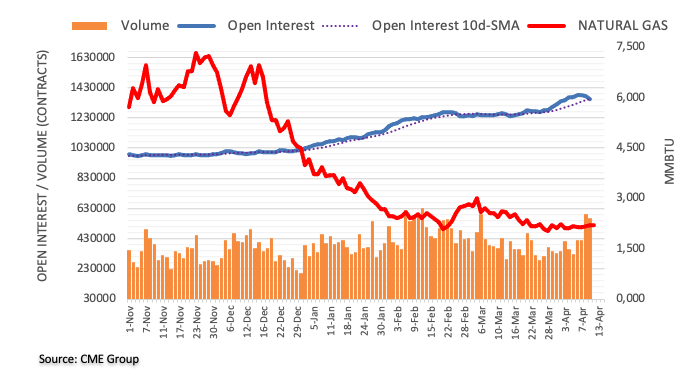
-
09:00
BoC Preview: Three scenarios and their implications for USD/CAD – TDS
Economists at TD Securities discuss the Bank of Canada (BoC) interest rate decision and its implications for the USD/CAD pair.
Hawkish Hold (10%)
“Walking a tight rope. BoC keeps overnight rate at 4.50% as outlook evolves in line with January MPR. Statement notes Q1 GDP strength and exceptionally tight labour markets, which are increasingly problematic for inflation while downplaying global banking stress as an external development. 2023 GDP growth revised higher in April MPR while forward guidance unchanged from March. USD/CAD -0.50%.”
Base Case (80%)
Holding the line. BoC keeps overnight rate at 4.50% as outlook evolves in line with projections. Statement flags global banking stress as headwind to foreign demand, but notes Q1 has been stronger than expected. MPR revises 2024 GDP lower w/ 2023 unchanged. Forward guidance also unchanged, leaving conditional hold in place. USD/CAD -0.15%.”
Dovish Hold (10%)
“Closing door to hikes. BoC holds at 4.50% as statement downplays Q1 GDP strength and tight labour markets against easing capacity pressures and a softer global backdrop, while MPR revises 2023 GDP/CPI lower. Statement also alters forward guidance to remove reference to increasing rates further. USD/CAD +0.50%.”
-
08:50
AUD/USD has moved into a consolidative phase – UOB
In the opinion of Economist Lee Sue Ann and Market Strategist Quek Ser Leang at UOB Group, AUD/USD is seen trading within the 0.6600-0.6760 range in the near term.
Key Quotes
24-hour view: “Yesterday, we held the view that ‘the sharp rebound in AUD could extend but any advance is not expected to break above 0.6710’. We noted, ‘there is another resistance at 0.6680’. AUD rebounded to 0.6680 before easing off to end the day at 0.6654 (+0.17%). The price actions are likely part of a consolidation phase and today, we expect AUD to trade in a range of 0.6620/0.6690.”
Next 1-3 weeks: “We continue to hold the same view as Monday (10 Apr, spot at 0.6670) wherein the recent price actions are likely part of a consolidation phase and AUD is likely to trade in a range of 0.6600/0.6760 for the time being. ”
-
08:38
Stronger NOK over the course of 2023 as Norges Bank will do what it takes to control inflation – Commerzbank
The Norwegian Krone is under depreciation pressure following surprisingly high inflation. However, economists at Commerzbank expect the NOK to recover over the coming months on the back of hawkish Norges Bank’s statements.
Norway March inflation came in stronger than expected
“Contrary to expectations the inflation rate continued to rise in Norway in March. The Norwegian Krone eased to a new annual low at EUR/NOK levels above 11.50 and the Krone is thus amongst the worst performers of the year.”
“It would seem that traders now want to see a clear reversal in inflation rates before the Krone can benefit from Norges Bank’s hawkish comments.”
“We remain optimistic that in the end Norges Bank will do what it takes to control the inflation outlook and expect a stronger NOK over the course of the year.”
-
08:31
Silver Price Analysis: XAG/USD bulls retain control near YTD top, overbought RSI warrants caution
- Silver confirms a breakout through a multi-day-old trading range and touches a fresh one-year high.
- The RSI on the daily chart is flashing overbought conditions and warrants caution for bullish traders.
- Any corrective pullback below the $25.00 mark is more likely to get bought into and remain limited.
Silver gains strong follow-through traction on Wednesday and touches a fresh one-year high, around the $25.40 area during the early part of the European session. The white metal now seems to have confirmed a bullish breakout through a four-day-old trading band and seems poised to prolong its recent upward trajectory witnessed over the past month or so.
That said, Relative Strength Index (RSI) on the daily chart is already flashing overbought conditions and warrants some caution for bullish traders. Hence, it will be prudent to wait for some near-term consolidation or a modest pullback before positioning for any further near-term appreciating move for the XAG/USD. Meanwhile, any corrective decline is more likely to find decent support near the $25.00 psychological mark.
Sustained weakness below might prompt some technical selling and drag the XAG/USD towards the $24.30-$24.40 horizontal resistance breakpoint, now turned support. The said area should act as a pivotal point, which if broken decisively could make the commodity vulnerable to weaken below the $24.00 mark and test the $23.60-$23.55 support area before eventually dropping to the $23.15 zone en route to the $23.00 round figure.
On the flip side, momentum beyond the $25.40 area, or the YTD peak, could get extended and allow the XAG/USD to reclaim the $26.00 mark. The next relevant hurdle is pegged near the $26.20 area ahead of the $26.40-$26.50 zone, above which bulls could aim to challenge the 2022 swing high, just ahead of the $27.00 mark.
Silver daily chart
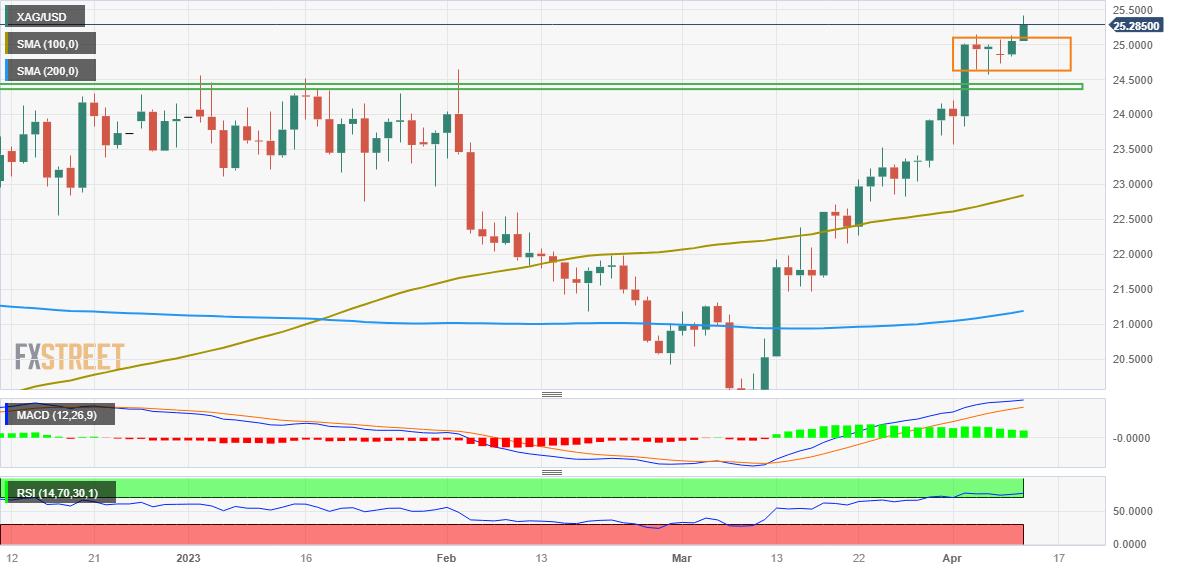
Key levels to watch
-
08:25
GBP/USD: Strong barrier seen at 1.25 – ING
GBP/USD snapped a four-day losing streak on Tuesday and closed the day above 1.2400. However, the pair is set to struggle at the 1.25 hurdle, economists at ING report.
Higher EUR/GBP if Bailey gives a nod to a pause in May
“Governor Andrew Bailey speaks in Washington today. There is a risk that he hints at a pause, having seen fellow central bankers in Australia and Canada do so over recent months.”
“US CPI and Governor Bailey's speech should be the key drivers today. We see 1.25 as a strong barrier for GBP/USD and favour EUR/GBP higher – especially if the BoE governor gives a nod to a pause in May.”
-
08:17
Strong inflation data should support the Dollar, but any rally set to end early – Commerzbank
US inflation data and FOMC minutes might provide momentum for the Dollar today, Esther Reichelt, FX Analyst at Commerzbank, reports.
EUR/USD unlikely to break out of its 1.08-1.10 range on inflation data
“The higher inflation will be, the stronger arguments in favour of a further rate hike would be. Strong inflation data today should therefore support the Dollar accordingly, as a further rate hike is increasingly being priced in by the market but not completely yet. I would be surprised though if the inflation data would cause EUR/USD to break out of its 1.08-1.10 range today.”
“Whereas the Fed sees no scope for rate hikes this year the market expects lower Fed rates as early as the second half of the year presumably to counteract an excessive tightening of financing conditions. As today’s inflation rates are unlikely to affect this view any USD rally is likely to end early.”
“We do not assume that the discrepancy between Fed and market expectations will end today or in the near future. However, while it remains in place this results in significant risks for the Dollar. As our economists do not expect a rate cut for this year either we see potential for a setback in EUR/USD in principle.”
See – US CPI: Banks Preview, inflation softening, good news on the horizon?
-
07:59
EUR/JPY: Forthcoming growth downturn favours a multi-quarter drop to 135 – ING
EUR/JPY briefly traded below 139 at the height of the US banking crisis only to trade to 145 as conditions settled. Economists at ING expect the pair to drop substantially toward 135 in the coming quarters.
Downside looks more inviting
“We suspect the risk environment remains fragile – the KBW US Regional Banking index continues to drop – and that EUR/JPY can turn lower again.”
“We look for 25 bps hikes from the ECB in May and June, but no cuts until the third quarter of next year. The BoJ is at the other end of the spectrum, turning less dovish and possibly even hiking rates early in 2024.”
“EUR/JPY is normally a good barometer for global growth and the forthcoming downturn favours a multi-quarter drop to 135.”
-
07:56
NZD/USD struggles to capitalize on recovery from multi-week low, remains below 0.6200
- NZD/USD stages a modest bounce from a nearly four-week low touched earlier this Wednesday.
- A modest USD weakness lends some support, though looming recession risks act as a headwind.
- Investors also seem reluctant ahead of the crucial US CPI report and the FOMC meeting minutes.
The NZD/USD pair rebounds from a nearly four-week low touched this Wednesday, albeit struggles to capitalize on the move and trades below the 0.6200 mark during the early European session.
The US Dollar (USD) languishes near the weekly low amid growing acceptance that the Federal Reserve (Fed) is nearing the end of its rate-hiking cycle and assists the NZD/USD pair to attract some buying in the vicinity of mid-0.6100s. Traders, meanwhile, are still pricing in a greater chance of a 25 bps lift-off at the next FOMC meeting in May. This, for the time being, puts a floor under the US Treasury bond yields, which acts as a tailwind for the Greenback.
Apart from this, worries about a deeper global economic downturn lend some support to the safe-haven buck and contribute to capping the risk-sensitive Kiwi. In fact, the International Monetary Fund (IMF) on Tuesday trimmed its 2023 global growth outlook, citing the impact of higher interest rates. Furthermore, Minneapolis Fed President Neel Kashkari warned that tightening credit conditions due to monetary policy actions could lead to a recession.
Traders also seem reluctant to place aggressive directional bets and prefer to move to the sidelines ahead of the US consumer inflation figures, due later during the early North American session. This will be followed by the FOMC meeting minutes, which will be looked upon for clues about the Fed's rate-hike path. The key releases will play a key role in influencing the near-term USD price dynamics and determining the next leg of a directional move for the NZD/USD pair.
From a technical perspective, acceptance below the 0.6200 round figure could be seen as a fresh trigger for bearish traders and supports prospects for further losses. That said, the emergence of some buying at lower levels warrants some caution. This mixed technical setup makes it prudent to wait for some follow-through buying before confirming that the recent pullback from the 0.6380 area, or the highest level since February 14 has run its course and positioning for any further gains.
Technical levels to watch
-
07:55
USD/JPY Price Analysis: Yen bulls take a breather on their way to 134.50
- USD/JPY remains sidelined after rising to the highest levels in one month.
- Upbeat oscillators, clear break of the key DMAs keep Yen pair buyers hopeful.
- Descending resistance line from late October 2022 challenges USD/JPY bulls ahead of 200-DMA.
- Bears need validation from 133.25 to aim for three-month-long rising support line.
USD/JPY picks up bids to reverse the early Asian session pullback from a one-month high as it prints mild gains around 133.80 amid the initial hours of Wednesday’s European trading session.
In doing so, the Yen pair rises for the fifth consecutive day even as bulls pause around the multi-day top.
The quote’s latest run-up could be linked to the bullish MACD signals and the upbeat RSI (14) not overbought. More importantly, a clear upside break of the 100-DMA and 50-DMA convergence, near 133.35-25, keeps the USD/JPY buyers hopeful.
However, a downward-sloping resistance line from October 2022, around 134.50 by the press time, appears a tough nut to crack for the Yen pair buyers.
Following that, the 200-DMA hurdle of around 137.20 acts as the last defense of the USD/JPY bears.
On the flip side, a daily closing below the previously stated DMA confluence, near 133.35-25, could quickly drag the USD/JPY prices towards a three-month-long ascending support line, close to 131.10 at the latest.
Above all, a horizontal area comprising multiple lows marked since early January, near 129.50, becomes a crucial support for the USD/JPY bears to watch as a break of which can challenge the Year-To-Date (YTD) low of 127.21 marked in January.
USD/JPY: Daily chart
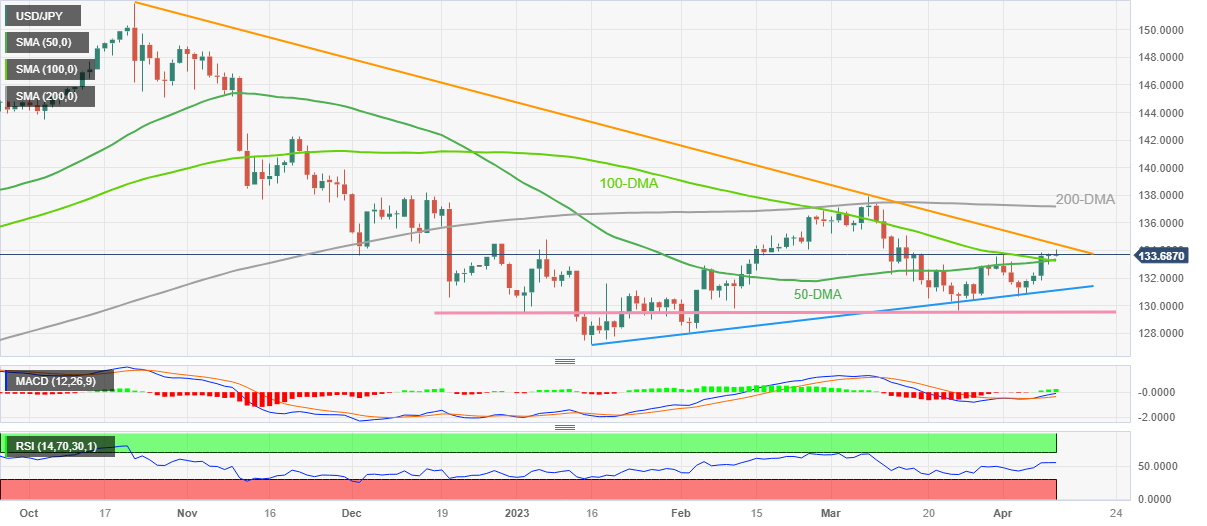
Trend: Limited upside expected
-
07:41
Forex Today: US inflation data to reinject volatility into markets
Here is what you need to know on Wednesday, April 12:
Markets stay relatively quiet early Wednesday as investors move to the sidelines while waiting for the high-tier events that are likely to ramp up volatility. The US Bureau of Labor Statistics will publish March Consumer Price Index (CPI) data, the Bank of Canada (BOC) will announce its interest rate decision and the US Federal Reserve will release the minutes of its March policy meeting.
The US Dollar struggled to stay resilient against its rivals on Tuesday as markets refrained from betting on a 25 basis points Fed rate hike before seeing inflation figures for March. Meanwhile, Wall Street's main indexes closed mixed. Early Wednesday, US stock index futures trade flat, reflecting a cautious market stance. On Tuesday, Federal Reserve (Fed) Bank of New York President John Williams said that one more rate hike would a reasonable starting place but acknowledged that they will have to lower rates if underlying inflation comes down.
US CPI Preview: US Dollar on the back foot and poised to fall further.
EUR/USD took advantage of the broad-based US Dollar weakness and erased all of Monday's losses on Tuesday. Early Wednesday, the pair trades in a relatively tight range above 1.0900.
GBP/USD snapped a four-day losing streak on Tuesday and closed the day above 1.2400. Although the pair rose toward 1.2450 in the early Asian session on Wednesday, it lost its bullish momentum and retreated to the 1.2420 area in the European morning.
USD/CAD came under bearish pressure on Tuesday and lost nearly 50 pips amid the US Dollar weakness and rising crude oil prices. The pair trades near 1.3450 early Wednesday. The BOC is widely expected to leave its policy rate unchanged at 4.5%. BOC Governor Tiff Macklem will comment on the policy outlook and respond to questions in a post-meeting press conference.
Bank of Canada Preview: Sitting on the sidelines amid looming recession risks.
AUD/USD is having a difficult time making a decisive move in either direction and moving up and down in a narrow range below 0.6700 mid-week. In the early Asian session on Thursday, March jobs data from Australia will be watched closely by market participants.
Australian Employment Preview: Could another positive report help the Aussie?
Following Monday's sharp upsurge, USD/JPY stayed in a consolidation phase on Tuesday and closed virtually unchanged. The pair extends its sideways grind slightly above 133.50 on Wednesday. The data from Japan showed that Machine Orders contracted by 4.5% on a monthly basis in February.
Gold price has gathered bullish momentum and reclaimed $2,000 on Tuesday. Early Wednesday, XAU/USD continues to push higher and was last seen trading in positive territory above $2,010.
Bitcoin extended its rally and touched a fresh multi-month high $30,585 on Tuesday before staging a technical correction. At the time of press, BTC/USD was down nearly 1% on the day at $29,900. Ethereum lost 1% on Tuesday and broke below $1,900 on Wednesday. ETH/USD was last seen losing 1.3% on a daily basis at $1,865.
-
07:35
FX option expiries for Apr 12 NY cut
FX option expiries for Apr 12 NY cut at 10:00 Eastern Time, via DTCC, can be found below.
- EUR/USD: EUR amounts
- 1.0900-10 2.7b
- 1.0940-50 640m
- GBP/USD: GBP amounts
- 1.2300 692m
- USD/JPY: USD amounts
- 132.00 732m
- 132.15-25 863m
- 134.10-15 1.1b
- AUD/USD: AUD amounts
- 0.6700 545m
- 0.6750 1.2b
- USD/CAD: USD amounts
- 1.3800 582m
- EUR/GBP: EUR amounts
- 0.8755-70 480m
- 0.8795-10 595m
-
07:33
USD/CHF Price Analysis: Bears approach 0.8990 within falling wedge
- USD/CHF holds lower grounds inside two-month-old bullish chart pattern.
- Downbeat MACD, RSI (14) suggest break of wedge towards the south.
- Four-month-long descending support line lures Swiss Franc bears; buyers need validation from 100-DMA
USD/CHF remains pressured around the intraday low of around 0.9020 heading into Wednesday’s European session. In doing so, the Swiss Franc (CHF) pair sellers approach the lower line of the two-month-old falling wedge bullish chart pattern.
It’s worth noting that the bearish MACD signals and an absence of oversold RSI (14) keep USD/CHF pair sellers hopeful of breaking the immediate support, namely the stated wedge’s lower line, around 0.8990 by the press time.
In a case where USD/CHF drops below 0.8990, the June 2021 low near 0.8925 holds the key to the quote’s further downside. A break that increases the odds of witnessing another fall towards a downward-sloping support line from early November 2022, around 0.8745 at the latest.
Alternatively, an upside clearance of the stated wedge’s top line, around 0.9100, confirms the bullish chart formation suggesting a theoretical target of around 0.9530.
During the run-up, the USD/CHF bulls need validation from the 100-DMA hurdle of near 0.9265.
Also acting as an upside filter is the previous monthly high of 0.9438.
Overall, USD/CHF remains on the bear’s radar while targeting a fresh 2023 low. However, the downside room appears limited unless the quote breaks 0.8925 mark.
USD/CHF: Daily chart

Trend: Further downside expected
-
07:29
BoC Preview: Forecasts from eight major banks, staying on the sidelines
The Bank of Canada (BoC) is set to announce its interest rate decision on Wednesday, April 12 at 14:00 GMT and as we get closer to the release time, here are the expectations as forecast by the economists and researchers of eight major banks, regarding the upcoming announcement.
The BoC is likely to leave the overnight target rate unchanged at 4.50% for the second straight meeting in April. The BoC’s updated projections and Macklem’s words are set to offer fresh cues on policy path.
ING
“The BoC is widely expected to leave rates unchanged having signalled that rates are already likely at the peak. The downside risks for global growth in the wake of recent banking turmoil only make it more likely that the next move from the central bank will be an interest rate cut.”
TDS
“We expect the BoC to hold the overnight rate unchanged at 4.50%, as the Bank balances strong Q1 GDP tracking with soft survey data and the uncertain impacts of US banking turmoil. Forward guidance should remain open-ended.
RBC Economics
“The BoC likely won’t make any change to the overnight interest rate. The central bank is widely expected to make a second consecutive decision to hold. This is despite economic growth that’s been more resilient than expected so far this year. So why hold interest rates again when the economy is still running hot? Inflation (and the broader economy) are still running too hot for the BoC to actively consider cutting interest rates but staying on the sidelines, for now, looks like an easy decision to make.”
NBF
“We expect the BoC to keep its policy rate unchanged at 4.50% as it did back in February. In its statement, the Bank is likely to stress the conditionality of its pause and it should leave the door open to further rate increases if needed to get inflation back to target.”
CIBC
“There won’t be any surprises for markets if, as we expect, the BoC leaves rates unchanged. But there’s just too much momentum in recent indicators for the Bank to eliminate its warning that additional hikes could still be required. There could be some acknowledgement that the non-inflationary level for real GDP could be higher than their last estimate, given the population and labour force surge we’ve just seen. We’re also due for an update of the neutral rate. The Fed’s policy committee left the ‘long run’ projection for the Fed funds rate unchanged at 2.5%, and that has a major impact on the Canadian neutral rate calculation by the BoC, which could therefore retain that same figure as the midpoint of its estimated range.”
BBH
“BoC is expected to keep rates steady at 4.5%. A cut seems very unlikely, especially after last week’s solid jobs report for March. Looking ahead, between 2-3 cuts by year-end are still priced in, which is also highly unlikely.”
Wells Fargo
“We expect the BoC to hold its policy rate steady at 4.50% for the second meeting in a row. We do not expect the Bank of Canada to raise rates further, but nor do we expect the central bank will be in any rush to lower its policy rate either. For now, we see Bank of Canada monetary policy as comfortably on hold at the April monetary policy meeting.”
Citi
“BoC policy rates are very likely to remain on hold at 4.5% this week, despite increased uncertainty around the global growth outlook since the BoC’s last meeting on March 8. While the BoC should unsurprisingly express some caution over recent developments, we see hawkish risks for markets seemingly expecting a very dovish shift from the BoC with cuts in the policy rate sometime soon. Still sticky-strong core inflation, stronger than expected H1 growth, and further hikes from the Fed will likely lead the BoC to raise rates again in June. Higher growth forecasts and core inflation still running consistently in the 3.5-4% range imply hawkish risks for the adjustments in the policy statement. The characterization of inflation should continue to highlight both that 4-5% wage inflation and 3-month core inflation of around 3.5% are too strong to be consistent with the 2% inflation target. Hence, there should not be much change in the core message of the policy guidance, which should continue to say the Governing Council ‘is prepared to increase the policy rate further if needed to return inflation to the 2% target’.”
-
07:28
BoJ’s Uchida: Will continue monetary easing in order to achieve price stability target sustainably and stably
New Bank of Japan (BoJ) Deputy Governor Shinichi Uchida said on Wednesday, the central bank “will continue monetary easing in order to achieve price stability target sustainably and stably.”
Additional quotes
Japan's financial system is stable as a whole.
Japanese financial institutions have ample capital and fund-raising basis even under global tightening and various stress stemming from it.
Impacts are limited from heightening uncertainty over global financial system following western banking jitters.
Impacts are limited on Japanese financial institutions.
Japan's economy picking up and continue to recover ahead.
CPI gains will narrow towards the middle of this fiscal year due to govt steps to curb energy costs an reduction in effects from transferring costs.
Aiming to achieve price stability target involving wage rises.
-
07:18
Crude Oil Futures: Room for further gains
Considering advanced figures from CME Group for crude oil futures markets, open interest went up by just 30 contracts after two straight daily drops on Tuesday. In the same line, volume increased for the second session in a row, this time by around 184.4K contracts.
WTI now looks at the 200-day SMA
Prices of the WTI kept the positive tone on Tuesday and surpassed the $81.00 mark per barrel amidst increasing open interest and volume, opening the door to the continuation of the uptrend in the very near term and with the immediate target at the 200-day SMA at $83.26.
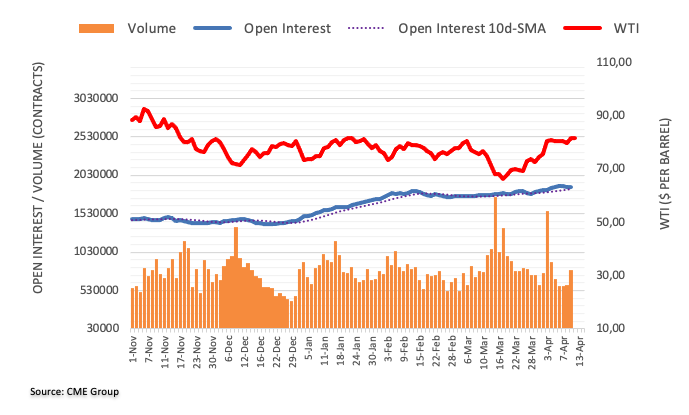
-
07:09
Gold Price Forecast: XAU/USD bulls eye $2,040 as US Dollar drops ahead of inflation data, Fed Minutes
- Gold price extends week-start rebound from 10-DMA to approach multi-day-old resistance line.
- Mostly downbeat Fed talks, market’s cautious optimism exert downside pressure on US Dollar and propel XAU/USD price.
- Softer US CPI, lack of clear guidance in FOMC Minutes can allow Gold buyers to keep the reins.
Gold price (XAU/USD) marches to $2,021 as it stretches the previous day’s run-up amid broad-based US Dollar weakness heading into Wednesday’s European session. In doing so, the XUA/USD also cheers the market’s hopes of easing inflation and less aggressive monetary policy from the US Federal Reserve (Fed). That said, traders await the US Consumer Price Index (CPI) for March and the Minutes of the latest Federal Open Market Committee (FOMC) Monetary Policy Meeting to gain major attention.
US Dollar Index (DXY) drops for the second consecutive day in the last six as market players curtail hawkish bets on the Fed’s 0.25% rate hike in May. As per the latest readings of the CME’s FedWatch Tool, market players place nearly 70% bets on the US central bank’s 25 basis points (bps) rate hike in May versus 72% expected the previous day.
Behind the traders’ recent easing of hawkish Fed bets are comments from key Federal Reserve (Fed) officials. Notable among them are Philadelphia Fed President Patrick Harker, New York Fed President John Williams and Chicago Fed President Austan Goolsbee.
Apart from the Fed talks, optimism surrounding China, one of the world’s largest Gold consumers, also propel the XAU/USD price. Early in Asia, IMF's Asia-Pacific Chief Krishna Srinivasan said that China rebounded much faster than anticipated, per Bloomberg.
It’s worth noting, however, that Minneapolis Fed President Neel Kashkari mentioned that he is less optimistic than the bond market on the speed of inflation's fall and challenge the US Dollar bears, especially after Friday’s upbeat US Nonfarm Payrolls (NFP). On the same line are the US inflation expectations, as per the 10-year and 5-year breakeven inflation rates from the St. Louis Federal Reserve (FRED) data, which renewed a one-week high the previous day.
Against this backdrop, S&P 500 Futures remain directionless around 4,138 after a mixed Wall Street close. Further, the US Treasury bond yields grind higher and prod the US Dollar sellers. That said, the US 10-year and two-year Treasury bond yields grind higher around 3.44% and 4.05% during a four-day and five-day uptrend respectively.
Looking forward, Gold buyers need softer US inflation numbers and an absence of future rate guidance from the Fed policymakers, per the FOMC minutes. If not, then the XAU/USD may portray another pullback from the key resistance line.
Gold price technical analysis
Gold price reverses the previous week’s pullback from an 11-week-old ascending resistance line as it bounces off the 10-DMA support.
The precious metal’s recovery also takes clues from the upbeat RSI (14), not overbought, while paying little heed to the sluggish MACD signals.
With this, the XAU/USD is well-set to poke the multi-day-old resistance line, around $2,038 by the press time. However, the RSI may turn overbought at that level and can challenge the Gold buyers afterward.
If not then, a gradual run-up toward the previous yearly high of around $2,070 can’t be ruled out.
Alternatively, a downside break of the 10-DMA support level of $1,996 isn’t an open invitation to the Gold sellers as an upward-sloping support line from March 22 joins a two-month-old horizontal line to highlight $1,960-57 zone as a tough nut to crack for the XAU/USD bears.
Overall, the Gold price is likely to remain firmer even if the upside room appears limited.
Gold price: Daily chart
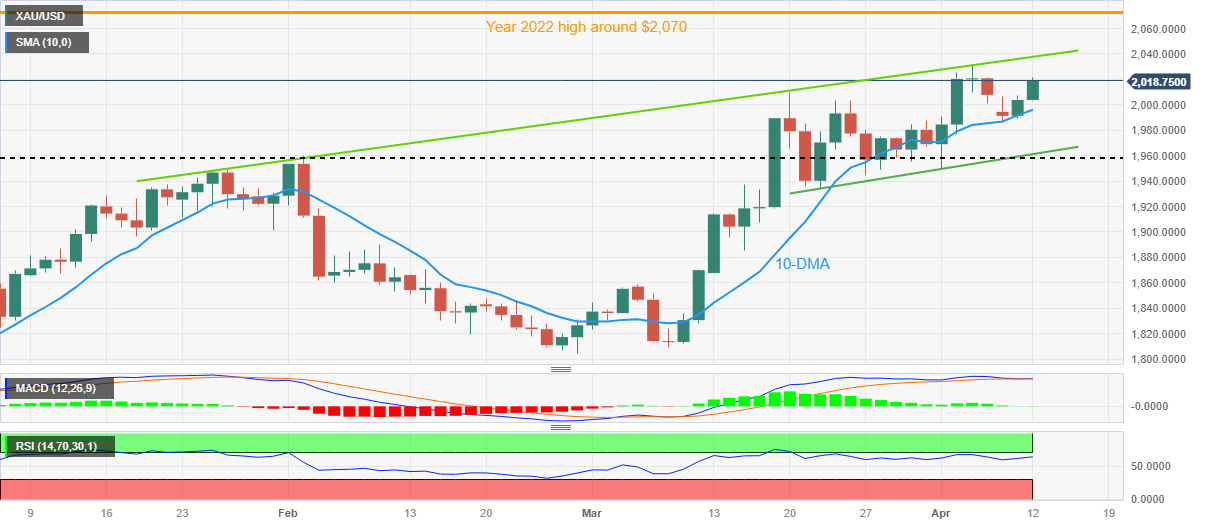
Trend: Limited upside expected
-
07:05
EUR/USD refreshes day’s high above 1.0930 as USD Index eyes further correction, US Inflation eyed
- EUR/USD has printed a fresh four-day high at 1.0935 as US Dollar corrects sharply ahead of US Inflation.
- Anticipation of the quick softening of US inflation has weighed heavily on the USD Index.
- The ECB would continue hiking rates as Eurozone inflation is extremely persistent.
The EUR/USD pair has printed a fresh four-day high at 1.0935 in the Asian session. A sell-off in the US Dollar Index (DXY) on expectations that the United States inflation will decelerate quickly has bolstered bullish bias for the major currency pair. The USD Index has refreshed its day’s low at 102.02 and is expected to extend correction further as commentaries from Federal Reserve (Fed) policymakers have infused fresh blood into the risk-sensitive currencies.
S&P500 futures have continued to remain sideways as investors are awaiting some cues from the upcoming quarterly result season, indicating a quiet market mood. As per Refinitiv estimates, S&P500 are expected to report shrinkage in profits by 5.2% vs. a growth forecast of 1.4% anticipated at the start of the year. The downgraded forecast for S&P500 is backed by higher rates from the Fed and tight credit conditions from US commercial banks, which have squeezed advances to firms.
The USD Index is likely to be guided by the inflation data. Analysts at NBF expect “The energy component may have had a negative impact on the headline index as prices likely fell in both the gasoline and natural gas segment. Expected gains for shelter and used vehicles could still result in a 0.2% monthly increase in headline prices. The core index, for its part, could have increased 0.4% MoM, which would translate into a one-tenth increase in the annual rate to 5.6%.”
On the Eurozone front, weak Retail Sales data have failed to impact the decision of further rate hikes from the European Central Bank (ECB). monthly Retail Sales contracted by 0.8% as expected by investors. And, annual Retail Sales contracted by 3.0% while the street was anticipating more contraction to 3.5%. ECB Governing Council member Francois Villeroy de Galhau warned that “Inflation is becoming more prevalent and potentially more persistent.” He further added, “The impact of rate hikes will be amplified in the coming months.”
-
07:00
CPI Data Expectations: Analyzing March US Inflation
- Annualized Consumer Price Index in the US is expected to decline to 5.2% in March.
- Core CPI is forecast to edge higher to 5.6% YoY in March from February’s 5.5%.
- US CPI could influence Fed’s rate outlook and impact US Dollar’s valuation in a significant way.
The Consumer Price Index (CPI) data release for March, published by the US Bureau of Labor Statistics (BLS), is scheduled for April 12 at 12:30 GMT. The US Dollar (USD) has been struggling to gather bullish momentum despite having outperformed its major rivals for a couple of days following the upbeat March jobs report. Markets are still undecided regarding the Federal Reserve’s (Fed) next policy action and inflation developments could provide fresh clues.
What to expect in the next CPI data report?
On an annualized basis, the Consumer Price Index data is forecast to decline to 5.2% and the Core CPI, which excludes volatile food and energy prices, is expected to edge a tad higher to 5.6% from 5.5% registered in February.
Meanwhile, the headline CPI data is seen rising 0.3% MoM in February, compared with a 0.4% increase reported in February. Similarly, the Core CPI is projected to increase by 0.4% in the same period, down slightly from 0.5% previously.
The US CPI data will hold the utmost relevance, as the Federal Reserve tries to figure out whether another rate hike will be needed to bring inflation back down to the 2% target. Renewed concerns over the negative impact of rising interest rates on financial stability following the collapse of Silicon Valley Bank forced the Fed to adopt a cautious stance at its last policy meeting on March 22. The Fed hiked its policy rate by 25 basis points (bps) to the range of 4.75%-5% as expected but noted that tighter credit conditions are expected to weigh on economic activity, hiring and inflation.
Economists at Commerzbank see the potential for an extended recovery in the US Dollar:
“A relatively more restrictive Fed with an accompanying fall in inflation would be ideal. Let us not forget: in itself a fall in inflation (i.e. a reduced erosion of the Dollar’s domestic purchasing power) is a positive argument for the currency involved. Only a negative rate outlook might affect this image or might even reverse the situation. If that does not arise this is the best imaginable situation for USD bulls.”
When is the Consumer Price Index report and how could it affect EUR/USD?
The Consumer Price Index data report is scheduled for release at 12:30 GMT, on April 12. A softer-than-expected reading, especially in the monthly core inflation, could revive expectations for the Fed to keep its policy rate unchanged at the upcoming meeting.
While speaking at the post-meeting press conference in March, Federal Reserve Chief Jerome Powell said that the story on disinflation was intact. Although Powell also reiterated that they are not yet seeing progress on core services inflation ex-housing, he acknowledged that they need to be alert when thinking about further rate hikes given the potential impact of credit tightening on the economy.
On the other hand, the March jobs report revealed that Nonfarm Payrolls rose by 236,000 in March, slightly below the market expectation of 240,000. Additionally, the Unemployment Rate edged lower to 3.5% while the annual wage inflation, as measured by the Average Hourly Earnings, edged lower to 4.2% from 4.6%. One could argue that the US labor market remains relatively healthy but there are signs of softening. Hence, March CPI data could help investors decide if they should bet on one more Fed rate increase. According to the CME Group FedWatch Tool, the probability of a 25 bps rate hike currently sits at around 70%.
In case of a disappointing CPI print, the US Dollar will likely see a fresh leg lower, allowing the EUR/USD pair to regather bullish momentum. Conversely, a surprisingly hotter US CPI reading is likely to reaffirm another 25 bps Fed hike and provide a boost to the USD, forcing EUR/USD to turn south.
FXStreet Analyst Eren Sengezer offers a brief technical outlook for the major and explains: “EUR/USD’s bullish bias stays intact in the near term as the 20-day Simple Moving Average (SMA) continues to pull away from the 50-day SMA following the bullish cross seen in early April. Furthermore, the Relative Strength Index (RSI) indicator on the daily chart holds comfortably above 50, highlighting the lack of seller interest.
Eren also outlines important technical levels for the EUR/USD pair: “On the upside, interim resistance seems to have formed at 1.0950/60 area. Once the pair clears that levels and confirms it as support, 1.1000 (psychological level) aligns as the next bullish target before 1.1035 (2023 high) and 1.1100 (psychological level, static level). On the downside, a daily close below 1.0800 (20-day SMA) could ramp up the bearish pressure and open the door for an extended slide toward 1.0740 (50-day SMA) and 1.0700 (100-day SMA).”
CPI data related content
- US CPI Preview: US Dollar on the back foot and poised to fall further
- Markets quiet ahead of US CPI and FOMC Minutes tonight, Q1 earnings season starts this week
- Gold Price Forecast: XAU/USD could retest yearly top at $2,032 on soft United States inflation data
About the Consumer Price Index
The Consumer Price Index released by the US Bureau of Labor Statistics is a measure of price movements by the comparison between the retail prices of a representative shopping basket of goods and services. The purchasing power of USD is dragged down by inflation. The CPI is a key indicator to measure inflation and changes in purchasing trends. Generally speaking, a high reading is seen as positive (or bullish) for the USD, while a low reading is seen as negative (or Bearish),.
-
06:58
Gold Price Forecast: XAU/USD looks to challenge the $2,032 hurdle amid bullish daily technical indicators
Gold price is extending the previous rebound above the $2,010 mark. XAU/USD could retest yearly top at $2,032, FXStreet’s Dhwani Mehta reports.
United States Consumer Price Index in the spotlight
“Gold bulls are extending their control while challenging the $2,020 round level. A sustained move above the latter will put the focus back on the $2,032 year high. Weak US CPI data could help Gold buyers achieve that target, with eyes set on the $2,043 pennant target.”
“Hot US inflation data is needed to reinstate Gold sellers, with the immediate support seen at the intersection of the pennant resistance and support at around $1,982. The correction could resume toward the April 4 low at $1,977, thereafter, where the 21-Daily Moving Average (DMA) aligns. Further south, the $1,970 and $1,960 static supports could come to the rescue of Gold optimists.”
See – US CPI: Banks Preview, inflation softening, good news on the horizon?
-
06:44
Asian Stock Market: Shows mixed response ahead of US Inflation, oil near two-month high
- Asian equities are showing mixed responses ahead of US inflation data.
- Japanese equities are showing resilience as the BoJ is required to infuse more stimulus to keep inflation steadily higher.
- Oil prices have soared to near a two-month high around $81.75 as the street is anticipating a quick softening of US inflation.
Markets in the Asian domain are showing mixed responses ahead of United States inflation data. S&P500 futures are choppy in early trade as investors are anxious ahead of US Consumer Price Index (CPI) and quarterly result season. The street is divided about the US result season as one class of investors believe the higher rates from the Federal Reserve (Fed) and banking crisis have hit overall demand while the other school of thought believes that robust requirement of labor is the outcome of upbeat retail demand.
The US Dollar Index (DXY) is prone to test the immediate support of 102.00 as Fed policymakers have advised maintaining caution while considering May’s monetary policy. Chicago Fed President Austan Goolsbee has advised a cautious approach as the combination of tight credit conditions and further restrictive monetary policy can hit sectors and regions differently than if monetary policy was acting on its own.
At the press time, Japan’s Nikkei225 jumped 0.61%, ChinaA50 dropped 0.52%, Hang Seng tumbled 0.74%, KOSPI gained 0.21%, and Nifty50 added 0.16%.
Japanese equities are showing resilience as the Bank of Japan (BoJ) is required to infuse more stimulus into the economy to keep inflation steadily above the desired rate. Meanwhile, monthly Producers Price Index (PPI) numbers have shown a stagnant performance as expected by market participants. While annual PPI softened further to 7.2% from the prior release of 8.0% but remained higher than the consensus of 7.1%. This conveys the inability of firms in hiking the prices of goods and services amid weaker retail demand despite an increase in wage growth.
Chinese stocks have hogged the limelight despite investors losing confidence in stellar economic recovery. The economy is in a disinflationary process due to weak retail demand. China’s Consumer Price Index (CPI) is continuously declining despite monetary support from the administration after lifting Covid controls.
On the oil front, oil prices have soared to near two-month high around $81.75 as the street is anticipating a quick softening of US inflation after commentary from Minneapolis Fed Bank President Neel Kashkari. Fed policymaker sees inflation at the middle 3% by end of this year, closer to 2% next year.
-
06:43
GBP/USD clings to the near-term consolidative phase – UOB
GBP/USD should remain side-lined between 1.2330 and 1.2520 for the time being, according to Economist Lee Sue Ann and Market Strategist Quek Ser Leang at UOB Group.
Key Quotes
24-hour view: “Yesterday, we noted that ‘the rebound in oversold conditions suggests GBP is unlikely to weaken further’ and we expected GBP to consolidate and trade between 1.2355 and 1.2450. GBP subsequently traded in a narrower range than expected (1.2383/1.2452). The price actions lack directions and we expect GBP to trade in a range today, likely between 1.2390 and 1.2450.”
Next 1-3 weeks: “We continue to hold the same view as Monday (10 Apr, spot at 1.2425). As highlighted, GBP is likely to consolidate between 1.2330 and 1.2520 for the time being.”
-
06:41
RBA’s Bullock: We would have paused on rates even without global banking stress
Reserve Bank of Australia (RBA) Deputy Governor, Michele Bullock, is participating in a panel discussion titled "Monetary policy since the pandemic: What lessons have we learned?" at the Western Economic Association International Conference, in Melbourne.
Key quotes
We would have paused on rates even without global banking stress.
Rates are in restrictive territory, we can stop for a minute and watch.
Want to get inflation down and keep progress made on employment.
No sign domestic banks are tightening lending due to global stress.
-
06:39
USD Index appears offered around 102.00 ahead of US CPI, FOMC Minutes
- The index remains on the defensive and hovers around 102.00.
- Bets on a 25 bps rate raise by the Fed in May remain on the rise.
- US inflation figures tracked by the CPI will take centre stage.
The greenback, in terms of the USD Index (DXY), adds to Tuesday’s losses and keeps the trade around the 102.00 neighbourhood on Wednesday.
USD Index focuses on inflation
The index remains under pressure and continues to fade Monday’s uptick, this time putting the 102.00 zone to the test ahead of the publication of key US inflation figures for the month of March due later in the NA session.
In the meantime, US yields extend further the gradual recovery seen as of late against the backdrop of increasing speculation of another 25 bps rate hike by the Federal Reserve at the May 3 gathering.
Other than the release of the inflation readings, investors will closely follow the publication of the FOMC Minutes of the March meeting, while MBA Mortgage Applications will also complete the calendar on Wednesday.
What to look for around USD
Price action around the index shows some weakness and forces the dollar to retreat to the 102.00 zone on Wednesday, all in response to the rejection from Monday’s tops near 102.80.
The recent marked recovery in the dollar has been underpinned by the loss of momentum in the view that the Federal Reserve could make an impasse in its current tightening bias in May, which has been also propped up by persevering disinflation, nascent weakness in some key fundamentals and fresh concerns surrounding the banking sector
Key events in the US this week: MBA Mortgage Applications, Inflation Rate, Monthly Budget Statement, FOMC Minutes (Wednesday) – Producer Prices, Initial Jobless Claims (Thursday) – Retail Sales, Industrial Production, Advanced Michigan Consumer Sentiment, Business Inventories (Friday).
Eminent issues on the back boiler: Persistent debate over a soft/hard landing of the US economy. Terminal Interest rate near the peak vs. speculation of rate cuts in 2024. Fed’s pivot. Geopolitical effervescence vs. Russia and China. US-China trade conflict.
USD Index relevant levels
Now, the index is retreating 0.09% at 102.04 and the breach of 101.43 (monthly low April 5) would open the door to 100.82 (2023 low February 2) and finally 100.00 (psychological level). On the other hand, the next resistance level emerges at 103.05 (monthly high April 3) seconded by 103.67 (100-day SMA) and then 105.11 (weekly high March 15).
-
06:33
USD/CAD slides to 1.3450 on firmer Oil price, focus on BoC, US inflation and Fed Minutes
- USD/CAD prints three-day downtrend amid firmer Oil price, broad US Dollar weakness amid sluggish markets.
- Downbeat Fed signals join cautious optimism elsewhere to weigh on US Dollar.
- Oil price cheers softer greenback, hopes of more energy demand and supply crunch woes.
- BoC is likely to stand pat and may prod Loonie pair sellers but US inflation, FOMC Minutes are the key.
USD/CAD renews its weekly low around 1.3450 as it drops for the third consecutive day during early Wednesday in Europe.
The Loonie pair’s latest gains could be linked to the firmer prices of Canada’s main export item, namely WTI crude oil, as well as broad-based US Dollar weakness, ahead of the key catalysts. Among them, the Bank of Canada's (BoC) Interest Rate Decision, the US Consumer Price Index (CPI) for March and the Minutes of the latest Federal Open Market Committee (FOMC) Monetary Policy Meeting gain major attention.
That said, WTI crude oil clings to mild gains around $81.50 as optimism surrounding China, one of the world’s largest energy users, joins fears supply crunch led by the OPEC+ group. Also fueling the black gold prices could be the geopolitical tension emanating from Russia, China and North Korea.
Elsewhere, the US Dollar Index (DXY) extends the previous day’s losses towards 102.00 as the Federal Reserve (Fed) officials hint at softer inflation and weigh on the market’s bets of the US central bank’s 0.25% rate hike in May. That said, Minneapolis Fed President Neel Kashkari mentioned that he is less optimistic than the bond market on the speed of inflation's fall. However, Philadelphia Fed President Patrick Harker and New York Fed President John Williams previously signaled to ease inflation pressure and weighed on the market’s bets of the Fed’s 0.25% rate hike in May. With this, the CME’s FedWatch Tool suggests a 69.5% chance of the US central bank's hawkish action in the next monetary policy meeting versus 71.2% marked the previous day.
It should be noted that the International Monetary Fund’s (IMF) downward revision to the global growth forecasts and Friday’s upbeat US jobs report, as well as hopes of BoC’s inaction, keeps the USD/CAD buyers hopeful.
Amid these plays, S&P 500 Futures remain directionless around 4,138 after a mixed Wall Street close. Further, the US Treasury bond yields grind higher and prod the US Dollar sellers. That said, the US 10-year and two-year Treasury bond yields grind higher around 3.44% and 4.05% during a four-day and five-day uptrend respectively.
Looking ahead, USD/CAD traders should closely observe the BoC statement as the Canadian central bank has already signaled its hesitance in increasing the benchmark rates. Should the policymakers sound dovish, the Loonie pair may recover faster as the Oil price has recently signaled bullish exhaustion.
Also read: Bank of Canada Preview: Sitting on the sidelines amid looming recession risks
Technical analysis
A daily closing below the eight-month-old ascending support line, near 1.3440 by the press time, becomes necessary for the USD/CAD bears to keep the reins.
-
06:24
Gold Futures: Further gains in store near term
CME Group’s flash data for gold futures markets noted traders increased their open interest positions by around 2.5K contracts on Tuesday, reversing at the same time two consecutive daily drops. Volume followed suit and rose by 135.4K contracts after four daily pullbacks in a row.
Gold targets the 2023 high at $2032
Gold prices extended the recovery on Tuesday amidst rising open interest and volume, which is suggestive of further gains in the very near term. Against that, the precious metal should remain focused on the YTD peak at $2032 per ounce troy (April 5).
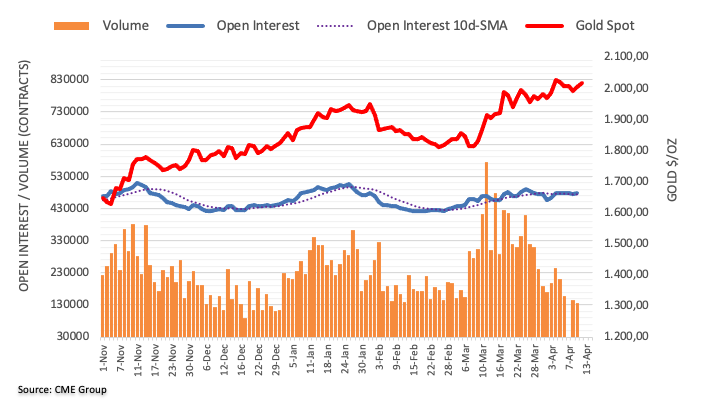
-
06:15
EUR/USD: Further range bound on the cards – UOB
Economist Lee Sue Ann and Market Strategist Quek Ser Leang at UOB Group suggest EUR/USD is likely to navigate within the 1.0820-1.090 range in the next few weeks.
Key Quotes
24-hour view: “We highlighted yesterday that ‘there is scope for EUR to retest the 1.0830 level before a more sustained rebound is likely’. We added, ‘breach of 1.0895 would suggest that 1.0830 is not coming back into view’. However, EUR did not retest 1.0830 as it rebounded from 1.0855 to 1.0927 before settling at 1.0910 (+0.47%). The rebound lacks momentum and EUR is unlikely to advance much further. Today, EUR is more likely to trade in a range of 1.0870/1.0940.”
Next 1-3 weeks: “Yesterday (11 Apr, spot at 1.0905), we noted that EUR ‘is under mild pressure’ and held the view that it ‘is likely to edge lower for the time being’. We did not anticipate the sharp rebound to 1.0927. While our ‘strong resistance’ level at 1.0940 is not yet breached; downward pressure has more or less fizzled out. In other words, instead of edging lower, EUR is more likely to trade in a range for now, expected to be between 1.0820/1.0980.”
-
06:10
AUD/USD marches towards 0.6700 on economic optimism, easy inflation signals from Fed officials
- AUD/USD picks up bids to renew intraday high, extends the previous day’s rebound from one-week low.
- Australian Treasurer Chalmers reject recession woes despite suggesting drastic economic slowdown, RBA’s Bullock fails to gain attention.
- China-linked optimism, Fed policymakers’ receding hawkish bias also propel Aussie prices.
- US CPI, FOMC Minutes will be crucial to watch for clear directions as RBA’s rate-hike pause prods AUD/USD bulls.
AUD/USD renews an intraday high around 0.6670 as receding fears of Aussie recession joins the easing hawkish bias of the Federal Reserve (Fed) officials during early Wednesday. Adding strength to the upside momentum could be the upbeat catalysts surrounding Australia’s biggest customer, namely China.
Recently, Australian Treasurer Jim Chalmers spoke in an interview with the Australian Broadcasting Corporation radio on Wednesday and turned down fears of recession. The policymakers said, “The country will avoid a recession but warned the economy will slow significantly.”
On the other hand, RBA Assistant Governor (Financial System) Michele Bullock highlights the importance of inflation in monetary policy decisions but failed to gain any attention as the AUD/USD pair remains firmer.
It should be noted that the IMF’s optimism surrounding China seems to also favor the AUD/USD bulls due to its trading ties with the dragon nation. That said, IMF's Asia-Pacific Chief Krishna Srinivasan said earlier in the day that China rebounded much faster than anticipated, per Bloomberg. On Tuesday, the IMF kept its growth estimations for China intact at 5.2% for 2023 and 4.5% for 2024.
Elsewhere, Minneapolis Fed President Neel Kashkari mentioned that he is less optimistic than the bond market on the speed of inflation's fall. However, Philadelphia Fed President Patrick Harker and New York Fed President John Williams previously signaled to ease inflation pressure and weighed on the market’s bets of the Fed’s 0.25% rate hike in May. With this, the CME’s FedWatch Tool suggests a 69.5% chance of the US central bank's hawkish action in the next monetary policy meeting versus 71.2% marked the previous day.
Against this backdrop, US Treasury bond yields grind higher and so do the S&P 500 Futures but the US Dollar Index (DXY) drops for the second consecutive day, down 0.08% intraday near 102.07 at the latest.
To sum up, AUD/USD cheers cautious optimism in the market, as well as economic optimism surrounding Australia and China. However, the quote’s further advances hinge on the US US Consumer Price Index (CPI) for March and the Minutes of the latest Federal Open Market Committee (FOMC) Monetary Policy Meeting. Should the US inflation defies downbeat expectations and the Fed Minutes signal hawkish discussions, the Aussie may recollect the RBA’s dovish move and can pare the latest gains.
Also read: US CPI Preview: US Dollar on the back foot and poised to fall further
Technical analysis
Although a one-month-old horizontal support zone restricts immediate AUD/USD downside bear 0.6625-20, recovery remains elusive unless it bounces back beyond the one-month-old previous support line, around 0.6700 by the press time.
-
06:06
USD/IDR surrenders 14,900 as Indonesian Retail Sales soar, US Inflation eyed
- USD/IDR has dropped below 14,900 after upbeat Indonesian Retail Sales data.
- Bank of Indonesia might reconsider its stable policy stance as Retail Sales have expanded by 0.6%.
- The downside bias for US Dollar has been strengthened after light inflation guidance from Fed policymakers.
The USD/IDR pair has slipped sharply below the crucial support of 14,900 in the Asian session. The asset has witnessed a steep fall amid the release of the bumper Indonesian Retail Sales data. The economic data has expanded by 0.6% against a contraction of 0.6% on an annual basis. Strong retail demand has bolstered inflation expectations, which could force the Bank of Indonesia (BI) to consider more rate hikes.
Meanwhile, S&P500 futures are struggling to find a decisive move as investors have sidelined ahead of the result season of the first quarter of CY2023, portraying a mixed market mood. Technology and banking stocks are expected to underperform amid higher interest rates and the recent banking crisis.
US Treasury Secretary Janet Yellen cited on Tuesday that the United States economy is critically strong as the banking sector is strong and resilient, inflationary pressures are softening consistently, and labor demand is rising. This conveys an anticipation of a decent performance from the S&P500 ahead.
The US Dollar Index (DXY) has slipped again to near day’s low at 102.04 and is expected to test the crucial support of 102.00. The downside bias for US Dollar has been strengthened after light inflation guidance from Federal Reserve (Fed) policymakers. Minneapolis Fed Bank President Neel Kashkari sees inflation at the middle 3% by end of this year, closer to 2% next year.
Demand for US government bonds has turned choppy as investors are looking to make informed positions after the release of the US inflation and Fed minutes. The 10-year US Treasury yields are hovering around 3.43%.
-
06:06
USD/MXN Price Analysis: Grinds within symmetrical triangle above 18.00
- USD/MXN struggles to extend two-day recovery inside one-week-old symmetrical triangle.
- Bearish moving average crossover, steady RSI line keeps Mexican Peso pair sellers hopeful.
- Five-week-long ascending trend line adds to the downside filters.
USD/MXN fades upside momentum within a one-week-long symmetrical triangle as it makes rounds to 18.17 during early Wednesday. In doing so, the Mexican Peso (MXN) pair prints mild losses, after rising in the last two consecutive days.
It’s worth noting, however, that the 100-SMA pierces off the 200-SMA from above and portrays a bearish crossover, which in turn joins steady RSI to suggest further downside of the USD/MXN price.
However, a clear downside break of the stated triangle’s lower line, close to 18.10 by the press time, becomes necessary to call the bears.
Following that, an upward-sloping support line from early March, around 18.00 by the press time, becomes crucial to watch as it holds the key to the USD/MXN pair’s likely south-run towards refreshing the yearly low, currently around 17.89.
Alternatively, recovery moves need to cross the top line of the aforementioned triangle, around 18.23 at the latest.
Even so, the 100-SMA and 200-SMA can challenge the USD/MXN bulls around 18.26 and 18.34 in that order.
Should the USD/MXN bulls keep the reins past 18.34, the monthly high of around 18.40 can act as the last defense of the bears.
Overall, USD/MXN remains sidelined within a short-term triangle but remains well on the bear’s radar.
USD/MXN: Four-hour chart

Trend: Further downside expected
-
05:28
USD/INR Price Analysis: Scales above 82.00 ahead of US Inflation and FOMC minutes
- USD/INR has continued its auction above 82.00 ahead of US Inflation data.
- FIIs are turning buyers in the Indian market after months of correction.
- Oil prices are expected to extend their upside above $81.50 on expectations that the Fed will reach its terminal rate sooner.
The USD/INR pair has delivered a flat opening above 82.00 and is expected to remain volatile as investors are awaiting the release of the United States inflation data and Federal Open Market Committee (FOMC) minutes for fresh impetus.
The US Dollar Index (DXY) has attempted a recovery after a steep correction to near 102.04 as investors are taking caution ahead of inflation data. Meanwhile, S&P500 futures have eased the majority of gains generated in early Asia amid anxiety ahead of the quarterly result season, portraying a caution in an overall upbeat market mood.
The Indian Rupee is also expected to show volatility as the annual result season is at the doorstep. Meanwhile, Foreign Institutional Investors (FIIs) are turning buyers in the Indian market after months of correction.
On the oil front, oil prices are expected to extend their upside above $81.50 on expectations that the Federal Reserve (Fed) will reach its terminal rate sooner.
After a firm recovery, USD/INR has reached near the upper portion of the Falling Channel formed on a four-hour scale. Every pullback in the aforementioned chart pattern is considered as buying opportunity for market participants. The 20-period Exponential Moving Average (EMA) at around 82.00 is providing a cushion to the US Dollar bulls.
Also, the Relative Strength Index (RSI) (14) is making efforts in climbing above the 60.00 level. An occurrence of the same will trigger the upside momentum.
Should the asset break above April 05 high at 82.20, US Dollar bulls will push the major toward April 03 high at 82.45 and March 22 high at 82.70.
Alternatively, a downside below April 07 low at 81.75 will drag the asset to March 06 low at 81.57 followed by January 06 low at 81.30.
USD/INR four-hour chart
-638168703794428805.png)
-
05:05
Australian Treasurer Chalmers: Economy will avoid recession but to slow significantly
Speaking in an interview with the Australian Broadcasting Corporation radio on Wednesday, Australian Treasurer Jim Chalmers said the country will avoid a recession but warned the economy will slow significantly.
Key quotes
“Australia will not be immune from global headwinds.”
"The situation in the world has become more complex and more challenging even over the course of the last few months, and so we won't be completely immune from that.”
"The treasury does expect our own economy to slow considerably later this year because of that combination of a slowing global economy and the impact of higher interest rates here at home as well."
"We need to lay the foundations for future growth in our economy, at the same time as we try and make ourselves more resilient to these sorts of international shocks.”
The International Monetary Fund (IMF) on Tuesday said in its outlook report, they expect Australia’s Gross Domestic Product (GDP) growth to fall to 1.6% in 2023 and 1.7% in 2024.
Market reaction
AUD/USD was last seen trading at 0.6665, still up 0.23% on the day, unfazed by the downbeat remarks from the Aussie Treasurer.
-
04:44
USD/JPY refreshes four-week high above 134.00 as USD Index defends 102.00 support ahead of US CPI
- USD/JPY has printed a fresh four-week high above 134.00 as investors have started turning cautious ahead of US inflation.
- US core inflation is expected to remain persistent amid robust demand for labor.
- Japanese firms are failing in hiking the prices of offerings amid weaker retail demand despite an increase in wage growth.
The USD/JPY pair has printed a fresh four-week high at 134.04 in the Asian session. The upside bias for the asset is the outcome of a recovery in the US Dollar Index (DXY) as investors have started turning anxious ahead of the release of the United States inflation data and the continuation of the Bank of Japan’s support to expansionary monetary policy.
The USD Index is attempting to defend testing of the 102.00 support as investors are routinely getting nervous ahead of US Consumer Price Index (CPI). The demand for US government bonds continues to remain choppy ahead of US inflation. The yields on 10-year US Treasury bonds are hovering around 3.43%.
Meanwhile, S&P500 futures have continued their sideways performance as investors are preferring a postponement of positions in equities ahead of the quarterly result season. Stock-specific action is highly likely in the S&P500 ahead.
Analysts at Wells Fargo expect, “After rising 0.4% in February, we look for the CPI to moderate to a 0.2% gain in March. With the initial surge in oil/gasoline prices stemming from Russia’s invasion of Ukraine a full year behind us, CPI when measured on a year-over-year basis should fall to 5.1% in March from 6.0% in February. However, another elevated reading in the core CPI is likely to indicate that the recent trend in inflation is little improved. Excluding food and energy, we look for the CPI to rise 0.4% and remain close to 5% on a three-month annualized basis.
On the Tokyo front, inflation expectations have been trimmed as the Producers Price Index (PPI) has been trimmed. Stagnant performance has been observed on a monthly basis as expected. While annual PPI softened further to 7.2% from the prior release of 8.0% but remained higher than the consensus of 7.1%. This conveys the inability of firms in hiking the prices of goods and services amid weaker retail demand despite an increase in wage growth.
-
04:29
GBP/USD Price Analysis: Pierces one-week-old resistance line in search of fresh 2023 high
- GBP/USD grinds higher after crossing one-week-long descending trend line, up for the second consecutive day.
- Looming bull cross on MACD, sustained trading above short-term key support line, 100-SMA favor Cable buyers.
- Bears need validation from 1.2180 to retake control.
GBP/USD prints mild gains around 1.2430 as traders await the week’s key catalysts headlines into Wednesday’s London open.
Also read: GBP/USD stays defensive above 1.2400, focus on US inflation, BoE’s Bailey and Fed Minutes
In doing so, the Cable pair struggles to cheer the recent upside break of the one-week-old descending trend line, now immediate support around 1.2415.
However, an impending bull cross on the MACD indicator joins the GBP/USD pair’s successful trading above 100-SMA and an upward-sloping trend line from March 24 keeps the buyers hopeful.
As a result, the bulls can ignore the latest inaction while keeping their eyes on the Year-To-Date (YTD) high of 1.2525, marked earlier in April.
Following that, the 1.2600 round figure and the May 2022 peak of around 1.2665 will be in focus.
Meanwhile, GBP/USD may witness intraday selling on a clear downside break of the nearby resistance-turned-support line of around 1.2415.
In that case, the three-week-old support line and the 100-SMA, respectively near 1.2370 and 1.2355, will be in focus.
It’s worth noting, however, that the GBP/USD bears should remain cautious until witnessing a daily closing below the one-month-long horizontal support zone surrounding 1.2200-2180.
Overall, GBP/USD remains on the bull’s radar even if the pre-data anxiety prods upside momentum of late.
GBP/USD: Four-hour chart
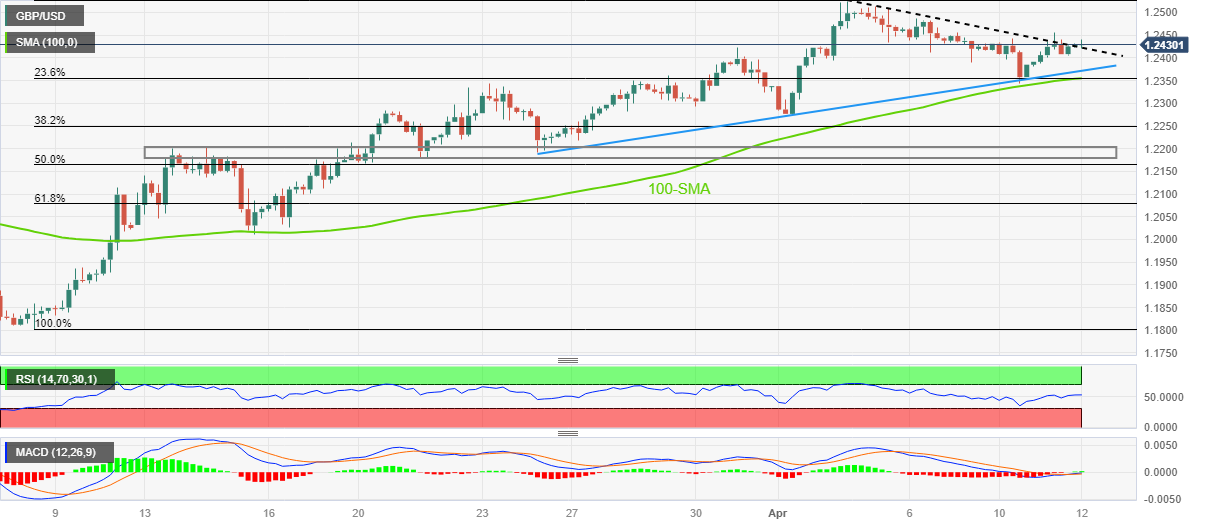
Trend: Further upside expected
-
04:11
EUR/USD eases from 1.0930 hurdle as Fed hawks retreat on inflation concerns
- EUR/USD pares the previous day’s rebound from one-week low, retreats from intraday high of late.
- Fed policymakers anticipate faster easing in inflation and trim hawkish bets.
- US Treasury bond yields fade upside momentum as recession woes ease, Euro growth chatters gain acceptance.
- Hawkish ECB talks, upbeat Eurozone data allow Euro buyers to remain firmer ahead of US CPI, Fed Minutes.
EUR/USD drops to 1.0915 as it consolidates the previous day’s rebound from a one-week low heading into Wednesday’s European session. In doing so, the Euro pair justifies the market’s cautious mood ahead of the key US Consumer Price Index (CPI) for March and the Minutes of the latest Federal Open Market Committee (FOMC) Monetary Policy Meeting. Also challenging the pair buyers could be the recent mixed comments from the Federal Reserve (Fed) and European Central Bank (ECB) policymakers.
That said, "Eurozone inflation is at risk of getting entrenched above 2% so the European Central Bank will keep fighting excessive price growth, even as its policy response is shifting gears," said French central bank chief Francois Villeroy de Galhau late Tuesday per Reuters.
On the other hand, Minneapolis Fed President Neel Kashkari teases US Dollar bulls as he said, “2% inflation target should not be changed.” It’s worth noting that Philadelphia Fed President Patrick Harker said that the Federal Reserve will continue to look closely at available data to determine what, if any, additional actions they may need to take. Before him, New York Fed President John Williams said that if inflation comes down, we will have to lower rates. Furthermore, Chicago Fed President Austan Goolsbee, said on Tuesday that they need to be cautious about raising interest rates after recent development in the banking sector.
Elsewhere, the US inflation expectations, as per the 10-year and 5-year breakeven inflation rates from the St. Louis Federal Reserve (FRED) data, remain firmer and challenge the EUR/USD bulls of late.
Even so, the optimism surrounding the Eurozone economy and upbeat EU data, backed by the comments from the International Monetary Fund (IMF) seem to propel the EUR/USD price ahead of the top-tier factors.
Against this backdrop, US Dollar Index (DXY) licks its wounds near 102.15 after snapping a four-day uptrend the previous day. However, S&P 500 Futures remain directionless around 4,138 after a mixed Wall Street close. Further, the US Treasury bond yields grind higher and prod the US Dollar sellers. That said, the US 10-year and two-year Treasury bond yields grind higher around 3.43% and 4.03 during a four-day and five-day uptrend respectively.
Looking forward, firmer prints of the US CPI and hawkish Fed Minutes are both necessary to portray the EUR/USD pullback. Until then, the pair buyers keep 1.1000-05 resistance on their wishlist.
Also read: US CPI Preview: US Dollar on the back foot and poised to fall further
Technical analysis
EUR/USD portrays a three-week-old rising wedge bearish chart pattern, currently between 1.0870 and 1.1005. Adding strength to the upside filter is the February 01 peak. Given the impending bear cross on the MACD and the quote’s multiple failures to remain firmer past 1.0930, the Euro bears seem to flex muscles of late.
-
03:46
Natural Gas Price Analysis: 21-DMA breakout keeps XNG/USD bulls hopeful near $2.35
- Natural Gas price justifies 21-DMA breakout to print three-day winning streak.
- Bullish MACD signals, sustained trading above 10-DMA also favors XNG/USD bulls.
- One-month-old horizontal resistance comprising 50-DMA appears a tough nut to crack for Natural Gas buyers.
Natural Gas (XNG/USD) clings to mild gains around $2.36 as bulls keep the reins during a three-day uptrend amid early Wednesday. In doing so, the XNG/USD buyers cheer a clear break of the 21-DMA around the highest levels in three weeks.
Not only the upside of the 21-DMA but bullish MACD signals and sustained trading beyond the 10-DMA also keep Natural Gas buyers hopeful.
That said, the late March swing high around $2.40 round figure lures intraday buyers of the XNG/USD. However, a convergence of multiple levels marked since early March and the 50-DMA, around $2.47-48, quickly followed by the $2.50 threshold, could challenge the energy instrument’s further upside.
In a case where the XNG/USD remains firmer past $2.48, the March 14 top surrounding $2.75 will be in focus.
Alternatively, Natural Gas sellers need validation from the 21-DMA support of $2.31 to revisit the 10-DMA support of around $2.25.
It’s worth noting, however, that the lows marked since late February highlight $2.13-12 as the key strong downside support for the XNG/USD bears to conquer if they wish to meet the early July 2020 high of near $1.95.
Overall, the Natural Gas price regains upside momentum but the room towards the north appears limited.
Natural Gas Price: Daily chart
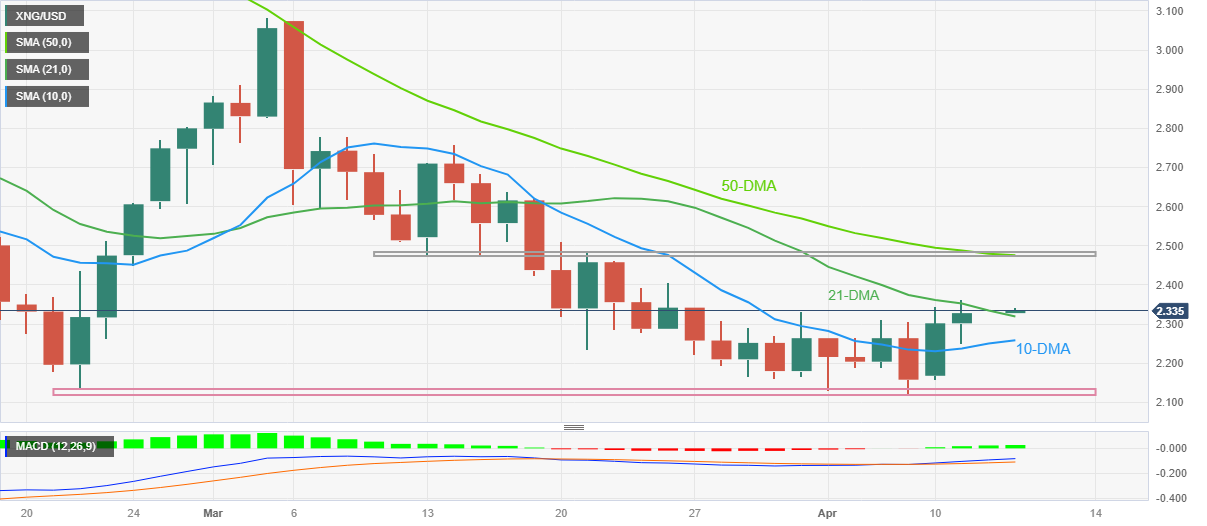
Trend: Further upside expected
-
03:27
USD/CNH ignores downbeat China yields to flirt with 6.8950, PBOC vs. Fed divergence, US inflation eyed
- USD/CNH remains sidelined at one-week high, prods two-day winning streak of late.
- China 10-year Treasury bond yields drop the lowest since November amid dovish bias about PBOC, recession woes elsewhere.
- Mixed Fed talks, easing hawkish bets on FOMC’s May 0.25% rate hike weigh on US Dollar.
- US CPI, Fed Minutes eyed for fresh impulse; talks of China growth also important to observe.
USD/CNH portrays the market’s indecision around 6.8950, despite easing to 6.8930 during early Wednesday. In doing so, the offshore Chinese Yuan (CNH) pair signals the cautious mood ahead of the US Consumer Price Index (CPI) for March and the Minutes of the latest Federal Open Market Committee (FOMC) Monetary Policy Meeting.
It’s worth noting that the recently downbeat China Treasury bond yields and comments from the International Monetary Fund (IMF) jostle with the broad US Dollar weakness to challenge the USD/CNH bulls after keeping the reins in the last two consecutive days.
China’s headline 10-year Treasury bond yields drop to the lowest levels since November 2022, to 2.815% by the press time, as traders brace for further easing from the People’s Bank of China (PBOC), especially after the previous day’s downbeat inflation. That said, China’s headline inflation numbers for March, namely the Consumer Price Index (CPI) and Producer Price Index (PPI), came in 0.7% YoY and -2.5% YoY versus 1.0% and -1.4% respective priors.
However, the IMF’s optimism surrounding the dragon nation and receding hawkish bias about the Fed’s next moves cap the USD/CNH pair’s upside. That said, IMF's Asia-Pacific Chief Krishna Srinivasan said earlier in the day that China rebounded much faster than anticipated, per Bloomberg. On Tuesday, the IMF kept its growth estimations for China intact at 5.2% for 2023 and 4.5% for 2024.
Elsewhere, hopes of easy inflation in the US could be witnessed in the latest Fed talks as President and CEO of the Federal Reserve Bank of Minneapolis Neel Kashkari teases US Dollar bulls as he said, “2% inflation target should not be changed.”
Previously, Philadelphia Fed President Patrick Harker said that the Federal Reserve will continue to look closely at available data to determine what, if any, additional actions they may need to take. Before him, New York Fed President John Williams said that if inflation comes down, we will have to lower rates. Furthermore, Chicago Fed President Austan Goolsbee, said on Tuesday that they need to be cautious about raising interest rates after recent development in the banking sector.
It should be noted, however, that the US inflation expectations, as per the 10-year and 5-year breakeven inflation rates from the St. Louis Federal Reserve (FRED) data, remain firmer and challenge the USD/CNH bears.
Amid these plays, S&P 500 Futures remain directionless around 4,138 after a mixed Wall Street close. Further, the US Treasury bond yields grind higher and prod the US Dollar sellers. That said, the US 10-year and two-year Treasury bond yields grind higher around 3.43% and 4.03 during a four-day and five-day uptrend respectively.
Looking ahead, firmer prints of the US CPI and hawkish Fed Minutes are both required to defend the USD/CNH bulls.
Technical analysis
A one-month-old ascending triangle bearish chart formation restricts USD/CNH moves between 6.9150 and 6.8865.
-
03:07
Gold Price Forecast: XAU/USD soars above $2,010 as Fed policymakers see quick US Inflation softening
- Gold price has climbed above $2,010.00 firmly as Fed policymakers are anticipating a quick deceleration in the US CPI.
- Fed minutes will be in focus as they will provide a detailed explanation behind the 25 bps rate hike in March.
- Gold price is marching towards the $2,032.00 resistance after sensing a stellar buying interest.
Gold price (XAU/USD) has shown a quick move above the critical resistance of $2,010.00 in the Asian session. The precious metal has jumped above $2,013.00 amid further weakness in the US Dollar Index (DXY). The USD Index has dropped to near 102.05 and is expected to rampant its downside journey. The downside bias for the USD Index is inspired by expectations of quick deceleration in the United States inflation as anticipated by Federal Reserve (Fed) policymakers.
Philadelphia Fed President Patrick Harker cited “I am keeping an eye on the data to see if more action on inflation is required.” Also, Minneapolis Fed Bank President Neel Kashkari sees inflation at the middle 3% by end of this year, closer to 2% next year.
Apart from them, Chicago Fed President Austan Goolsbee advocated a cautious approach as the combination of tight credit conditions and further restrictive monetary policy can hit sectors and regions differently than if monetary policy was acting on its own.
Wednesday’s US inflation data will be keenly watched as it carries significant value, being the last inflation data before the interest rate decision by the Fed scheduled in first week of May.
Also, Fed minutes will be in focus as they will provide a detailed explanation of hiking rates by 25 basis points (bps) in March.
The demand for US government bonds seems subdued ahead of US inflation data. The return offered on 10-year US Treasury bonds is juggling around 3.43%.
Gold technical analysis
Gold price is marching towards the horizontal resistance plotted from April 05 high at $2,032.00 after sensing a stellar buying interest near the breakout region of the Symmetrical Triangle chart pattern formed on a two-hour scale.
The 20-period Exponential Moving Average (EMA) at $2,004.14 is providing cushion to the Gold bulls.
The Relative Strength Index (RSI) (14) is on the verge of breaking into the bullish range of 60.00-80.00, which will activate the upside momentum.
Gold two-hour chart
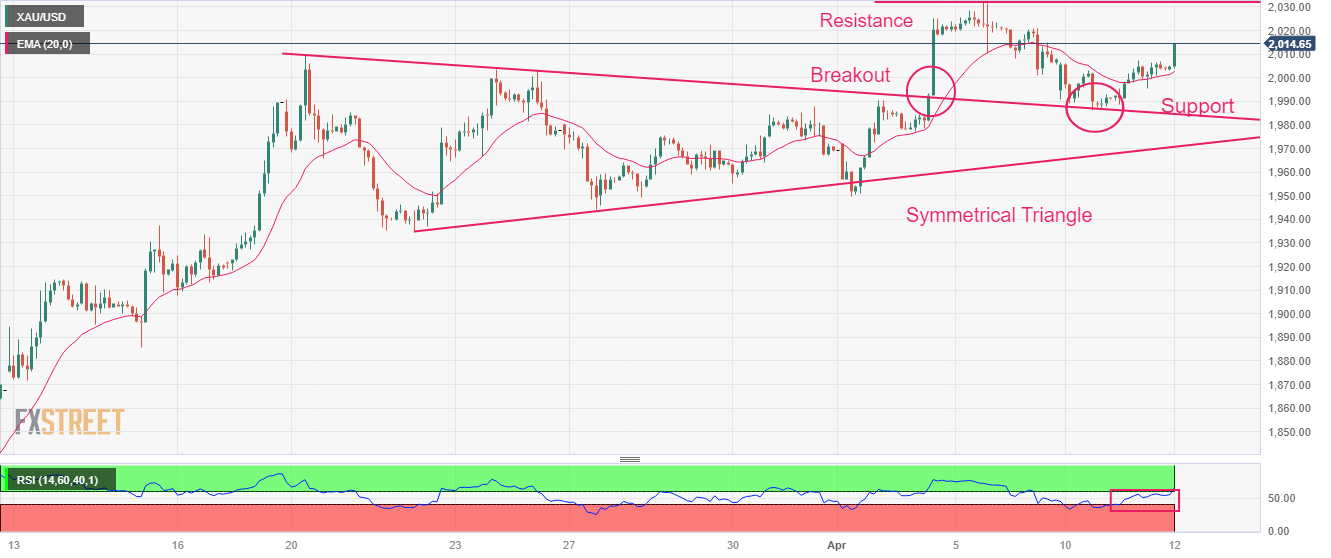
-
03:04
GBP/JPY Price Analysis: Bulls approach 166.50 key resistance
- GBP/JPY remains firmer around one-week high, up for the fifth consecutive day.
- Upside break of February’s high keeps buyers hopeful, two-week-old support line also restricts immediate declines.
- Six-week-old ascending trend line joins overbought RSI (14) to suggest limited room towards the north.
GBP/JPY buyers keep the reins for the fifth consecutive day as the cross-currency pair makes rounds to a one-week high surrounding 166.15-20 during early Wednesday.
The quote’s latest run-up could be linked to a successful upside break of February’s high, near 166.00, as well as the bullish MACD signals.
However, an upward-sloping resistance line from late February can challenge the GBP/JPY bulls around 166.50 amid the overbought RSI (14) conditions.
Should the pair crosses the 166.50 key resistance line, the last December’s high of around 169.30 and the 170.00 round figure can lure the GBP/USD bulls. Following that, the previous yearly high surrounding 172.15 will be in the spotlight.
On the flip side, a clear break of 166.00 can trigger an intraday fall of the GBP/JPY pair. However, a fortnight-old ascending trend line, near 164.85 by the press time, can restrict the quote’s further downside.
In a case where the GBP/JPY bears keep the reins past 164.85, the 200-SMA level of 162.85 becomes crucial to watch as it holds the key to the pair’s south-run towards a 2.5-month-long support line, close to 159.75 at the latest.
To sum up, GBP/JPY is likely to remain firmer even if the 166.50 challenges the quote’s immediate upside.
GBP/JPY: Four-hour chart
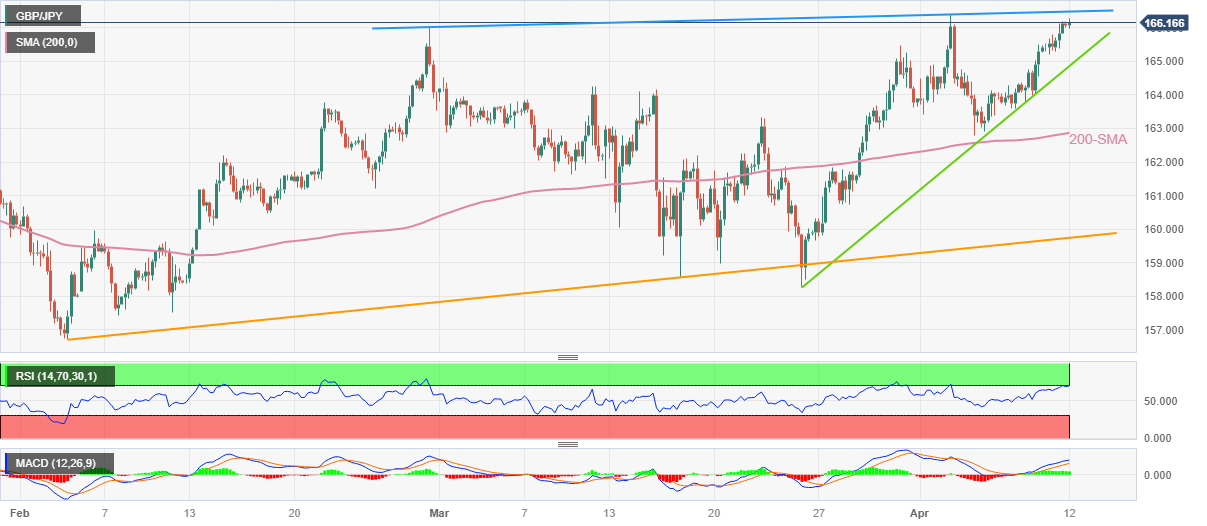
Trend: Pullback expected
-
02:55
USD/CAD Price Analysis: Bears are in control and target a break of daily lows
- USD/CAD bears are in the market and target the 1.3440-50s.
- A break below 1.3440 opens the risk to test 1.3400 prior lows and bearish extensions as per the weekly chart.
USD/CAD bears are taking out key structure in what could be the beginnings of a bearish extension for the days and weeks ahead as the following top-down analysis illustrates.
USD/CAD weekly chart
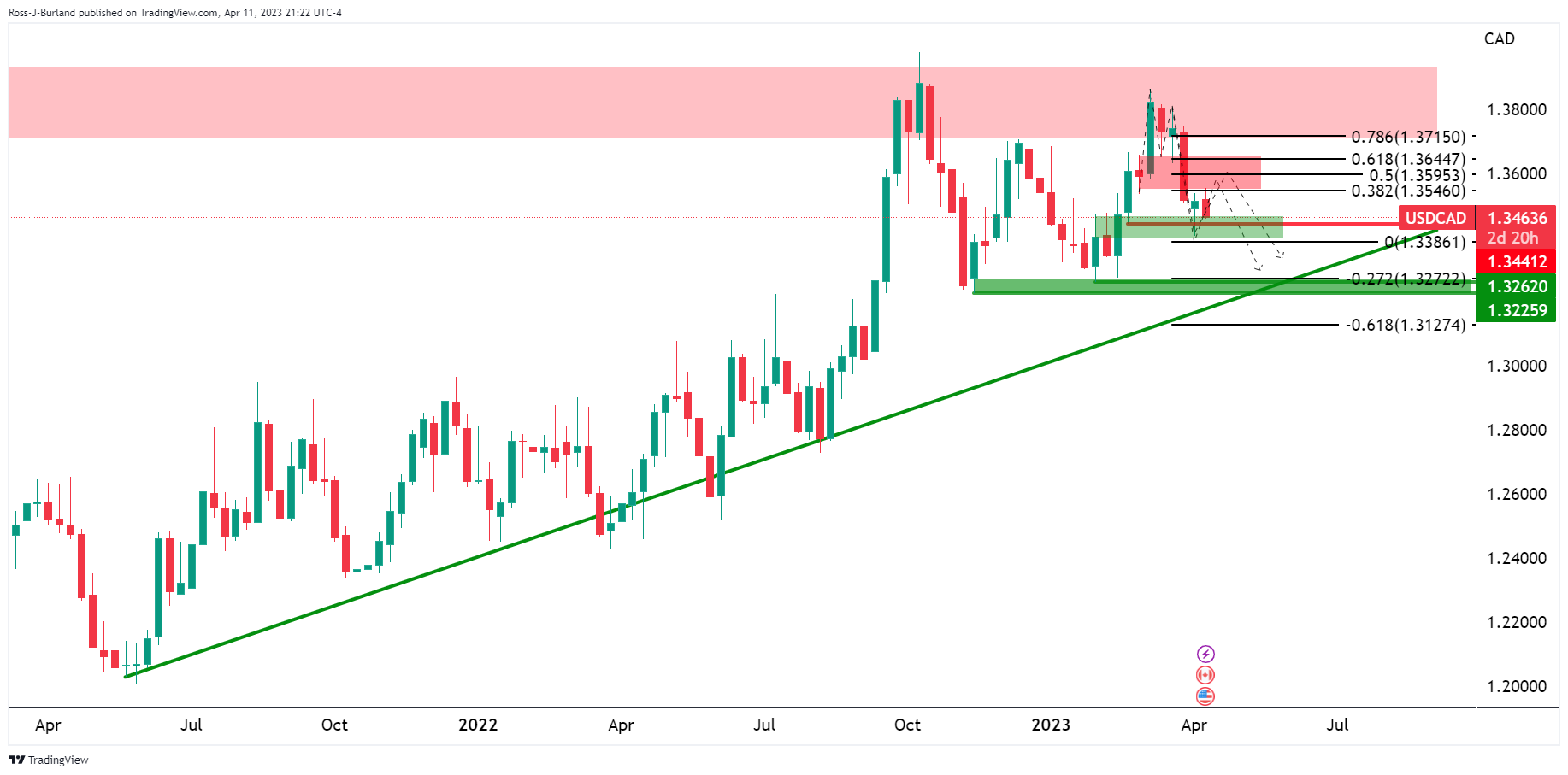
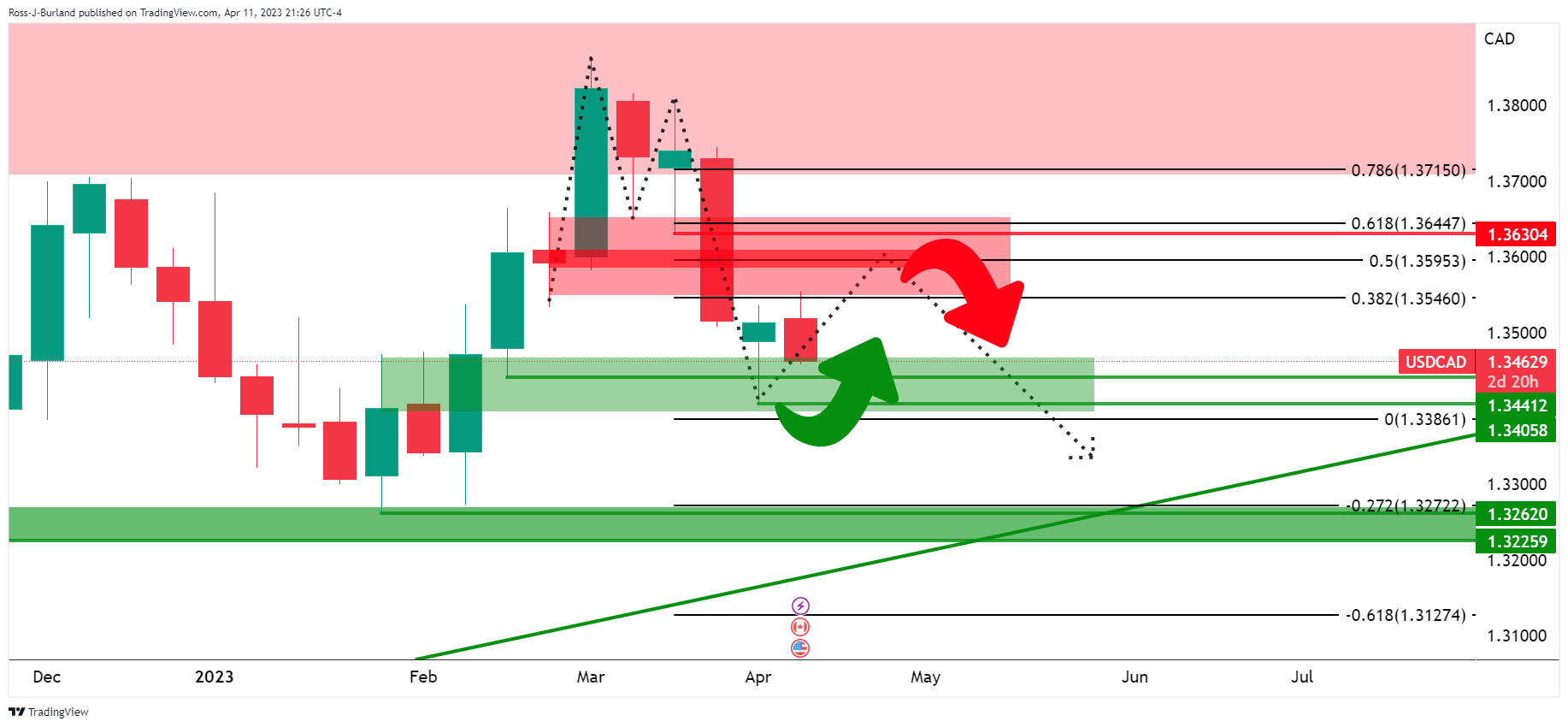
The M-formation is a reversion pattern but the bears are in control and the current candle is not going in the ´direction of the neckline for a restest. Instead, we could be in for a downside extension and a break of last week´s lows:

USD/CAD daily chart

The daily chart´s prior bearish impulse of six days of consecutive bear closes has seen a correction towards the 38.2% Fibonacci retracement of that bearish run/impulse. While a fuller test of the Fibo scale is more desirable, there is a significant possibility that the bears will stay the course and break below the recent lows for a bearish extension.
USD/CAD H4 charts
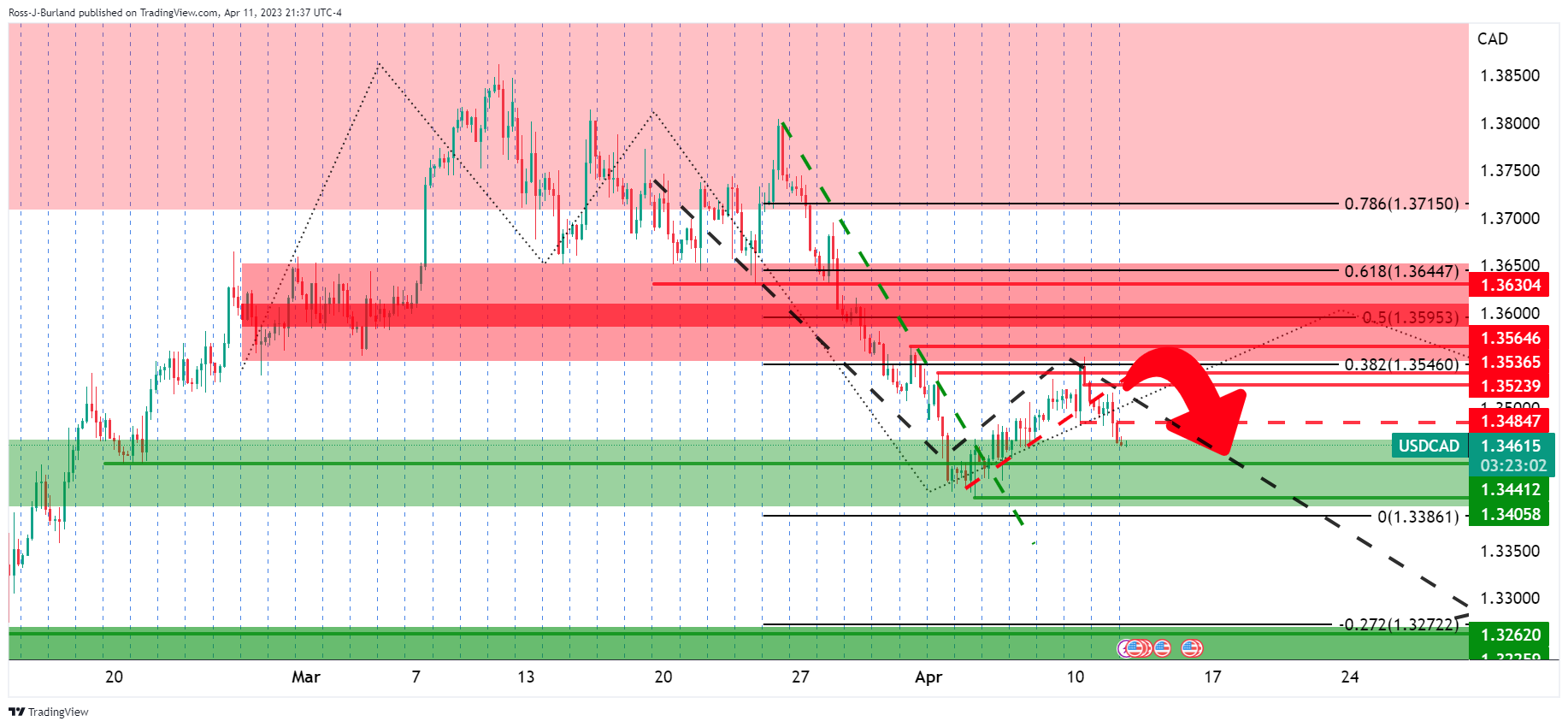
Let´s tidy this up:
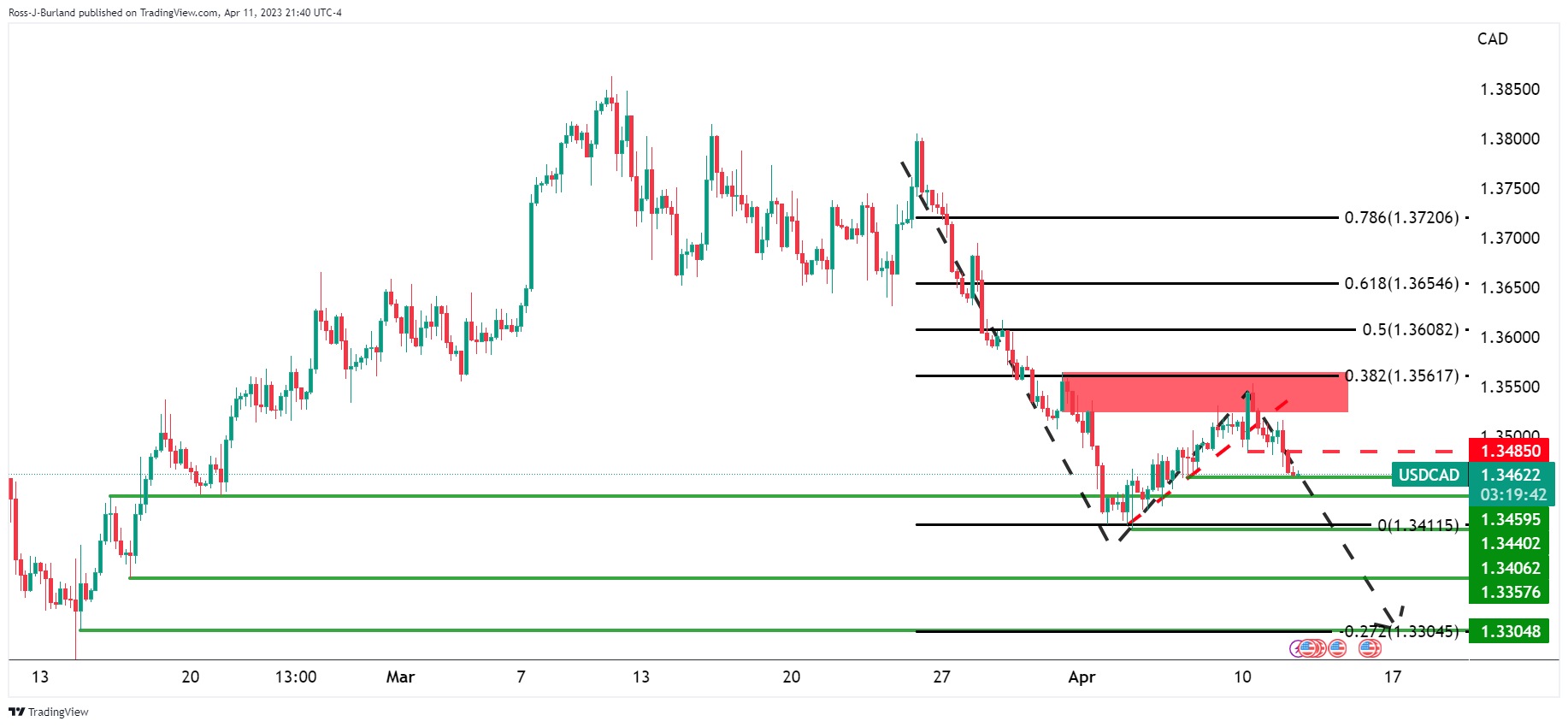
A slightly cleaner four-hour chart offers a better perspective of the market structure as above. The price was meeting resistance very close to the daily 38.2% Fibonacci as already mentioned and is now breaking 4-hour structure to the downside, as illustrated more clearly below:

The price is on the back side of the prior 4-hour bullish trend/correction, and the M-formation can be regarded as a topping pattern. The neckline of the pattern might act as resistance on a pullback and lead to a subsequent lower low to target the 1.3440-50s.
A break below 1.3440 opens the risk to test 1.3400 prior lows and bearish extensions as per the weekly chart, as illustrated at the beginning of this top-down analysis.
-
02:43
USD/CHF drops below 0.9030 as Fed expects decent softening of US Inflation in 2023
- USD/CHF has slipped below 0.9030 as Fed policymakers expect a quick softening of US Inflation.
- S&P500 futures are showing lackluster moves as investors are anxious ahead of the quarterly result season.
- Switzerland's parliament failed to approve the 109 billion Swiss francs of financial guarantees used to rescue Credit Suisse.
The USD/CHF pair has extended its downside below 0.9030 in the Asian session. The downside in the Swiss Franc asset has stretched as Federal Reserve (Fed) policymakers are anticipating a decent softening of the United States Consumer Price Index (CPI) this year.
This has weighed heavily on the US Dollar Index (DXY) as it is declining towards the crucial support of 102.00. The quick softening of US inflation has strengthened the odds of rate cuts by the Fed this year. The commentary from Minneapolis Fed Bank President Neel Kashkari that inflation will be at the middle 3% by end of this year, closer to 2% next year has weakened the appeal for the USD Index.
For current guidance, US inflation (March) data will be keenly watched. Analysts at NBF expect “The energy component may have had a negative impact on the headline index as prices likely fell in both the gasoline and natural gas segment. Expected gains for shelter and used vehicles could still result in a 0.2% monthly increase in headline prices. The core index, for its part, could have increased 0.4% MoM, which would translate into a one-tenth increase in the annual rate to 5.6%.”
Meanwhile, S&P500 futures are showing lackluster moves as investors are anxious ahead of the quarterly result season, portraying mildly positive market sentiment. The street is anticipating a contraction in overall profits to be reported by S&P500 amid higher interest rates and tight credit conditions by US commercial banks.
On the Swiss Franc front, Switzerland's parliament failed to approve the 109 billion Swiss francs ($120.5 billion) of financial guarantees used to rescue Credit Suisse last month, in a first-round vote that was largely symbolic given the state had committed the funds, as reported by Reuters. As Switzerland's upper house had already approved the rescue, the two chambers of the legislative body will vote again on Wednesday.
-
02:42
S&P 500 Futures, Treasury bond yields portray cautious optimism ahead of US inflation, Fed Minutes
- Market sentiment remains mildly positive even as challenges to risk appetite unearth of late.
- S&P 500 Futures snap two-day downtrend with minor gains, US Treasury bond yields pause recent rebound.
- Mixed Fed talks, upbeat US inflation expectations and geopolitical tension weigh on the risk profile.
- Easing hawkish Fed bets, hopes of improvement in growth prospects add strength to the upbeat mood.
Risk appetite remains mildly positive as traders discuss an imminent pause to the rate hike trajectory amid easing inflation woes. Adding strength to the optimism could be the recently mixed hawkish Fed bets. However, upbeat inflation expectations and geopolitical concerns prod the sentiment.
While portraying the mood, S&P 500 Futures remain directionless around 4,138 after a mixed Wall Street close. Further, the US Treasury bond yields grind higher and prod the US Dollar sellers. That said, the US 10-year and two-year Treasury bond yields grind higher around 3.43% and 4.03 during a four-day and five-day uptrend respectively. Elsewhere, the Chinese Treasury bond yields drop to the lowest in five months and allow traders to remain hopeful.
Recently, President and CEO of the Federal Reserve Bank of Minneapolis Neel Kashkari teases US Dollar bulls as he said, “2% inflation target should not be changed.”
However, other Fed policymakers have flagged mixed concerns of late and pushed back the Cable bears. Among them, Philadelphia Fed President Patrick Harker said that the Federal Reserve will continue to look closely at available data to determine what, if any, additional actions they may need to take. Before him, New York Fed President John Williams said that if inflation comes down, we will have to lower rates. Furthermore, Chicago Fed President Austan Goolsbee, said on Tuesday that they need to be cautious about raising interest rates after recent development in the banking sector.
It should be noted that the firmer US inflation expectations, as per the 10-year and 5-year breakeven inflation rates from the St. Louis Federal Reserve (FRED) data, also challenge the US Dollar bulls and the market optimists of late. That said, the 10-year and 5-year breakeven inflation rates from the St. Louis Federal Reserve (FRED) jumped to the highest levels since April 03 while renewing the weekly tops with 2.29% and 2.36% figures by the end of Tuesday’s North American session.
Elsewhere, the IMF revised down global real Gross Domestic Product (GDP) growth forecast for 2023 to 2.8% from 2.9% in January's report. However, the global lender defends the major central banks’ fight against inflation and defends the hawks, as well as the yields by teasing recession fears.
Moving on, the US Consumer Price Index (CPI) for March and the Minutes of the latest Federal Open Market Committee (FOMC) Monetary Policy Meeting will be crucial for the market players to watch as hawkish bets on the Fed’s 0.25% rate hike in May recede of late.
Also read: Forex Today: Dollar weakens before key US inflation data
-
02:26
WTI Price Analysis: Further upside hinges on $81.70-75 breakout
- WTI crude oil clings to mild gains as it jostles with short-term key upside barrier.
- 200-EMA, descending resistance line from early December 2022 prods Oil bulls.
- Nearly overbought RSI signals pullback but bears remain off the table beyond 100-EMA.
WTI crude oil grinds near $81.50-60 as markets turn dicey ahead of the US inflation data and Fed Minutes during early Wednesday.
Not only the pre-data anxiety but a convergence of the 200-bar Exponential Moving Average (EMA) and a downward-sloping trend line from December 2022, around $81.70-75 by the press time, also challenges the black gold buyers.
Furthermore, nearly overbought RSI (14) conditions add strength to the doubts about the commodity’s further advances.
However, the bullish MACD signals and the quote’s sustained trading beyond the 100-EMA, around $78.15 at the latest, push back the Oil bears.
Even if the commodity price drops below $78.15, multiple lows marked in February around $73.85 and $72.50 could challenge the WTI crude oil sellers before giving them control.
Meanwhile, a daily closing beyond the $81.75 hurdle won’t automatically approve the black gold’s rally as tops marked in January 2023 and the last December, respectively near $82.70 and $83.30, could check the Oil price advances afterward.
In a case where the quote remains firmer past $83.30, the odds of witnessing a run-up towards $90.00 and then to a November 2022 high near $92.95 can’t be ruled out.
Overall, WTI is likely to remain as the buyer’s favorite but the $81.70-75 hurdle appears a tough nut to crack for the Oil bulls.
WTI: Daily chart
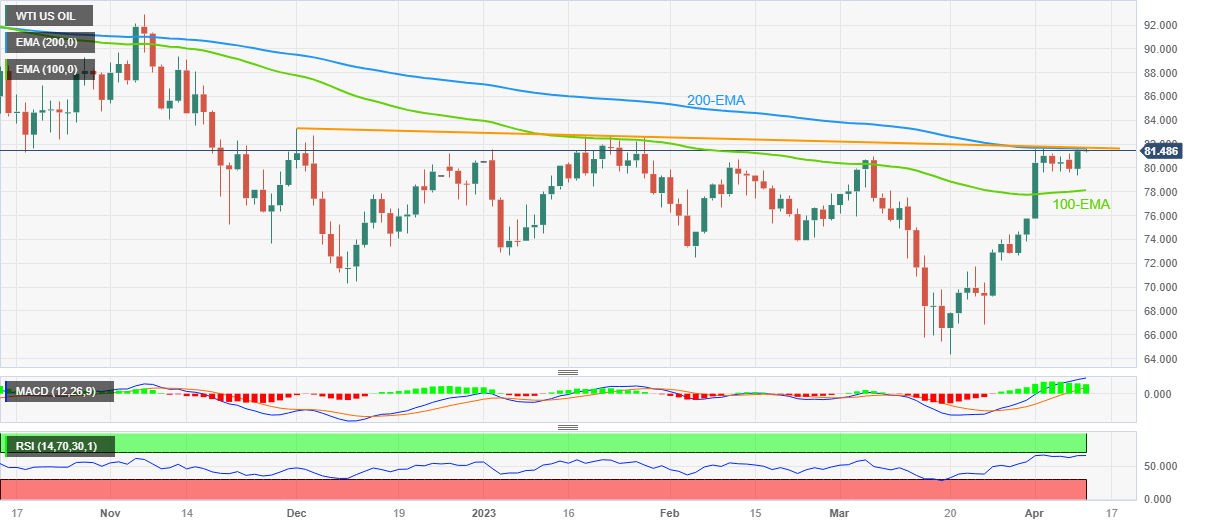
Trend: Further upside expected
-
02:16
USD/CNY fix: 6.8854 vs. the last close of 6.8855
In recent trade today, the People’s Bank of China (PBOC) set the yuan at 6.8854 vs. the last close of 6.8855.
About the fix
China maintains strict control of the yuan’s rate on the mainland.
The onshore yuan (CNY) differs from the offshore one (CNH) in trading restrictions, this last one is not as tightly controlled.
Each morning, the People’s Bank of China (PBOC) sets a so-called daily midpoint fix, based on the yuan’s previous day's closing level and quotations taken from the inter-bank dealer.
-
02:09
GBP/USD stays defensive above 1.2400, focus on US inflation, BoE’s Bailey and Fed Minutes
- GBP/USD struggles to extend the previous day’s rebound from one-week low, sidelined of late.
- Upbeat UK housing sales, workforce growth join mixed Fed talks to keep Cable buyers hopeful.
- IMF’s support to hawkish central bank actions, cautious mood ahead of US-UK Leaders’ Brexit talks in Northern Ireland prod bulls.
- US CPI for March, FOMC Minutes will be crucial amid receding hawkish bets on Fed’s May rate hike.
GBP/USD grinds near 1.2415-20 as bulls struggle to keep the reins during the early hours of the key Wednesday. In doing so, the Cable pair cheers broad US Dollar weakness, as well as upbeat UK fundamentals, while also portraying a cautious mood ahead of the US Consumer Price Index (CPI) for March and the Minutes of the latest Federal Open Market Committee (FOMC) Monetary Policy Meeting. Also important to watch is a speech from Bank of England (BoE) Governor Andrew Bailey.
That said, the latest headlines from Bloomberg suggest no more tight labor markets in Britain. “The number of people available to work in the UK rose for the first time in two years, easing one of the tightest labor markets in more than a generation, a survey compiled by S&P Global showed,” said the news.
On the same line, Reuters came out with the news suggesting upbeat UK housing prices and allowed the GBP/USD buyers to remain hopes ahead of the top-tier data events. “British homes sales recovered to within a whisker of pre-pandemic levels in March, representing a recovery from September when the failed economic plan of former prime minister Liz Truss sparked turmoil across markets, a survey showed on Wednesday,” reported Reuters.
Elsewhere, the latest comments from President and CEO of the Federal Reserve Bank of Minneapolis Neel Kashkari teases US Dollar bulls as he said, “2% inflation target should not be changed.” However, other Fed policymakers have flagged mixed concerns of late and pushed back the Cable bears. Among them, Philadelphia Fed President Patrick Harker said that the Federal Reserve will continue to look closely at available data to determine what, if any, additional actions they may need to take. Before him, New York Fed President John Williams said that if inflation comes down, we will have to lower rates. Furthermore, Chicago Fed President Austan Goolsbee, said on Tuesday that they need to be cautious about raising interest rates after recent development in the banking sector.
It should be observed that the IMF revised down global real Gross Domestic Product (GDP) growth forecast for 2023 to 2.8% from 2.9% in January's report. However, the global lender defends the major central banks’ fight against inflation and fails to offer any major signals for the GBP/USD pair traders.
Against this backdrop, S&P 500 Futures remain directionless after a mixed Wall Street close while the US Treasury bond yields grind higher and prod the US Dollar sellers.
Moving on, the market forecasts suggest the headlines CPI to ease to 5.2% YoY versus 6.0% prior while the FOMC Minutes need to defend the rate hike trajectory to stop the GBP/USD bulls. Also important to watch is the meeting between US President Joe Biden and UK Prime Minister (PM) Rishi Sunak in Northern Ireland (NI).
Technical analysis
Although a one-week-old descending resistance line restricts immediate GBP/USD upside near 1.2445, the Cable pair’s downside remains elusive unless it stays beyond an ascending support line from late March, close to 1.2370 by the press time.
-
02:01
AUD/USD Price Analysis: Breaks above 0.6660 as USD Index continues downside journey
- AUD/USD has climbed above 0.6660 amid further weakness in the USD Index.
- Fed’s Kashkari sees inflation at middle 3% by end of this year, closer to 2% next year.
- AUD/USD has delivered a breakdown of the Inverted Flag chart pattern.
The AUD/USD pair has delivered an upside break of a small consolidation above 0.6660 in the Asian session. The Aussie asset is getting traction as the US Dollar Index (DXY) has resumed its downside journey ahead of the release of the United States Consumer Price Index (CPI) data. The USD Index is likely to test the 102.00 cushion as investors are taking the release of US inflation casually.
S&P500 futures are holding nominal gains after a sideways Tuesday, portraying anxiety ahead of the quarterly result season. The demand for US government bonds has remained subdued as US inflation is expected to be a surprise for investors. The 10-year US Treasury yields is hovering around 3.43%.
Medium-term guidance on US inflation from Minneapolis Fed Bank President Neel Kashkari is weighing on the US Dollar. Fed policymaker sees inflation at middle 3% by end of this year, closer to 2% next year.
On the technical front, AUD/USD has delivered a breakdown of the Inverted Flag chart pattern formed on a four-hour scale. A breakdown of the Inverted Flag results in wider ticks and heavy volume towards the downside.
The 20-period Exponential Moving Average (EMA) at 0.6665 is acting as a barricade for the Aussie bulls.
Contrary to that, the Relative Strength Index (RSI) (14) has shifted into the 40.00-60.00 range from the bearish range of 20.00-40.00.
Going forward, more weakness will be observed on a breakdown of April 10 low at 0.6620, which will expose the Aussie asset to March 10 low at 0.6564 followed by the round-level support at 0.6500.
In an alternate scenario, a break above April 07 high at 0.6691 will drive the asset toward March 22 high at 0.6759. A breach above the latter would further drive the asset to April 03 high at 0.6693.
AUD/USD four-hour chart
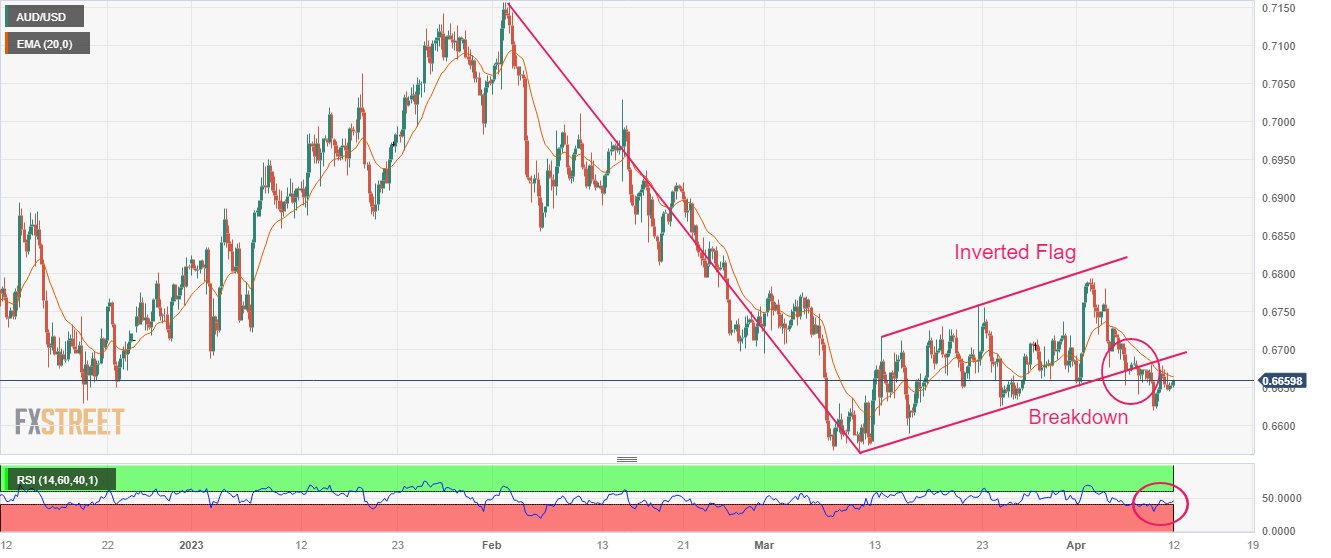
-
01:51
USD/JPY Price Analysis: Bulls eye a run to test 134.00 with eyes on US CPI
- USD/JPY hourly chart shows that the price could still correct deeper into support.
- Eyes on the 38.2% Fibo of the latest bullish impùlse aligned with the 133.50s.
- Bull looks to 134.00 for the near-term upside target.
USD/JPY is at 133.60, up from 133.26 as of Tuesday's Tokyo stock market close but flat on the day so far. Traders are focusing on the US consumer inflation due later in the day, but the technicals are pointed to the upside as the following top-down analysis illustrates.
USD/JPY weekly chart
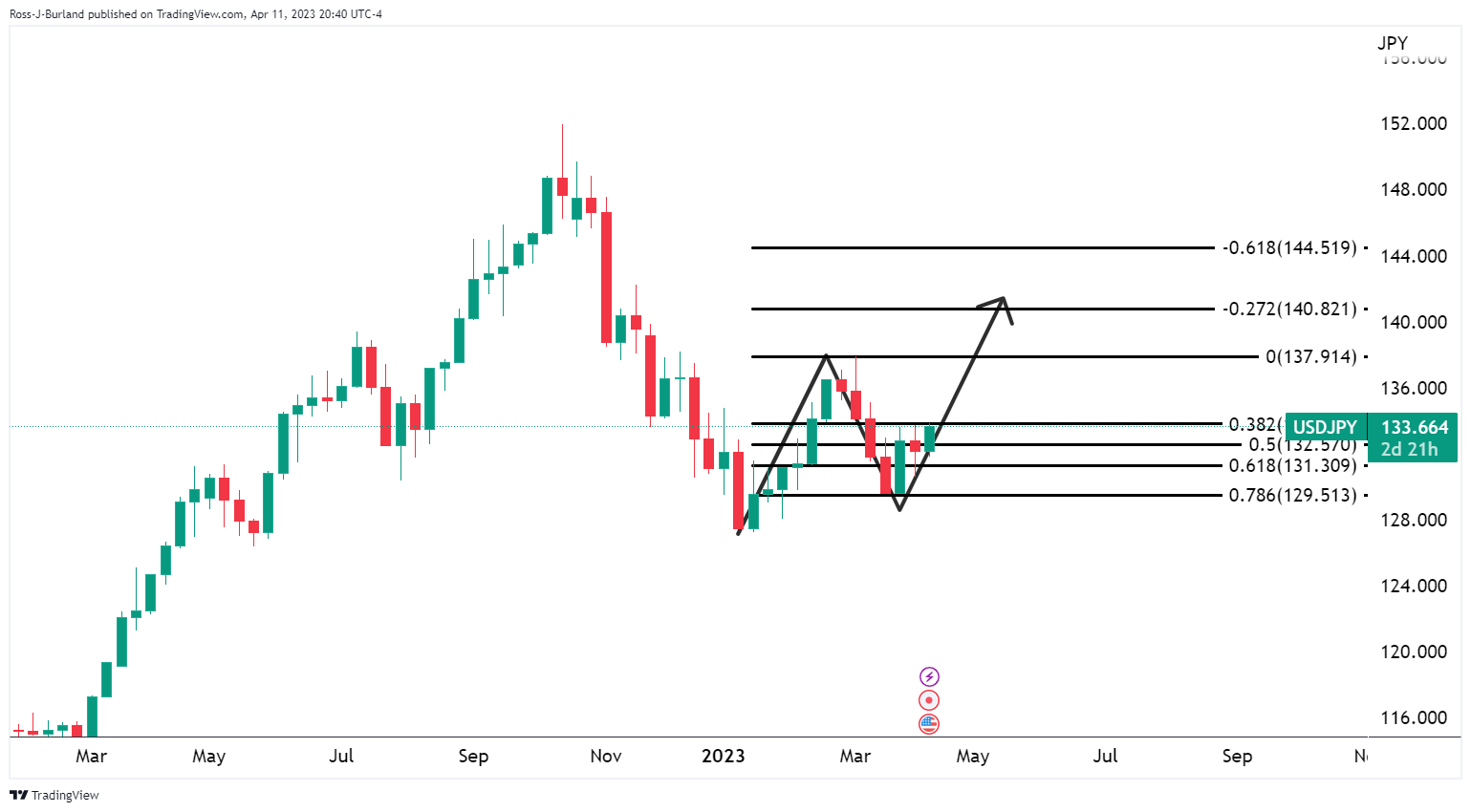
The weekly chart is showing that the price found support at a 78.6% Fibonacci retracement level of the prior weekly bullish impulse. This is bullish for the foreseeable future.
USD/JPY daily charts
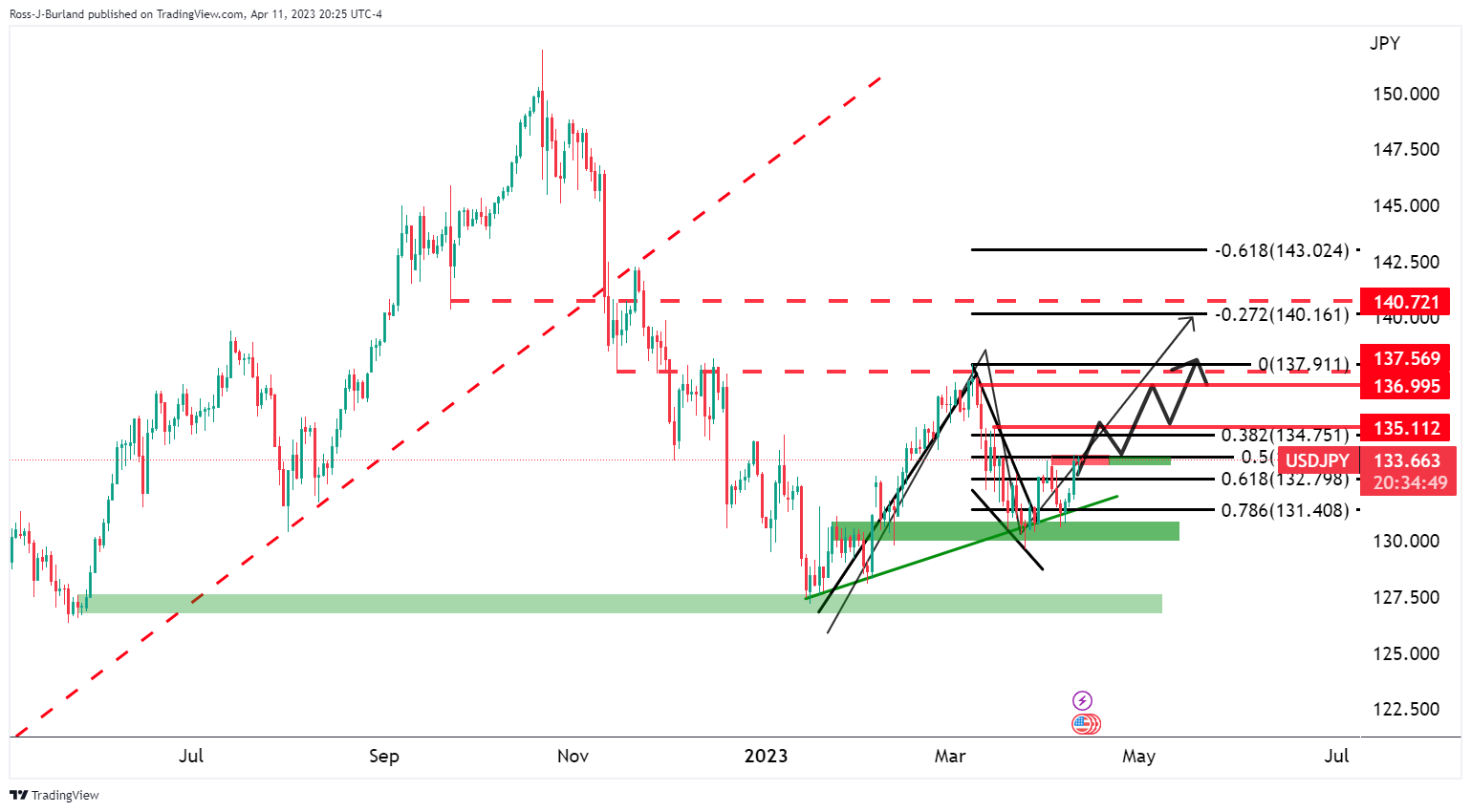
We can see that the price is trying to break out from the bear channel in what is a rather over-extended bull flag pattern, but nonetheless, the bulls are in control.
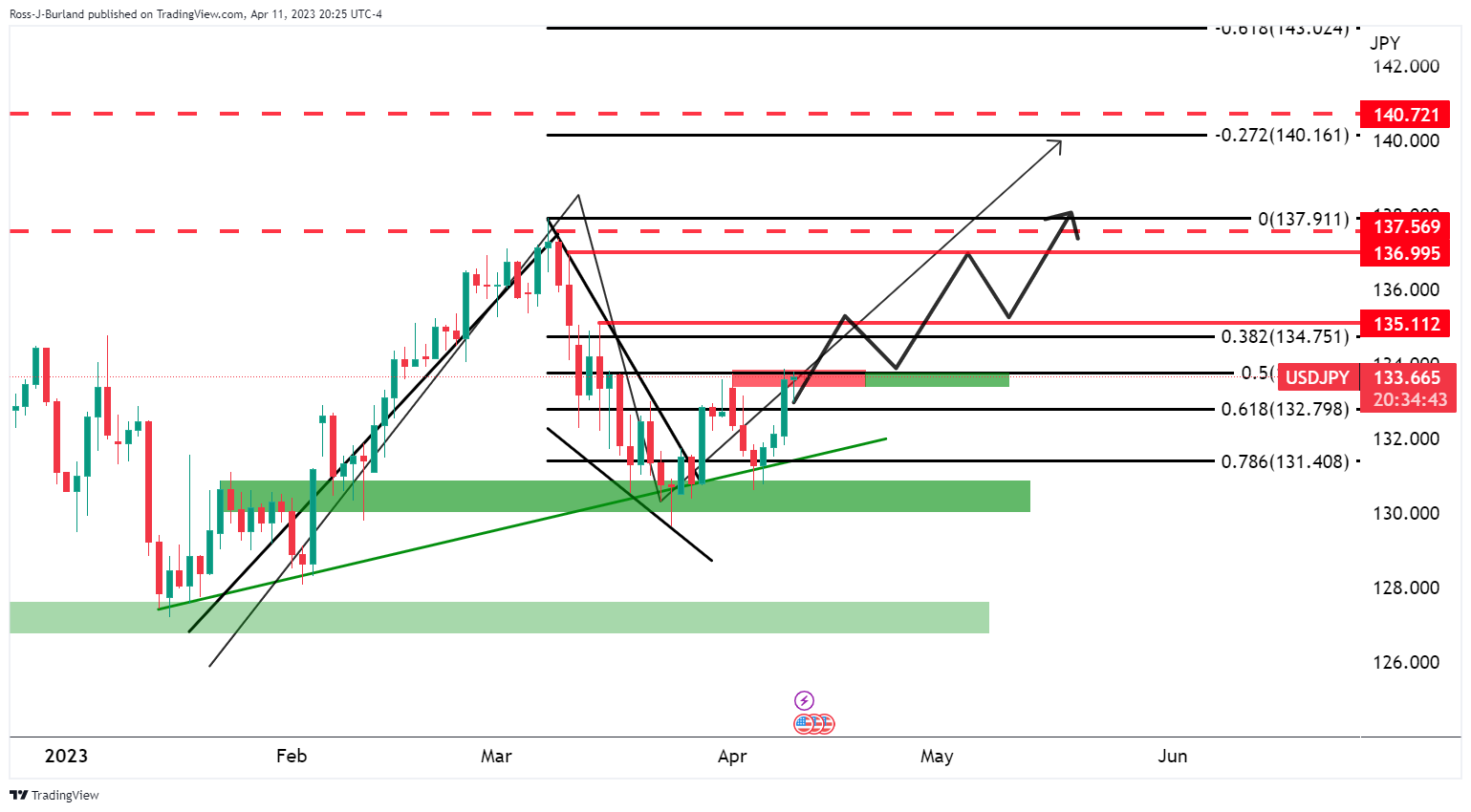
The price is testing resistance.
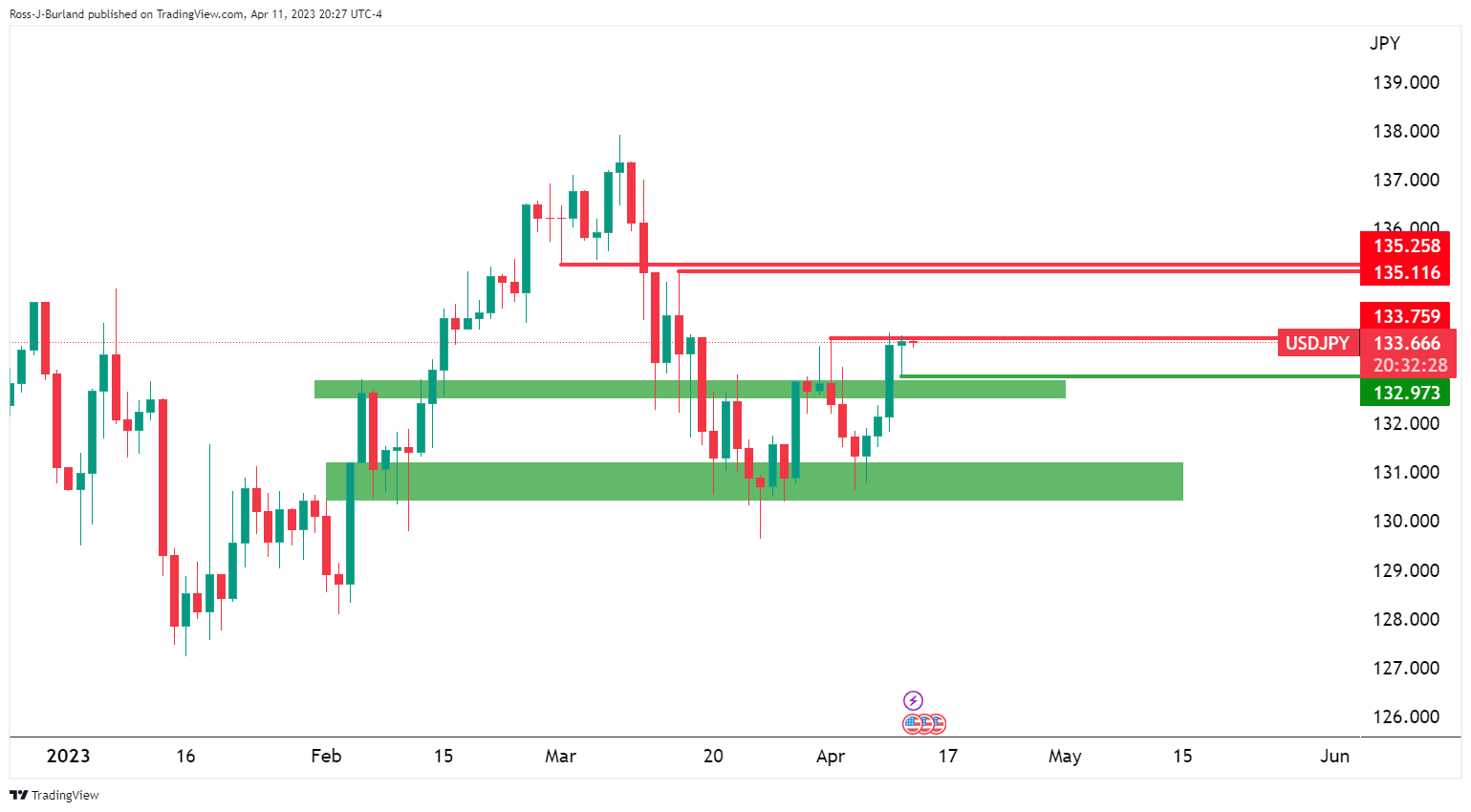
USD/JPY H4 chart
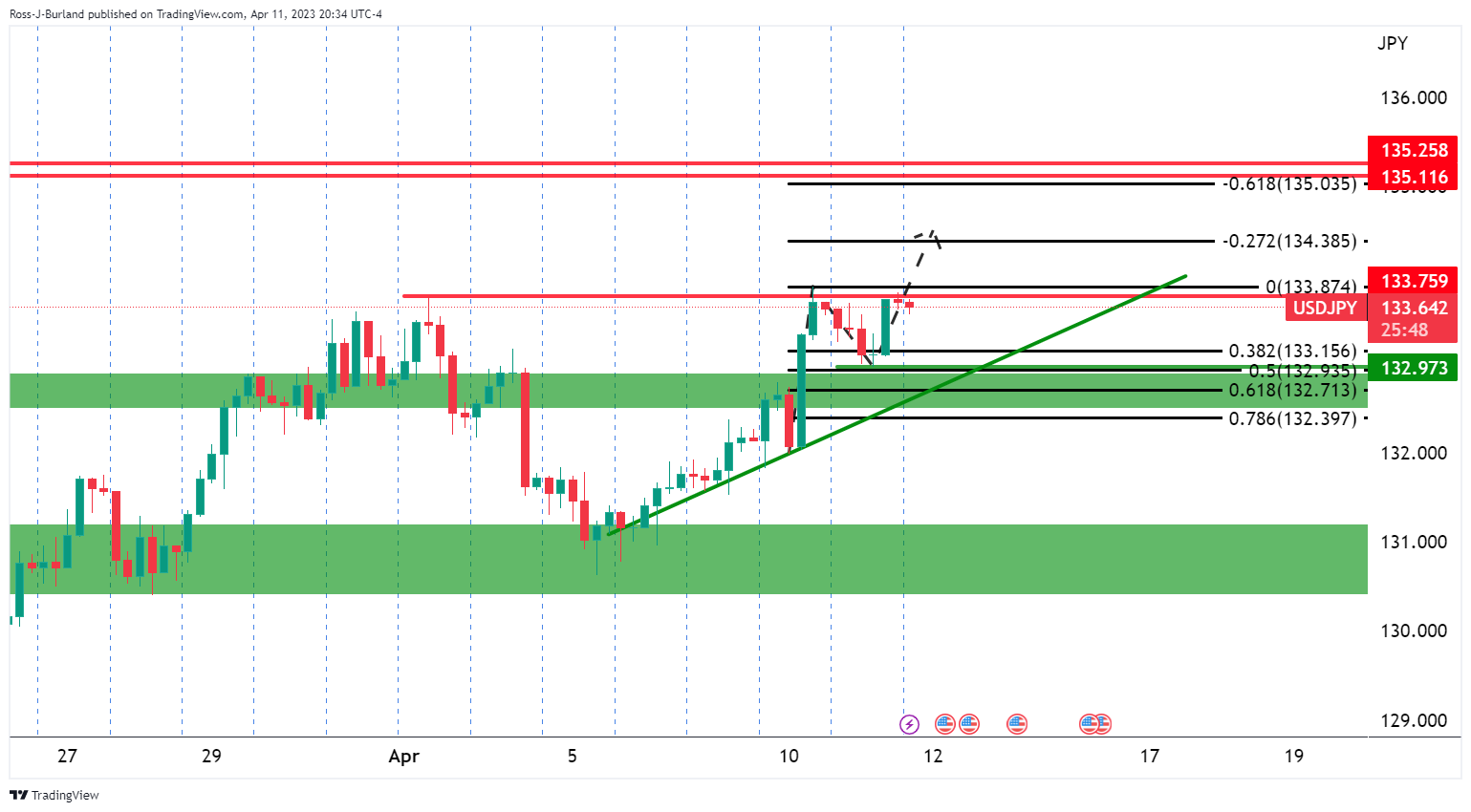
The 4-hour chart shows that the price is supported in a Fibo confluence as well and on the front side of the trend.
USD/JPY H1 chart
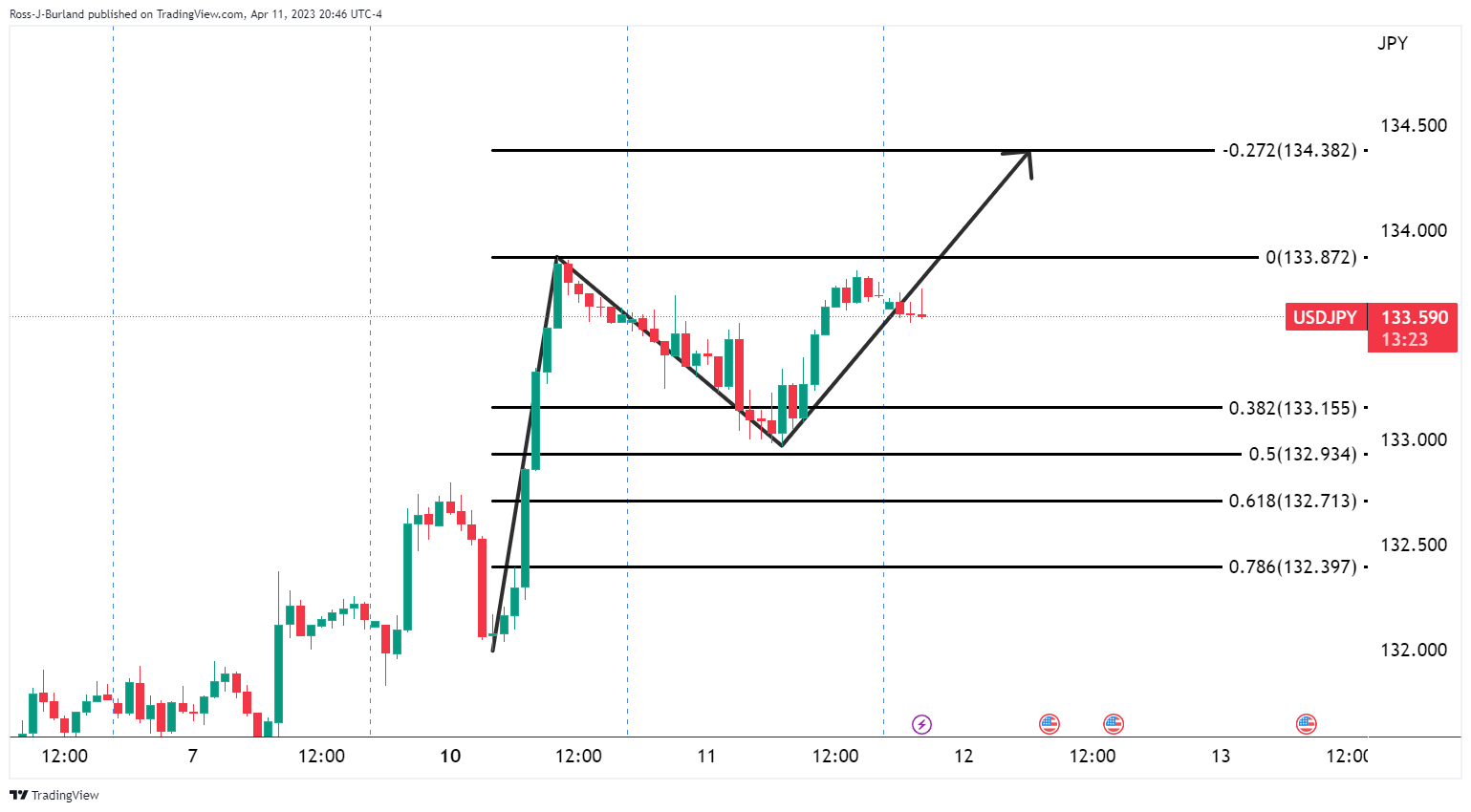
The price is meeting hourly near a 50% mean reversion and rallying from there towards an objective of 134.30-50.

The hourly chart also shows that the price could still correct deeper into support and where there is a 38.2% Fibo of the latest bullish impùlse aligned with the 133.50s, but eyes are on 134.00 for the near-term upside target.
-
01:39
US inflation expectations renew one-week high as market awaits US CPI
US inflation expectations, as per the 10-year and 5-year breakeven inflation rates from the St. Louis Federal Reserve (FRED) data, challenge the market’s previous risk-on mood by refreshing the weekly top. The inflation precursors become even more important as traders await the US Consumer Price Index (CPI) for March and the Minutes of the latest Federal Open Market Committee (FOMC) Monetary Policy Meeting on Wednesday.
Also read: US CPI Preview: US Dollar on the back foot and poised to fall further
That said, the 10-year and 5-year breakeven inflation rates from the St. Louis Federal Reserve (FRED) jumped to the highest levels since April 03 while renewing the weekly tops with 2.29% and 2.36% figures by the end of Tuesday’s North American session.
Not only the upbeat inflation signals, the latest comments from President and CEO of the Federal Reserve Bank of Minneapolis Neel Kashkari also teases US Dollar bulls as he said, “2% inflation target should not be changed.”
It’s worth noting, however, that other Fed policymakers have flagged mixed concerns of late and the CME’s FedWatch Tool also signals the easing hawkish bias for the US central bank’s 0.25% rate hike in May, which in turn weigh on the US Dollar of late.
Also read: US Dollar Index: DXY bears hold the reins near 102.00 ahead of US inflation, Fed Minutes
-
01:31
EUR/USD Price Analysis: Grinds higher past 1.0900 within rising wedge
- EUR/USD defends the latest bounce off a bearish chart formation’s lower line.
- Looming bear cross on MACD teases Euro pair sellers inside three-week-old rising wedge.
- Bulls need validation from 1.1000-05 to renew yearly high while 50-DMA acts as an extra filter towards the south.
EUR/USD clings to mild gains around 1.0915-20 during Wednesday’s sluggish Asian session as traders await the all-important US Consumer Price Index (CPI) for March and the Minutes of the latest Federal Open Market Committee (FOMC) Monetary Policy Meeting.
In doing so, the Euro pair keeps the previous day’s U-turn from the lower line of a three-week-old rising wedge bearish chart pattern.
However, the impending bear cross on the MACD and the quote’s multiple failures to remain firmer past 1.0900 teases EUR/USD sellers on a key day.
That said, the pair’s pullback needs to conquer the stated bearish pattern’s support line, around 1.0870 at the latest, to confirm the rising wedge breakdown and lure the sellers.
Following that, the 50-DMA support of near 1.0735 can act as an intermediate halt during the pair’s anticipated fall toward the theoretical target of around 1.0610.
On the contrary, the monthly high of 1.0973 can lure the EUR/USD bulls but the upside remains elusive unless crossing the 1.1000-05 resistance confluence, including the stated wedge’s top line and the February 01 peak.
Also acting as an upside filter is the Year-To-Date (YTD) high marked in February around 1.1035.
EUR/USD: Daily chart
-12042023-638168562770649624.png)
Trend: Pullback expected
-
01:21
AUD/JPY aims to recapture 89.00 ahead of Australian Employment data
- AUD/JPY is looking to recapture the immediate resistance of 89.00 as BoJ TO remain dovish ahead.
- Japanese officials are confident that wage growth is on track and but decelerating PPI is telling a different story.
- A release of higher-than-anticipated Australian Employment Change could renew fears of more rate hikes from the RBA.
The AUD/JPY pair is looking to seize back the critical resistance of 89.00 in the Asian session. The risk barometer is in a bullish trajectory for the past two trading sessions as novel Bank of Japan (BoJ) Governor Kazuo Ueda has advocated for an extension of the already decade-long ultra-loose monetary policy to achieve inflation steadily above 2%.
Japanese officials are confident that wage growth is on track and but decelerating Producer Price Index (PPI) is telling a different story. Monthly PPI (March) has not shown any move as expected by the market participants. While annual PPI has landed higher at 7.2% than the consensus of 7.1% but remained lower from the former release of 8.1%. Firms' inability to keep rates of goods and services accelerating at factory gates is a sign of weak demand from households.
Analysts at Commerzbank expect that the Japanese Yen is only likely to appreciate in the long term if there is this early move away from current monetary policy.
Over BoJ’s Yield Curve Control (YCC), IMF has commented that allowing more flexibility in YCC could have some repercussions for global markets although it could also help prevent abrupt policy changes later that could trigger large spillovers.
On the Australian Dollar front, investors are awaiting the release of the Employment data (March) for fresh impetus. The street is anticipating an addition of fresh 20K jobs in the Australian economy lower than the former release of 64.6K. While the Unemployment Rate is expected to increase to 3.6% vs. 3.5% released in February.
A release of higher-than-anticipated job additions could renew fears of more rate hikes from the Reserve Bank of Australia (RBA) as RBA Governor Philip Lowe left room open for more rate hikes in case Australian inflation remains persistent.
-
01:15
Currencies. Daily history for Tuesday, April 11, 2023
Pare Closed Change, % AUDUSD 0.66528 0.2 EURJPY 145.861 0.53 EURUSD 1.09123 0.47 GBPJPY 166.084 0.41 GBPUSD 1.24244 0.35 NZDUSD 0.61901 -0.49 USDCAD 1.34655 -0.3 USDCHF 0.90336 -0.65 USDJPY 133.663 0.05 -
01:04
Fed's Kashkari: 2% inflation target should not be changed
Neel Kashkari, President and CEO of the Federal Reserve Bank of Minneapolis is crossing the wires with the following key comments:
Key comments
I see inflation at middle 3% by end of this year, closer to 2% next year.
2% inflation target should not be changed.
I'm less optimistic than bond market on speed of inflation's fall. The united states is a long way away from a central bank digital currency.Meanwhile, the US Dollar index on Tuesday rose by +0.49% but there was some US Dollar weakness that was by sparked short covering in the Euro ahead of today´s key US event in the Consumer Price Index. Consumer price data on Wednesday is expected to show headline inflation rose by 0.2% in March, while core inflation rose 0.4%. The Federal Reserve is seen as likely to hike rates by an additional 25 basis points at its May 2-3 meeting, before pausing in June.
-
01:03
Gold Price Forecast: XAU/USD bulls await United States inflation, Federal Reserve Minutes for fresh rally
- Gold price grinds higher after snapping two-day downtrend the previous day.
- US Dollar fails to trace firmer United States Treasury bond yields and allow XAU/USD to remain up.
- Receding hawkish bias of Federal Reserve policymakers, easing best on 0.25% Fed rate hike in May propel Gold price.
- Headlines from International Monetary Policy test XAU/USD bulls ahead of US inflation, FOMC Minutes.
Gold price (XAU/USD) grinds higher past $2,000, mildly bid near $2,005 during early Wednesday in Asia. In doing so, the bright metal cheers a broad US Dollar weakness while also portraying the market’s cautious mood ahead of the top-tier data/events during a sluggish session. It’s worth noting, however, that the recent reduction in the hawkish Federal Reserve (Fed) bias joins mixed comments from the Fed policymakers and the International Monetary Fund (IMF) to weigh on the US Dollar and propel the Gold price.
Gold price rises as US Dollar retreats despite static United States Treasury bond yields
Gold price has an inverse relationship with the US Dollar Index, which in turn takes clues from the US Treasury bond yields and hence becomes crucial to watch for short-term Gold price directions.
US Dollar Index (DXY) holds lower grounds near 102.10 early Wednesday, following the U-turn from a one-week high, as well as snapping a four-day winning streak, the previous day. That said, the US 10-year and two-year Treasury bond yields grind higher around 3.43% and 4.03 during a four-day and five-day uptrend respectively.
As a result, the recently firmer US Treasury bond yields seem to prod the Gold price even if the US Dollar weakness puts a floor under the XAU/USD price.
Federal Reserve talks, interest rate futures prod USD bulls
While tracing the recent moves of the US Dollar, the United States Treasury bond yields and the Gold price, the mixed comments from the Federal Reserve (Fed) Officials and interest rate futures gain major attention.
On Tuesday, Philadelphia Fed President Patrick Harker said that the Federal Reserve will continue to look closely at available data to determine what, if any, additional actions they may need to take. Before him, New York Fed President John Williams said that if inflation comes down, we will have to lower rates. Furthermore, Chicago Fed President Austan Goolsbee, said on Tuesday that they need to be cautious about raising interest rates after recent development in the banking sector.
On the other hand, the CME’s FedWatch Tool signals a 64% chance of a 0.25% Fed rate hike in May versus 72.0% a day before.
Hence, the indecision among the Fed policymakers join the recently easy hawkish Fed bets to propel the Gold price ahead of the top-tier data/events.
China, IMF news tests XAU/USD buyers ahead of the key catalysts
While the aforementioned catalysts support the Gold price upside, headlines surrounding China and updates from the International Monetary Fund (IMF) prod the metal buyers.
That said, the IMF revised down global real Gross Domestic Product (GDP) growth forecast for 2023 to 2.8% from 2.9% in January's report. The global lender, however, forecasts 2023 US GDP growth at 1.6% vs 1.4% expected in January. “The International Monetary Fund warned on Tuesday that lurking financial system vulnerabilities could erupt into a new crisis and slam global growth this year, but urged member countries to keep tightening monetary policy to fight persistently high inflation,” said Reuters.
It should be noted, however, that the IMF kept its growth estimations for China intact at 5.2% for 2023 and 4.5% for 2024 while suggesting the faster-than-expected growth pace at the world’s largest industrial player, as well as one of the biggest Gold consumers.
Alternatively, the IMF’s support to the fight against inflation and fears of easy global growth, as well as the US-China tension, challenge the XAU/USD bulls amid dicey markets ahead of the US Consumer Price Index (CPI) for March and the Minutes of the latest Federal Open Market Committee (FOMC) Monetary Policy Meeting.
US inflation, Fed Minutes will be the key for Gold traders to watch
Gold price grinds higher as traders await United States inflation and the Fed Minutes amid expectations of further easy price pressure in the world’s largest economy likely pushing back the hawkish policy bias. That said, market forecasts suggest the headlines CPI to ease to 5.2% YoY versus 6.0% prior while the FOMC Minutes need to defend the rate hike trajectory to stop the Gold buyers from challenging the all-time high marked in 2020 around $2,075.
Also read: Gold Price Forecast: XAU/USD regains $2,000 despite a better market mood
Gold price technical analysis
Gold price grinds higher past the $1,981-80 support confluence comprising the three-week-old previous resistance line, 23.6% Fibonacci retracement of the March-April upside and the 100-bar Simple Moving Average (SMA).
In doing so, the XAU/USD justifies an upside break of a one-week-old descending trend line, now immediate support near $1,994.
Adding strength to the upside bias is the steady Relative Strength Index (RSI), placed at 14, and the receding strength of the bearish signals from the Moving Average Convergence and Divergence (MACD) indicator.
With this, the Gold price is well-set to challenge the 13-month high marked in the last week at around $2,032. Following that, the 61.8% Fibonacci Expansion (FE) of the metal’s moves between March 08 and 21, near $2,048, can act as an intermediate halt during the likely run-up towards the previous yearly peak close to $2,070 and then challenge the all-time high near $2,075 marked in 2020.
Alternatively, a downside break of the immediate support line near $1,994 may direct Gold sellers toward challenging the $1,981-80 support confluence.
It’s worth noting, however, that the XAU/USD weakness past $1,980 can quickly fetch the Gold price towards the 38.2% Fibonacci retracement level surrounding $1,947.
Overall, the Gold price is well set for the upside as traders await the key fundamental catalysts of the week.
Gold price: Four-hour chart
-12042023-638168545146117832.png)
Trend: Further upside expected
-
00:51
Japan Machinery Orders (YoY) came in at 9.8%, above forecasts (2.9%) in February
-
00:51
Japan Machinery Orders (MoM) came in at -4.5%, above forecasts (-7.8%) in February
-
00:50
Japan Bank Lending (YoY) below expectations (3.6%) in March: Actual (3%)
-
00:50
Japan Producer Price Index (MoM) meets expectations (0%) in March
-
00:50
Japan Producer Price Index (YoY) above forecasts (7.1%) in March: Actual (7.2%)
-
00:46
NZD/USD Price Analysis: Sets for a further breakdown below 0.6170
- A recovery attempted by NZD/USD looks less confident as investors are losing hope in China’s economic recovery.
- Investors should be prepared for sheer volatility ahead of the release of the US inflation data.
- A successful breakdown of the Rising Channel pattern has pushed the Kiwi asset into a bearish trajectory.
The NZD/USD pair has attempted a recovery move after printing a fresh two-week low near 0.6170. The recovery move by the New Zealand Dollar looks less confident as investors are losing hopes of economic recovery in China despite dismantling lockdown curbs by the administration.
The Chinese economy is in a disinflationary process despite the announcement of various stimulus to spurt the overall demand. On Tuesday, agencies reported a monthly deflation of 0.3% in the Chinese economy while the street was expecting an acceleration in prices of goods and services by 0.1%. Annual inflation slowed to 0.7% from the former release of 1.0%.
It is worth noting that New Zealand is one of the leading trading partners of China and weak demand in China would also impact the New Zealand Dollar.
Investors should be prepared for sheer volatility ahead of the release of the United States inflation data. Meanwhile, S&P500 futures have added some gains in early Asia after a rangebound Tuesday, indicating an improvement in market sentiment. The US Dollar Index (DXY) is likely to test the immediate cushion of 102.00.
A successful breakdown of the Rising Channel chart pattern on a four-hour scale has pushed the Kiwi asset into a bearish trajectory. The 20-period Exponential Moving Average (EMA) at 0.6229 is acting as a barricade for the New Zealand Dollar bulls. Potential horizontal support is plotted from March 08 low at 0.6084.
The Relative Strength Index (RSI) (14) has shifted into the bearish range of 20.00-40.00, which indicates that the downside momentum has been triggered.
More weakness will be witnessed if the Kiwi asset surrenders April 11 low near 0.6170, which will drag the major to March 15 low at 0.6139 followed by March 08 low at 0.6084.
Alternatively, a decisive upside move above February 07 high at 0.6363 will expose the Kiwi asset to the round-level resistance at 0.6400 and December 05 high at 0.6443.
NZD/USD four-hour chart
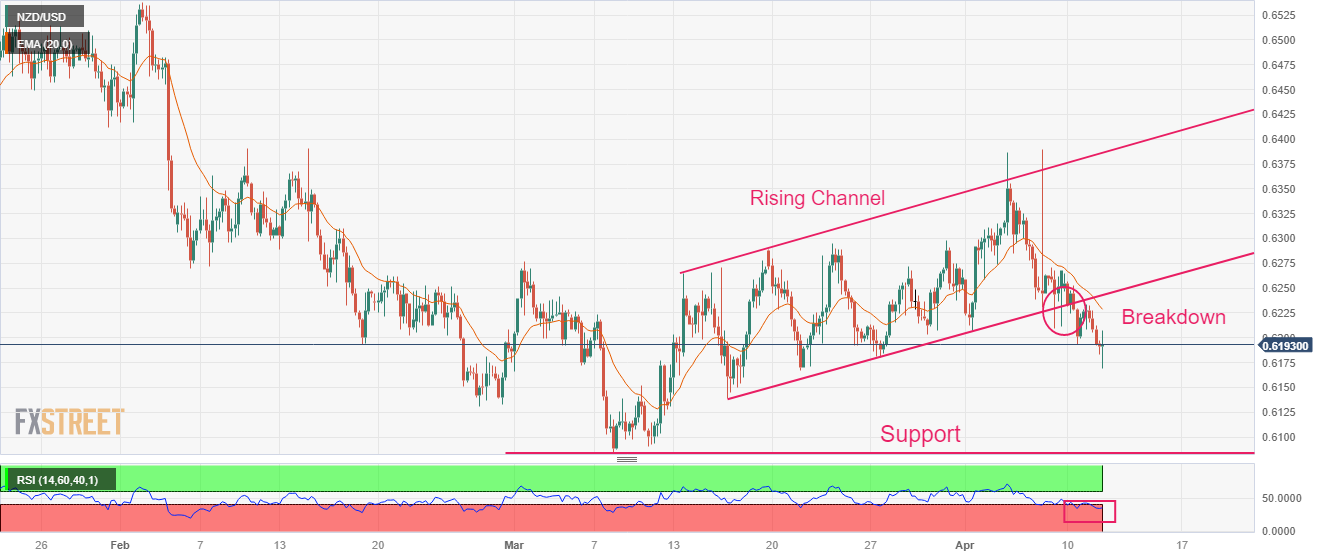
-
00:45
IMF: Allowing more flexibility in YCC could have some repercussions for global markets
Further to the earlier reports that the International Monetary Fund on Tuesday released its weakest global growth expectations for the medium term in more than 30 years, the IMF has been reported to say that ´´should Japanese long-term rates rise further, Japanese investors' repatriation of funds could affect sovereign bond yields in Australia, several euro area countries and in the US.
The Washington, D.C.-based institution said earlier that five years from now, global growth is expected to be around 3% — the lowest medium-term forecast in an IMF World Economic Outlook report since 1990.
In Asia, the IMF is commenting that allowing more flexibility in YCC could have some repercussions for global markets although it could also help prevent abrupt policy changes later that could trigger large spillovers.
-
00:37
US Dollar Index: DXY bears hold the reins near 102.00 ahead of US inflation, Fed Minutes
- US Dollar Index stays pressured after snapping four-day uptrend.
- Mixed Fed talks, anxiety ahead of key catalysts and cautious optimism weigh on DXY.
- US CPI for March, FOMC Minutes will be closely examined as policy pivot talks unearth.
US Dollar Index (DXY) holds lower grounds near 102.10 early Wednesday, following the U-turn from a one-week high, as well as snapping a four-day winning streak, the previous day. In doing so, the greenback’s gauge versus the six major currencies portrays the market’s anxiety ahead of the top-tier data/events amid mixed catalysts.
That said, the US Consumer Price Index (CPI) for March and the Minutes of the latest Federal Open Market Committee (FOMC) Monetary Policy Meeting are in the spotlight as markets struggle for hawkish Fed signals.
Mixed comments from the Federal Reserve (Fed) officials raised doubts about the US central bank’s hawkish moves even if the International Monetary Fund (IMF) backed the major central banks’ fight against inflation.
On Tuesday, Philadelphia Fed President Patrick Harker said that the Federal Reserve will continue to look closely at available data to determine what, if any, additional actions they may need to take. Before him, New York Fed President John Williams said that if inflation comes down, we will have to lower rates. Furthermore, Chicago Fed President Austan Goolsbee, said on Tuesday that they need to be cautious about raising interest rates after recent development in the banking sector.
On the other hand, the IMF revised down global real Gross Domestic Product (GDP) growth forecast for 2023 to 2.8% from 2.9% in January's report. The global lender, however, forecasts 2023 US GDP growth at 1.6% vs 1.4% expected in January. “The International Monetary Fund warned on Tuesday that lurking financial system vulnerabilities could erupt into a new crisis and slam global growth this year, but urged member countries to keep tightening monetary policy to fight persistently high inflation,” said Reuters.
Elsewhere, the US-China tension and recently mixed US data, before Friday’s upbeat US jobs report, act as extra trading filters for the DXY amid cautious optimism in the market.
While portraying the mood, Wall Street closed with minor gains and the yields also marked a mild run-up while the CME’s FedWatch Tool signals a 64% chance of a 0.25% Fed rate hike in May versus 72.0% a day before.
Looking ahead, the US CPI for March, expected to ease to 5.2% YoY versus 6.0% prior, may weigh on the DXY if the FOMC Minutes fail to defend the hawkish bias.
Also read: US CPI Preview: US Dollar on the back foot and poised to fall further
Technical analysis
US Dollar Index reverses from a convergence of a 13-day-old resistance line and 21-day Exponential Moving Average (EMA), around 102.65 by the press time, to keep DXY bears hopeful.
-
00:15
USD/CAD eyes more downside to 1.3450 ahead of US inflation and BoC policy
- USD/CAD is declining towards 1.3450 as the market mood is upbeat ahead of US inflation.
- BoC Macklem is expected to keep rates steady at 4.5% as Canada’s inflation is softening consistently.
- Fed policymakers are cautioning for considering more rate hikes ahead.
The USD/CAD pair is expected to see more weakness to near 1.3450 amid a cheerful market mood. Investors seem calm before the storm of United States inflation data as the Federal Reserve’s (Fed) terminal rate is around the corner. The Loonie asset is expected to remain in action as the Bank of Canada (BoC) will announce the interest rate decision ahead.
S&P500 futures have added nominal gains in early Asia after a choppy Tuesday, portraying further improvement in investors’ risk appetite. The US Dollar Index (DXY) has dropped after failing to extend its recovery above 102.30. The USD Index is likely to revert to its immediate support of 102.00 as Fed policymakers are cautioning about considering a more restrictive policy.
Chicago Fed President Austan Goolsbee has advised a cautious approach as the combination of tight credit conditions and further restrictive monetary policy can hit sectors and regions differently than if monetary policy was acting on its own.
Also, Philadelphia Fed President Patrick Harker cited “I am keeping an eye on the data to see if more action on inflation is required.” He further added, “It can take up to 18 months for the full impact of monetary policy actions to be felt.
Going forward, the release of the US inflation data will be the key event. Analysts at Commerzbank expect “Statisticians are likely to report a drop in the inflation rate from 6.0% in February to 5.3% in March. However, the March decline is entirely due to the fact that prices are now being compared with those in March 2022, when energy prices in particular had already risen significantly due to the Ukraine war. While core inflation is expected to increase from 5.5% to 5.7%”
On the Canadian Dollar front, BoC Governor Tiff Macklem is expected to keep rates steady at 4.5% as Canada’s inflation is softening consistently.
-
00:12
USD/CHF bears approach multi-month low near 0.9000 as US inflation, Fed Minutes loom
- USD/CHF remains pressured towards the lowest levels since June 2021 after falling the most in a week the previous day.
- Broad US Dollar weakness, cautious optimism in the markets keeps Swiss Franc pair on bear’s radar.
- US CPI for March, FOMC Minutes will be eyed closely amid recently mixed Fed talks.
USD/CHF slides to 0.9030 as bears keep the reins for the second consecutive day early Wednesday, after posting the biggest daily fall in a week the previous day. In doing so, the Swiss Franc (CHF) pair cheers the broad US Dollar weakness ahead of the key catalysts while declining towards the 22-month low marked the last week.
US Dollar Index (DXY) snapped a four-day uptrend to drop to 102.15 the previous day, around the same price by the press time, as mixed Federal Reserve (Fed) comments raised doubts on the US central bank’s hawkish moves as the US inflation data and Fed Minutes loom.
That said, Philadelphia Fed President Patrick Harker said on Tuesday that the Federal Reserve will continue to look closely at available data to determine what, if any, additional actions they may need to take. Before him, Federal Reserve (Fed) Bank of New York President John Williams said that if inflation comes down, we will have to lower rates. Furthermore, Chicago Fed President Austan Goolsbee, said on Tuesday that they need to be cautious about raising interest rates after recent development in the banking sector.
It’s worth noting, however, that comments from the International Monetary Fund (IMF) seem to prod the US Dollar as the global lender flags economic fears but supports the fight against inflation. “The International Monetary Fund warned on Tuesday that lurking financial system vulnerabilities could erupt into a new crisis and slam global growth this year, but urged member countries to keep tightening monetary policy to fight persistently high inflation,” said Reuters.
On Tuesday, the IMF revised down global real Gross Domestic Product (GDP) growth forecast for 2023 to 2.8% from 2.9% in January's report. "IMF forecasts 2023 US growth at 1.6% vs 1.4% in January; 2024 growth seen at 1.1%,” mentioned Reuters.
Against this backdrop, Wall Street closed with minor gains and the yields also marked a mild run-up while the CME’s FedWatch Tool signals a 64% chance of a 0.25% Fed rate hike in May versus 72.0% a day before.
Moving forward, USD/CHF may keep cheering the US Dollar weakness with eyes on the multi-month low. However, the pace of the fall may ease ahead of the US Consumer Price Index (CPI) for March and the Minutes of the latest Federal Open Market Committee (FOMC) Monetary Policy Meeting.
Technical analysis
Unless providing a successful break of a five-week-old descending resistance line, around 0.9085, the USD/CHF pair is well set to test the June 2021 low of around 0.8925.
-
00:00
South Korea Unemployment Rate in line with expectations (2.7%) in March
-